Traveling with Puppies in a Car: All you need to know [2023]

You’ve introduced a brand new puppy into your family and can’t wait to show them the world. We know the feeling! Not only is it all exciting for you, and your puppy, it’s important to get your puppy out into the world as soon as possible. This is especially important if your puppy is between 8 and 12 weeks old, known as the key socialisation period. This is when traveling with puppies is highly recommended. We will discuss this in detail below.
Traveling with puppies in a car an be quite a nerve wrecking experience, for many reasons. Firstly, a car can be a scary place for a new puppy, depending on your pup’s personality and confidence levels. The new environment, the sounds of the engine, and being in a moving vehicle can all be quite a lot for a puppy, so you want to prepare to ensure your puppy adapts well. On another note, traveling with puppies in a car can be a stressful experience for you or the driver! An energetic puppy in a moving vehicle can be quite dangerous.
Do not worry, in this article, we will talk you through the things you can do to ensure your puppy adapts well to rides in the car, as well as tips for a safe journey.
- Dogs in Cars: Laws from Around The World
- Dog Car Harness: Keeping Dogs in Cars Safe
- 13 Airlines That Allow Flying With Dogs In-Cabin [Prices & Policies]
- Dog Sedatives for Travel Anxiety: Should I use them?

Traveling with puppies during socialisation period (8-12 weeks)
Between the ages of 8 and 12 weeks, your puppy will be in it’s socialisation stage. Your puppy’s experiences during this critical period of learning and development can influence and shape their behaviour well into adulthood.
A well socialised puppy will find it easier to navigate life. You’ll be able to take them confidently along with you, knowing that they can cope with situations.
What is socialisation and why is it so important?
Puppies are brand new in the world, they haven’t yet learnt which situations are safe and which ones could be risky for them. From about the first three weeks to three months of life, they go through what’s known as the ‘socialisation period’. During this period they learn that everyday sights and sounds are a part of normal life and are not a threat to them. Introducing them to everyday scenarios, places, sights and sounds while they are young will help them feel relaxed into adult life.
Additionally, they need to learn when they could be in potential danger and what to do about it. At around 8 to 12 weeks old and again at around 6 months, puppies have short periods of what is called neophobia. This means, ‘fear of new things’ and it plays a big part in how puppies and dogs keep themselves safe. Negative experiences during this key period can have a big impact on how a puppy views the world and his sense of security.
Traveling with puppies when they are young is recommended, to provide a wide range of positive experiences for your them. During the key socialisation period you will want to introduce your puppy to as many every day things as possible. This includes car rides, busy train stations and train journeys, buses, busy roads among many more environments and situations. If your puppy is introduced to these things early on in life, they are far more likely to be confident with them throughout their lifetimes.
Of course, you and your dog may come across situations that you could never have practiced during their early months, however if you have a well travelled puppy, they’re more likely to accept and be confident in new experiences too.
Traveling with puppies in a car
How to teach your puppy to ride in the car
The key to traveling with puppies in a car is to make them feel comfortable and confident. The more comfortable and confident they are, the less stressed they’ll be. As mentioned above, the sooner you travel with your puppy in a car, the better. Ideally, you want your puppy to get used to your car as soon as you bring them home.
1. Introduce your puppy gradually to the car
Start by introducing your puppy to a stationary car. Allow your puppy to explore their pen or area they will be traveling in. The key is taking baby steps – you want your pup to feel confident and calm in the car, before starting the engine. You can even give them a couple treats so they have positive associations to the car. Once your puppy seems content, move on to the next step.
2. Make sure they have a firm footing under their paws, and a form of restraint
Ensure your puppy is safe in the car before you set off on your first ride. In some countries, there are actually laws in place that require puppies and dogs to be restrained in moving vehicles, with the use of dog seat belts or dog car harnesses . Even if it isn’t law in your country, using a dog seat belt or dog car harness when traveling with puppies in a car is safer for both you and your puppy. Of course, your puppy will be secured in place if you have to take a sharp turn or make a sudden stop. However, it’s also much safer for the driver, and everyone else on the road, as a free-roaming puppy can be rather distracting!
3. Take your puppy on a short, slow trip in the car Start of with short journeys – take your puppy for a drive around the block. Make sure you use lots of praise and treats at the end of the journey for riding quietly in the car.
4. Slowly increase the length of your trips
As your puppy gains more confidence and seems happy in the car, you can increase the length and frequency of your trips. Be patient, use lots of praise and treats, and you should see progress pretty quickly.
Remember to be patient and aim for gradual progress. It shouldn’t be long before your puppy is familiar with the car and knows what to expect when they jump in and hear the engine starting.
Motion sickness when traveling with puppies in a car
Car sickness in puppies is very common although most dogs do grow out of it. The key to preventing and overcoming car sickness in puppies is patience and gradual progress. Follow the steps mentioned above, and introduce your puppy to the car gradually. The more comfortable and confident they are in the car, the less likely they are to experience motion sickness.
If your new puppy does seem to get queasy in cars, it’s a good idea to put some waterproof sheeting down where they tend to sit or lie. Just in case they are sick, it is handy to carry lots of paper towels.
Additionally, puppies with full bellies are more likely to be sick. For this reason, if you are setting off on a long journey, it’s best not to feed your puppy for two to three hours before you set off, as a precaution.
You should always give your puppy a chance to go to the toilet before you set off, so they’re not anxious about having an accident. They’ll be much more relaxed with an empty bladder.
If your puppy seems to be struggling badly with motion sickness, ask your vet for their advice.
Keeping your puppy safe in the car
Dog car safety isn’t just about about keeping your puppy protected, it’s about taking care of the driver, passengers and other drivers on the road too.
Take time to train your puppy to be calm and quiet in the car, using the steps listed above, so they aren’t a distraction in the car.
Restrain your puppy
When traveling with puppies in a car, a restrained puppy will be less of a distraction to the driver and other passengers. In fact, in some countries it is actually law that dogs are restrained when in a moving vehicle.
If your puppy will be sitting in the foot well or boot of the car, it’s best to use a crate or dog barrier to keep them safely contained. This will not only prevent them from jumping around the car being a nuisance, it will protect them from potential injury. Restraining a puppy is safer for them as it prevents them from flying around the vehicle if the driver has to suddenly stop or turn a sharp corner.
If it isn’t possible to have your puppy in the boot, and your only option is to have your puppy sitting on a car seat, it’s important to use a dog car harness . Harnesses are like dog seat belts; they come in different sizes and attach onto ordinary car safety belts. If your puppy is particularly small and isn’t used to wearing harnesses, take some time to get him or her used to wearing one at home first. You don’t want to give your puppy extra reason to get stressed in the car. Ensure you give your puppy lots of praise and treats for wearing it, before you use it for real on your journey.
- Dogs in Cars: Laws from Around The World
Don’t let your puppy travel in the car with the head out the window
Although it looks like great fun, and probably is, it’s not safe for your puppy. The strong flow of air could irritate your puppy’s eyes, or even worse they could get injured by something you drive past. Of course, there’s also the risk that they could slip out of their harness and jump out of the window! I know we’d like to think that our puppies wouldn’t be that silly but when they are young they haven’t yet learnt what is safe and what isn’t.
If you are traveling with puppies on a particularly hot day of course it’s good to let some fresh air in. You can even use a window guard that lets you open the window more without allowing your puppy the chance to jump out.
Include frequent breaks for long car journeys
If you’re traveling with puppies in a car long distance, it’s a good idea to stop at least every couple of hours. Particularly if you are traveling with a very young puppy, as they haven’t yet developed strong bladders. You’ll probably both appreciate a toilet break, a drink of water and the chance to stretch your legs.
Keeping your puppy cool in the car
It’s important to take some precautions to ensure your puppy stays cool, particularly if you live in a hot country or are traveling with puppies in a car on a particularly hot day. Firstly, there are window shades that attach to the windows to prevent strong sunlight coming in. You also have the option of window guards, which will allow you to open the windows for fresh out without the risk of your puppy jumping out!
Both window guards and the sunshades are great for when you’re moving but even with the windows down and the sunlight protected, cars can heat up very quickly.
You should never leave your puppy in the car on warm days, or even in the winter, as it can be fatal.
Tips for traveling with puppies
Get your puppy used to confined spaces
Using a crate isn’t essential when traveling with puppies in cars, however it’s a good idea to get your puppy used to traveling in crates. It’s also a great way to keep a puppy safe when traveling in a car. They are car less likely to get injured if you need to do an emergency stop or turn a sharp corner.
Once you select the crate or carrier your puppy will be traveling in, it’s important to spend some time working on ensure he or she is comfortable in it.
As it can take time for puppies to acclimate to their new carriers, it’s best to start this as early as possible. If your puppy is particularly anxious or nervous, you’ll want to allow yourself more time.
The aim is to get your puppy used to spending time in it’s carrier for long periods of time, before you set off on a long trip.
You’ll want to use lots of treats, and your puppy’s favourite toys and blanket. This is so that your puppy associates the carrier with positive things.
When introducing your puppy to its new carrier, it’s important to let your puppy explore it on its own. Do not place your puppy in immediately, and definitely do not close the door until they are comfortable sitting or lying down in it with the door open. This will make your puppy fear the carrier, and it will take much longer for them to get used to it. Instead, place your puppy’s treats, toys and blankets inside and let them venture in by themselves. You want it to become a safe place.
It’s also a good idea to do some short practice runs in your puppy’s carrier. When your puppy is comfortable chilling in the carrier, take him out for a walk around the block, or to the cafe. The more practice runs you do, the less anxious your puppy should when you set off on your real trip.
Get your puppy used to busy environments.
It’s a good idea to get your puppy used to busy environments as early as possible, particularly between the socialisation period between 8 to 12 weeks. A well traveled puppy, is much more likely to be confident and calm in new environments.
If it’s possible, take your puppy to a train station, or airport and sit with him or her in the public waiting area. This way, your puppy can get used to the sights, sounds and smells of an airport.
However, I understand that this may not be possible. If it isn’t, you could always play your puppy an audio of a airplane taking off or train passing, and airport/train station noise.
Try to limit access to food and water before your trip.
A puppy that needs to go to the toilet is more likely to be distressed and anxious when traveling. If possible, try to limit your puppy’s access to food and water leading up to your trip, or time your puppy’s meals to suit your trip.
Not only will it reduce the chances of them needing the toilet while traveling, some puppies may experience motion sickness if they eat just before a trip.
If you are traveling with puppies in a car, make pit stops every couple hours, at least. Puppy’s bladders aren’t fully developed until they’re around 6 months. If your puppy is very young, you may want to line your car with waterproof material, in case of any accidents.
Pack supplies the night before.
When planning a long road trip with a puppy, it’s best to get everything organised the night before your trip. This will make the whole journey much less stressful for you, which will in turn make your puppy calmer. From personal experience, I know how much of a handful puppies can be, so rather than rushing the morning of your trip, it’s much better to have it prepared beforehand.
Supplies are key to a happy, healthy trip. Here’s what we suggest bringing:
- Your dog’s food
- Favourite treats
- Collapsible food and water bowls.
- An extra leash
- Plastic bags and hand cleaners in case of accidents.
- A safe toy or bone for chewing on during the flight
If you are planning on crossing borders with your puppy, you may also need some documents. The documents required depend on where you are traveling from and to. But generally, you may require any of the following:
- Microchip certificate
- Rabies vaccination certificate
- Animal health certificate
- Import permit
- Additional vaccination certificates
- Rabies titer test results
- Parasite treatment certificate
This is just a guide on what is required, please check the requirements for your specific destination country.
Familiarise yourself with signs of distress.
Look out for the following signs of distress when traveling with puppies:
- Excessive licking
- Excessive yawning
- A glazed over look
- Continuous shaking as if they are wet
Exhaust your puppy before travel.
Try to tire your puppy a little by having a little play session just before your trip.
A sleepy puppy will be less prone to getting stressed when traveling as they will likely just sleep through it! Puppies need a lot of sleep!
Frequently Asked Questions
My puppy gets sick in the car, what can I do to help?
Most puppies will experience a little motion sickness when first riding in a car. They usually grow out of it. Take your puppy out for short trips to get them used to the car, before going on longer journeys. Gradual exposure is key. Puppies are also far more likely to experience motion sickness on a full belly, so if you are planning a road trip, hold out on feeding your puppy 2-3 hours before your trip. Ensure you give them a chance to go to the toilet before you set off, as your puppy will be much more relaxed with an empty bladder. If motion sickness persists, you can always as your vet for advice.
Can my puppy sit on my lap in the car?
Although it may seem like the safest place for a puppy, it isn't recommended. Firstly it is actually a legal requirement in many countries that dogs must be restrained when in a moving vehicle, either by a crate, dog seatbelt or travel harness. Furthermore, an unrestrained puppy is not only a danger to itself, as it could fly around the vehicle if the driver was to take a sharp turn or has to stop suddenly. They are also a potential distraction to the driver, and therefore a danger to other passengers and those on the road.
Can I cross borders with my puppy in the car?
You should be able to, with correct paperwork. When exporting and importing animals, there are usually strict requirements. These often include animal health certificates, rabies vaccinations, microchip documentation, parasite treatments and export of import permits. Check the requirements of your departure and destination countries before setting off on your road trip.
My puppy cries in the car. What should I do?
There could be a number of reasons that your puppy is crying in the car. It could be that they are experiencing motion sickness, or they have a negative association with the car. Hold out on taking long car journeys with your puppy, until they are more comfortable with the car. Follow the steps listed above to get your dog confident and comfortable with traveling in a car. It's also important to work on building up a positive association with the car, but using lots of treats and by going to fun destinations such as the park.
Bottom Line
So, traveling with puppies in a car can be a positive experience for the both of you, as long as you take time to prepare beforehand. Traveling should be a key part to your puppy’s socialisation period, as it will result in a confident happy dog who enjoys the experience, if done correctly.
It’s important to take your time and gradually exposing your puppy to the car. Gradual is key as you don’t want to overwhelm your puppy and make them feel like they have something to fear. You want to take baby steps, listed above, and provide your puppy with plenty of praise and treats when they behave calmly when traveling in the car.
If you are planning on crossing borders with a puppy, then it’s important to check the regulations for exporting and importing pets at your departure and destination countries.
Hope this has been helpful! Happy road trips!
- Dog Car Harness: Keeping Dogs in Cars Safe
Related Articles
![long car trip with new puppy Photo of How to Safely Secure Dogs When Camping? [5 Methods]](https://www.petsthattravel.com/wp-content/uploads/2023/11/how-to-secure-dogs-when-camping-390x220.jpg)
How to Safely Secure Dogs When Camping? [5 Methods]
![long car trip with new puppy Photo of Do All Dogs Have Webbed Feet? [Breed Info & Paw Care]](https://www.petsthattravel.com/wp-content/uploads/2023/11/do-all-dogs-have-webbed-feet-390x220.jpg)
Do All Dogs Have Webbed Feet? [Breed Info & Paw Care]
![long car trip with new puppy Photo of Can Pit Bulls Swim? [Breed Facts & FAQs]](https://www.petsthattravel.com/wp-content/uploads/2023/11/can-pitbulls-swim-390x220.jpg)
Can Pit Bulls Swim? [Breed Facts & FAQs]
![long car trip with new puppy Photo of Do Newfoundland Dogs Like Water? [Breed Facts & FAQs]](https://www.petsthattravel.com/wp-content/uploads/2023/11/newfoundland-dog-water-390x220.jpg)
Do Newfoundland Dogs Like Water? [Breed Facts & FAQs]
Leave a reply cancel reply.
Your email address will not be published. Required fields are marked *
Save my name, email, and website in this browser for the next time I comment.

Long Car Trip With New Puppy – 7 Tips
So you adopted a new furry little puppy from your local shelter or bought one from a local breeder and now you are planning a long trip. Now the question is: How do you prepare for that long car trip with new puppy?
Several things can go wrong on your journey with an energetic little fluff ball. So you need to prepare and make a checklist to ensure things stay under control. This will hopefully help you avoid any accidents on the drive. You definitely don’t want any pee or poop stains on your seats.
You also want your dog to remain calm and not get too nervous or scared on the trip. Some pooches are more anxious than others and may require some extra attention when it comes to riding in the car, especially for the first time.
Here are 7 Tips for that long car trip with new puppy:

Be Prepared With Supplies:
You want to make sure you have a few basic supplies before embarking on your road trip adventure with the new pup.
This way your are prepared for any unforeseen problems that may arise during the ride.
You want your dog to be as comfortable and relaxed as possible for the entire drive.
- Collar and Tag: Make sure that your new pup has a good fitting collar and the appropriate identification tag . This way if anything happens at a rest stop etc. people will have a way of contacting you to return the dog.
- Leash: A good leash is necessary in case you have to make any pit stops or potty breaks along the way. Obviously the leash won’t be necessary in the car since your puppy will likely be in a crate.
- Crate: A small travel crate for a new puppy is a good idea for long road trips. This is the best way to keep them safe while also giving them the freedom to stand up and turn around if need be. A good tip is to get them use to a crate while they are still with the breeder to prepare them for future trips in the car.
- Food and Water: This is obvious although many breeders will recommend no food or water to discourage any accidents or throw up on the drive. Make sure to have a food and water bowl for stops along the way.
- Cleaning Supplies: You will definitely want something to clean up any messes on your journey. A lot of dog owners recommend using Huggies Natural Care wipes. They are great for cleaning your puppies paws after a potty break.
- Toys: Make sure to bring a couple of your puppies favorite chew toys to keep them busy on the trip.
- Treats: You can bring a nice variety of chew treats for your dog to snack on during the car ride. This can help keep their mind occupied and may even lead to your dog catching some zzz’s.
- Medications: Obviously if your new puppy has any medications, you will need to bring them along. Some vets recommend Benedryl to help with anxiety and sleep on long car trips but check with your Vet to make sure this is appropriate for your dog.
Make Sure They Are Up To Date On Their Shots:

If it is a new puppy, you will want to make sure they are up to date on all of their vaccine shots. There is a good chance they will be around other dogs and pets especially during rest stops. They could easily catch something or contract a disease through the feces of other animals.
Make sure your puppy has all 5 of the core vaccines:
- Adenovirus 2
- Canine distemper
- Canine parvovirus
- Parainfluenza virus
- Rabies virus
You definitely want to keep your little one safe on their journey. If you haven’t gotten their vaccines already, make an appointment with your local vet before you embark on your journey.
Get Them Used To Your Car Before The Trip:

One of the best ways to ensure a stress free long car trip with new puppy is to get them familiar with the car early on. Gradually getting them used to your vehicle is a great way to instill confidence in your new puppy for the trip to come.
Here are three steps you can take to get them familiar with your car:
1. Let them explore the vehicle:
The first step is to let them explore the inside and outside of your vehicle. Let them sniff out the interior and get used to the smell and different parts of the car. You can put them in their crate and let them sit there for a little while getting used to their environment.
Once they are comfortable, you can start the engine so they get to know the sound it makes. Do this a few different times before moving on to the next step.
2. Take them for a short ride around the block:
The second step is to take them for a short little drive around the block or the neighborhood. This will let them get used to the sound the car makes and how the movement feels while the car is driving.
When you return home, give them a treat as a reward if they were good and remained quiet on the ride. Repeat if necessary until they can ride around without barking or whining.
3. Gradually take them on longer trips:
The third step is to gradually make the car rides longer and longer over a period of time. This will eventually increase the confidence in your dog, making them more comfortable on long drives.
Put Them In A Crate Or Use A Dog Barrier:

You have a few options when it comes to your long car trip with new puppy. The first and most important thing is to keep your furry loved one safe on the ride. You want them to be nice and secure in case there is an accident.
Small Crate:
A small travel crate is probably the best option for traveling with a new puppy. You can keep them in the back seat or the back of an SUV as long as there is sufficient air flow. This will give them enough room to move around if they get anxious. But it will also gives them some comfort and security in case they get nervous.
This will also keep your car clean if they happen to go potty on the drive. Find the proper sized small crate for your new puppy and make sure to give them a toy to chew on to keep them busy.
Dog Barrier:
Another good option is to use a dog barrier which will keep your dog in a certain section of the car or SUV. Normally they will go between the back seat and the rear trunk to give your dog their own little private area.
Dog Seat Belt:
The first two options are recommended but the last option is to use a dog seat belt . Most of them will attach to your car seat belts. They make several different types for all sizes of dogs.
Keep The Temperature Cool:

Make sure that your dog stays cool on the trip by running the air conditioning. Make sure it is working properly before you leave. You don’t want the AC to break down half way through your trip.
Here are some tips for keeping your puppy cool:
- Run the air conditioning to keep your puppy cool.
- Give them some cold water to keep them cool and hydrated on the ride.
- Use sun screens for shade and fans to keep them cool.
- Put on a cooling collar and or let them lay on a cooling pad to keep them nice and cool for the duration of the trip.
Make Some Stops Along The Way:

It is a good idea to make some pit stops along the way to let your new puppy go potty and walk around a little. They may need to burn off some of that energetic energy that comes with being a puppy.
Some tips for making stops on your trip:
- Try to avoid the usual places that owners take their dogs to go potty. You want to avoid your new puppy sniffing all of the poop left from prior pups.
- If you do visit a normal rest area, take your dog to an area that isn’t normally used, far away from the crowds. Some piece of mind and fresh air will do your new puppy good.
- Locate dog friendly restroom areas on your trip. You can use Google Maps or BringFido to find them.
- Use the app VetFinder24 if you have an emergency and need to see a Veterinarian on your road trip.
- Be careful at gas stations and fast food restaurants. Your dog can encounter dangerous things such as busy streets, oil or radiator fluid spills from leaking cars or contaminated trash.
Never Leave Your New Puppy Alone In The Car:

This is a given but a tip that we have to reiterate when it comes to a long car trip with new puppy. You never under any circumstances want to leave your new puppy alone in the car.
According to the Humane Society :
ON A WARM DAY, the temperature in a car can exceed 120° in a matter of minutes—even with the windows partially open. Your pet can quickly suffer brain damage or die from heatstroke or suffocation.
A Heat Stroke:
This is of course the main reason to not leave your puppy alone in the car. Heat stress is extremely serious and can lead to death if the dog is left unattended in an empty vehicle for too long.
Symptoms of heat stress:
- Eyes are glazed over
- Gait is staggering
- Heavy panting
- Tongue is deep purple or red
- Unsteadiness
Emergency Steps if dog is overheated:
- Lower their body temperature slowly by sprinkling some cool water on their body. Do not pour water on them or soak them in cool or cold water. This could cause them to become too cold.
- Use some towels that are cool and wet to place on certain areas of the dog including their armpits, back of the neck and groin area. Additionally, you can wet their ear flaps and paws with some cool water. If a fan is available, blow it on those wet areas to speed up the cooling process.
- See if your dog will drink some cool water if they are alert enough but don’t force it on them.
Dog theft is another big reason not to leave your puppy alone in the car even for a minute. Several pets are stolen every year from cars that are unattended.
Thieves will take part in what they call “dog flipping” in which the thief steals a dog and then flips it for a quick profit. They will also sometimes adopt a dog from the shelter and sell it for a profit.
Types of dogs thieves target:
- French Bulldogs
- Yorkshire Terriers
Getting a microchip in your dog is one of the best ways to safeguard against losing your dog if it happens to get stolen.
Some Final Tips For Your Long Car Trip With New Puppy:
- Don’t go on a long trip until they are familiar with the car and driving.
- Never leave your new puppy alone in the car.
- Don’t let your dog stick their head out of the window.
- Never leave them in the back bed of a truck.
- Don’t drive with your dog in your lap.
In Closing:
I hope that these 7 tips for your long car trip with new puppy will help you be safe and prepared for your next adventure! If you are looking for some cool places to take your dog on a vacation check out our article “ Dog Friendly Places To Go In The U.S. “
Please leave a comment below and let us know what you think!
Do you have any new tips for anyone going on a long car trip with new puppy? Let us know! We would love to hear about it!
Share this:

You May Also Like

Dog Friendly Places To Go In The U.S.

Flying With A German Shepherd – Complete Air Travel Guide
Leave a reply cancel reply.
Your email address will not be published. Required fields are marked *
Save my name, email, and website in this browser for the next time I comment.
Sign up to our newsletter!
Terms and Conditions - Privacy Policy
Tips and Tricks for a Successful Road Trip with Your Puppy
With spring around the corner, many of us are hard at work planning our upcoming travels. For dog parents with a new dog or puppy, this time could mean added stress. Do you know what to expect from the first road trip with your puppy?
The secret to a successful dog-friendly road trip all comes down to one thing – planning!
Whether you’re a first-time dog parent, or this is the first puppy that has joined your family and you need a refresher, this post is for you. I’m sharing my go-to tips and tricks for a successful road trip with your best friend by your side.
DISCLOSURE: THIS POST MAY CONTAIN AFFILIATE LINKS, MEANING I WILL EARN A COMMISSION IF YOU PURCHASE THROUGH MY LINKS, AT NO COST TO YOU. FOR MORE INFO, PLEASE READ MY FULL DISCLOSURE .
Why Road Trip with Your Puppy?
It’s a question that I have been asked more than once over the years. If you know that you’re planning a big road trip, why bring your dog along?
Our dogs are part of the family. We enjoy exploring the world and spending quality time with them.
Travelling with your dog is also a great bonding opportunity. As you step into each new experience and new place, it’s a challenge that you can face together.
The truth is that travelling with dogs has been on the rise! According to a survey conducted by AAA and well-known pet brand Kurgo , 56% of the dog owners surveyed have driven with their dog in a vehicle at least once a month over the proceeding year.
In response, a growing number of hotels and tourist attractions are welcoming our dogs with open arms.
If you ask me, the question should be why not road trip with your puppy?

How to Prepare for a Long Car Trip with a New Puppy
The process of preparing for a long car trip with a new puppy begins long before you plan on hitting the road. In fact, it’s something that you should start working on as early as possible.
Some dogs will love car rides right from the beginning with no effort on your part.
Unfortunately, this isn’t true for all! A puppy that is anxious or fearful of the vehicle will often grow up to be a dog that is seriously afraid of it. It can even go as far as getting sick, having panic attacks, and other extreme reactions.
Not only will that put a damper on your travel plans, but it also adds a challenge to regular activities like taking our dog to the veterinarian.
If you have a puppy that is unsure about the car ride experience, here is a simple 5 step approach to introducing the vehicle effectively and helping your pup to overcome any fears.
Step One: Start Training at Home
If you notice that your puppy is nervous about the idea of being in a vehicle, the first step to helping them doesn’t even involve putting a key in the ignition.
Instead, you want to focus on making the vehicle itself a happy place without the added stress of movement.
Try feeding your puppy in the vehicle or offering high- v alue treats and plenty of praise.
For highly nervous dogs, make sure to leave the door open so that they don’t feel trapped in the space. A long lead can give them the freedom to move about as if they are loose while still giving you control if needed.
Another great way to associate the vehicle with happy things is to bring your puppy’s favourite toy out to the vehicle and enjoy a game of fetch or tug together.
Remember – it’s all about happy experiences!
Step Two: Turn Your Attention to the Road
Okay, not really… You still aren’t going anywhere at this stage. But it’s time to introduce your puppy to being in the vehicle without your constant attention.
Offer a toy or food in the backseat and then move to the driver’s seat and stare straight ahead.
During this time, don’t engage with your puppy. You want to make sure that he can be comfortable in the vehicle when you aren’t right by his side, distracting him.
Step Three: Start the Engine
With this step, you’re adding a new and potentially scary element to the mix. When you get into the driver’s seat, turn on the engine.
Just as you did in step two, don’t engage with your puppy.
Instead, allow him to get used to the sound of the engine while eating in the back seat or playing with a favourite toy.

Step Four: Introduce Safety Gear
Now it’s time for you to make an important decision for your upcoming road trip with your new puppy. Let’s talk road safety…
How are you going to keep your pup safe in the event of an accident?
We’re required to wear a seatbelt whenever the vehicle is in motion, but our pets are often overlooked. Unfortunately, this decision could make a bad situation even worse.
A puppy that is unsecured can be seriously injured in a crash, or cause injury to others in the vehicle. Therefore, restraining your dog in the vehicle is an important step for the safety of everyone involved.
When selecting car safety gear for your dog, there are a few options. This includes:
- Pet Saf e ty Belts and Harnesses
- Crates (Hard-Sided and Soft-Sided)
- Pet-Specific Booster Seats
- Vehicle Safety Barriers
Take some time to explore all your options and decide on the best choice for your puppy’s unique needs. Some things to take into consideration include your puppy’s size, anxiety level, general energy level, and the space that will be available.
When you have chosen which option you are going to use, it’s time to introduce it to your dog.
Work your way through the steps above by offering food, treats, or toys, but do this while your dog is in their travel crate or buckled in with their seatbelt.
Step Five: Start Small and Work Your Way Up
The time has finally come to get moving! To give your dog time to adjust without making this too stressful, start small and slowly work your way up.
Pay attention to how your dog reacts and allow him to guide how slowly or quickly you move through this process.
If your dog is still nervous about the vehicle, your first ‘trip’ may be just moving up and down the driveway. On the other hand, if your dog appears to be comfortable, you may wish to start with a trip around the block.
Consider making plans that involve a short trip to a nearby destination before expanding your plans to include a long car ride with your puppy by your side.
Take your time and work through these steps slowly. Before long, the idea of taking a puppy on a road trip won’t even phase you!

Getting Ready to Road Trip with Dogs? Tips and Tricks for a Successful Adventure
Exercise before you go.
Anytime we’re planning a road trip, our schedule includes time just before hitting the road specifically designated for wearing the dogs out.
This means a long walk, a high-energy game of fetch, or something else that will have them ready for a much-needed nap.
After all, as they say, a tired dog is a good dog!
Comfort of a Familiar Blanket
As a family that travels a lot, we have made a point of introducing a ‘ security blanket ’ for each of our dogs both at home and on the go.
These blankets remain on their dog beds anytime that we are at home. This allows them to collect familiar scents as well as to become a source of comfort in their daily lives.
When we go on a trip, their blankets come with us to add a touch of ‘home’ wherever we happen to be.
Our pups take comfort in their blankets in the vehicle when we’re on the road and wherever they will be relaxing when we arrive at our destination.
Be Prepared for ANYTHING
As I said in the beginning, the secret to success is to be prepared. This means being prepared for anything that could happen along the way.
Some ways that we’re able to do this include:
- Keeping a fully stocked pet first-aid kit in the vehicle
- Placing a copy of our dog’s veterinary records and information in the glove box
- Travelling with bottled water in case we must stop somewhere where drinking water isn’t available
- Bring extra food so that you’re prepared if your trip must be extended for any reason
- Pack plenty of comfort items including the ‘safety blanket’ and a selection of toys
- Double check ID tags are on and up to date
Put Enrichment Toys to Work
A long trip can be a challenge for even the most car-savvy dog. Especially for younger pups with all their extra energy.
A good way to burn some energy on the road without causing a disturbance in the vehicle is to provide your dog with some fun enrichment toys like a stuffed KONG toy or a food puzzle toy that they can enjoy along the way.
This is a great way to feed your dogs while you’re on the road.
Plan Bathroom Breaks in Advance
Before heading out, take the time to plan your bathroom breaks. This could involve choosing locations in advance, or simply setting a timeline.
For location-specific bathroom breaks, add the desired spot to your GPS as a stop on your trip.
If you prefer to schedule based on time and stop wherever you need to in that area, set an alarm to remind you when that time has come.
Stress and excitement may cause your pup to need to go to the bathroom more often than usual. It’s better to over-plan than to wait too long and end up dealing with an accident!

Is Your Pup Still Anxious? What to Give a Dog for a Long Road Trip
As we previously touched on, some dogs have a much harder time with the idea of a road trip than others. This includes cases where a dog never fully warms up to the idea of car travel.
If your dog is still anxious and you have a road trip around the corner, it may be time to explore other options.
There are natural supplements available that will help to calm and relax your dog . Many of these are available online or at your local pet store.
You can also talk to your veterinarian about the possibility of calming medication for the trip.
When It’s Best to Leave Your Dog at Home
As much as we LOVE the idea of travelling with our dogs, there are some situations where it’s better to leave your dog safely at home or in the care of a local boarding facility.
There are some dogs that will never warm up to the idea of being in a vehicle.
If you have tried training and supplements and your dog is still freaking out every time they are in the vehicle, it’s not a fun experience for you or your dog.
Instead, plan a ‘doggy vacation’ for your pup at a local boarding facility. Many even include perks like ‘spa treatments’, swimming pools, and group playtime for those that enjoy the company of other dogs.
Dogs that are ill or injured are also better off staying home with a friend, family member, or pet sitter to care for them. Car rides are bumpy and unsettling, which can be uncomfortable in this condition.
You may also wish to talk to your veterinarian about the possibility of a medical board there where they can be supervised by professionals, depending on the severity of their illness.

At the end of the day, try to remember why you planned to bring your dog along, to begin with! A road trip with a puppy is not likely going to happen without something coming up along the way.
Focus on your relationship and the fun of tackling these challenges together!
Have you ever taken a road trip with a puppy or young dog? If so, what are your biggest tips, tricks, and takeaways?
Britt Kascjak is a proud pet mom, sharing her heart (and her home) with her ‘pack’ which includes her husband John, their 2 dogs – Indiana and Lucifer – and their 2 cats – Pippen and Jinx. She has been active in the animal rescue community for over 15 years, volunteering, fostering, and advocating for organizations across Canada and the US. In her free time, she enjoys traveling around the country camping, hiking, and canoeing with her pets.
Similar Posts

Is It Too Cold for My Dog?
With the arrival of winter and the cold weather moving in, many dog parents find themselves wondering, is it too cold for my dog? Should I be limiting my dog’s time outside? The truth is that there is no ‘one size fits all’ answer when discussing cold weather and dogs. Each pup’s tolerance is unique…

Easy and Effective Ways to Entertain Your Dog at Home
If you share your heart and your home with a high-energy dog, then you know firsthand that a bored dog is a destructive dog! You may even still have the half-chewed shoes to prove it… Keeping up with an active pup can be a challenge on a good day, let alone when the weather is…

Dog Owners Across the U.S. Concerned with Spread of Dog Flu – What You Need to Know
Recently the news has picked up the story of ‘two dangerous strains of dog flu’ that are sweeping across the United States. The reports are coming in from all over the country, with some news sources reporting as many as 25 different states affected at this time. While these strains are highly contagious among our…

8 Tips for Booking Pet-Friendly Accommodations: Planning for Success!
*AD – Sponsored This post is a collaboration with Red Roof . All opinions shared here are my own. If you’re a pet owner planning an upcoming trip (even if it’s a local ‘staycation’ in your hometown), then you know that booking pet-friendly accommodations can be a challenge. Don’t give up on your goal…

What to Include on A Missing Pet Poster (Including Free Template)
It’s one of the most frightening experiences in the life of a pet owner, that moment when you realize that your beloved pet is nowhere to be found. If you find yourself faced with this situation, one of the most important things that you can do is to get the news out and fast! Today,…

10 Must-Have Products for Senior Dogs
When you bring a new dog into your life, you’re committing to being there from the cute puppy stages right up to their wise senior years. However, older dogs have unique needs that we need to consider to keep them both happy and healthy. Today I’m going to share my 10 must-have products for senior…
Leave a Reply Cancel reply
Your email address will not be published. Required fields are marked *
This reminds me of some friends, they had three dogs, two of them liked cars, the third one did not and would only go went forced, so they only made them during vet visits, and when they moved. They thought that it might have had something to do with the abuse he had when we found him, because he was in bad shape, scared of humans, and someone dumped him on our street in the middle of the night. When they went on vacations (they were never gone long), we took care of them. The dog loved us so it helped, and it made him happy. 🙂
That definitely could be the cause! It’s hard sometimes when you’re caring for a rescue pet that has had trauma in the past. It’s not like they can tell us what they have been through or where their minds are at any given time.
I never when on a road trip with my dog, but this is such a helpful post for those that would like to go on a road trip with their puppy. I also like that you broke the post down into steps in order to get the puppy used to the car before even going on a small trip.
We love travelling with our dogs and bring them everywhere with us. But, to be able to do that, we have had to put some work into making sure that everyone is comfortable.
This was all new to me. I have never thought how to make dogs like car rides and I guess my mother didn’t either. We had one dog who scared car rides and he would be in someones lap all the time, shivering. It was about 20 years ago.
Growing up, we also had a dog that was NOT a fan of the car. Our three dogs now get excited when they hear the word “car” lol
These are all so helpful tips! Growing up we always did road trips in summer to visit our grandparents and one of our dogs used to be so anxious about getting in and for the first few hours, these would have been really helpful!
Growing up, we had a dog that wasn’t comfortable at all in the vehicle. Luckily, our current pack LOVES going on car rides, so that makes travel a little easier. But, we learned how to start early by introducing them to the car and making it a positive experience and that has had a great impact on how they feel about it.

- Privacy Overview
- Strictly Necessary Cookies
This website uses cookies so that we can provide you with the best user experience possible. Cookie information is stored in your browser and performs functions such as recognising you when you return to our website and helping our team to understand which sections of the website you find most interesting and useful.
Strictly Necessary Cookie should be enabled at all times so that we can save your preferences for cookie settings.
If you disable this cookie, we will not be able to save your preferences. This means that every time you visit this website you will need to enable or disable cookies again.

How To Plan A Long Car Trip With A New Puppy
You have introduced the newest member into your family, your puppy, and you can not wait to do life with them. The feeling is excellent that your next move is to introduce your puppy to the world.
Yes, you can go on a road trip with a puppy, but different dogs will get different experiences. While your new puppy might be bound in and out of cars without a care in the world, some other puppies find traveling with a car a little nerve-wracking. But thankfully, there are many things that you can do to make your new four-legged friends feel more comfortable.
It is recommended that you start traveling with your puppy when they are between 8 and 12 weeks old, also referred to as the key socialization period.
Let us walk you through the tips that you can do to ensure that you enjoy the long car road trip with a new puppy and how to keep your new friend safe.
Tips For Road Tripping With A Puppy
Traveling with a dog is recommended to provide a wide range of positive experiences for them. When your puppy is still young, it is the right age to introduce them to new experiences as it significantly impacts how the puppy will view the world and their sense of security. Puppy training should be on your to-do list.

The key is to make your new puppy comfortable and confident in your long car road trip. The more confident and comfortable they are, the more relaxed they will be. Ideally, you will want your puppy to get used to the car as soon as you bring them home, which will mean a less nervous puppy in the pictures.
1. Introduce your puppy gradually to the car.
Start by introducing your puppy to a stationary car. Allow your puppy to explore their pen or the area they will be traveling in. This will help them feel comfortable, calm, and confident in the vehicle before you start the engine and drive with your puppy in the car.
You can even give your puppy some treats for positive associations with the car.

2. Bring a copy of your puppy’s vaccination records.
Most states require that incoming pets travel with a current certificate of veterinary inspection indicating that your pet was healthy by the time of inspection and is up to date with the required vaccines.
Bring a copy of your puppy’s vaccination records when you plan to take your puppy on a road trip.
3. Make sure that your puppy has an up-to-date tag.
Losing your new puppy in a location that you are unfamiliar with can be scary. Therefore before you plan on driving with a puppy, ensure that your puppy is microchipped and has an ID tag which will make it easier for you to find your pup in case he wanders off.

4. Pack supplies the night before
When planning a road trip , it is best to get organized the night before. Prior packing will ensure you have packed your car with everything your puppy needs. Supplies are critical to a happy, healthy trip. Some of the things that you should not forget include:
- Your puppy’s food
- An extra leash
- Favorite treats
- Collapsible food and water bowls
- Disposable plastic bags and hand cleaners in case you have to deal with puppy car sickness .
- Safe toys or bone for chewing on during the trip
- Medications
5. Use positive reinforcement and reward your puppy with treats.
It goes without stating that a well-trained puppy will be easier to road trip with than one constantly misbehaving. You should therefore train your new puppy that if they do what they are told, they will get rewards with treats.

Over time your pup will learn to do as told, treat or not, making the road trip a breeze.
6. Ensure that your puppy has access to water.
Your four-legged friend does not have to wait until you make a stop for gas to quench their thirst. With the collapsible water bowl you packed, put some water and let it sit on the backseat floor. Then your puppy can drink at its leisure.
7. Make several stops
Your dog needs to pee and stretch. Therefore, you need to make a few minutes stops when you have your puppies on long car rides. While on the stops, make sure that you take your puppy for some much-needed laps around the parking lot to stretch and breathe in the fresh air.

8. Pack your pup’s favorite toys and snacks.
Why Are Road Trips So Tiring? (And How to Fight It!)
Essential Safety Tips For Driving in the Desert
Essential Tips for Planning The Big Lap Australia (With Map)
Quality toys and snacks are essential things to pack during your long drive. The toys and snacks will help engage your puppy’s attention while providing mental stimulation and keeping them in good spirits.
When packing the toys, remember to bring ones that are more durable so that they do not fall apart a few hours into the trip.
9. Exhaust your puppy before the trip.
Before your trip, try and tire your puppy a little by having a little play session. A tired puppy is also a sleepy puppy and will therefore be less prone to being stressed when traveling as they will likely sleep through it. Puppies do need a lot of sleep.

10. Find local puppy parks.
When you get to a new town, your dog will be exhausted. Finding a local dog park will help your puppy blow off some steam. And it is also an excellent way for your new friend to socialize with other new friends.
11. Camp instead of staying at hotels
Finding pet-friendly hotels can be a little cumbersome, and camping is a fantastic option as your puppy will be able to roam. Ensure you have your leash, as most camping sites only allow dogs on leashes.
12. Do not leave your puppy in the car.
If your trip is during summer, remember that if it is too hot in the car for you to be uncomfortable, it is also too hot for your pet. Therefore do not leave your pup unattended for a long time in the heat. This also applies in the winter season, as it can be fatal.
13. Get your puppy used to confined spaces.
While using a crate is not essential while transporting a puppy, it is a good idea. It is an excellent way to keep your puppy safe when traveling. Your puppy will be less likely to get injured in case there is an emergency stop, or you turn a sharp corner.

Frequently Asked Questions
Can my pup sit on my lap in the car.
Although your puppy sitting on your lap might seem the safest place, it is not recommended. This is because, in some countries, there are legal requirements that dogs should be restrained when in a moving car, either by crates, dog seat belts, or travel harnesses.
Holding your new puppy on your lap might also cause danger to itself and be a potential distraction to the driver.
How long should you wait to travel with a new puppy?
When planning to travel with your new puppy, it’s best to wait until they are at least eight weeks old before taking them on any long road trip. Do not crate your 8-week-old puppy for more than two hours during your road trip. The recommended breaks should be between 15 to 30 minutes each and plan on driving no more than seven hours a day.
How do you calm a puppy on a long car ride?
Car anxiety is a real issue with your new puppy. If you are planning a long road trip, it is essential to help keep your pet calm, as this will improve their level of enjoyment and yours as well. To calm your pup, you can:
- Try to stop every few hours for pit stops
- Ensure that your puppy has enough food and water
- Make sure to keep your pup safe by using a pet safety seat belt
- Bring your pup’s toys
What can I give my puppy for long car rides?
You can give your puppy some toys, dog treats, chew sticks, food, water, and blankets during long car rides.
How do I keep my puppy from getting car sick?
Do not feed your pup immediately before your car trip, as this might trigger car sickness. And in case of an emergency, give your puppy some medication.

© Family Road Trip
Planning A Road Trip In Australia: Essential Tips For First Timers
Dog Travel Buff
How to Take a Long Car Ride with Puppy
A road trip on a weekend or a long car ride on a holiday is what everyone craves. Long drives are a great way of relaxation while soaking in the beauty of nature and giving your eyes a respite from all those excessive screen time.
With the diverse and rich beauty, every corner of the United States has something special in store for every traveler. Your wanderlust will surely be fulfilled with the experiences of picturesque landscape and natural wonders.
This post may contain affiliate links. If you buy something through one of those links, you won’t pay any extra penny, but I’ll get a small commission that encourages me to deliver more helpful content for you.
But a journey becomes worthwhile when you’re accompanied by the right companion. And if you have your puppy beside you, even a thousand miles would seem a matter of few seconds. You will surely love to go on a long car ride with a puppy and make some wonderful memories with it.
There are plenty of benefits of travel with a dog . You will never feel lonely on a long car ride. You will not be sad about leaving your puppy at home. And most importantly, your puppy will have a great time with you.
Driving long distances with a puppy certainly seems a daunting task for many puppy parents. But with our awesome guidelines, you would be ready to jump for a long drive with a new puppy.
Let us start by clarifying some of the common queries asked by puppy owners when it comes to a long car trip with a puppy.
Table of Contents
Can puppies travel in the car.
A long car ride with a puppy can be a fun but also messy experience, especially if the dog poops in the car . It’s important to be prepared and bring along supplies to clean up any accidents that may occur during the journey. Bringing along some puppy training pads or plastic bags can help make the clean-up process easier in case of any dog poop incidents.
Puppies love to roam freely and they are more familiar with the space they spend the most time in. But when you plan a long car trip with a puppy you need to consider a few things. Since a car is a closed space and is going to be a new experience for the puppy altogether, you need to be extra cautious.
The puppies might get over-excited when they travel in a car for the first time- the honks, the constant motion, the restricted space all play major factors. However, puppies can travel in the car if taken properly. Being a pet owner you must know how to calm your excited puppy in the car .
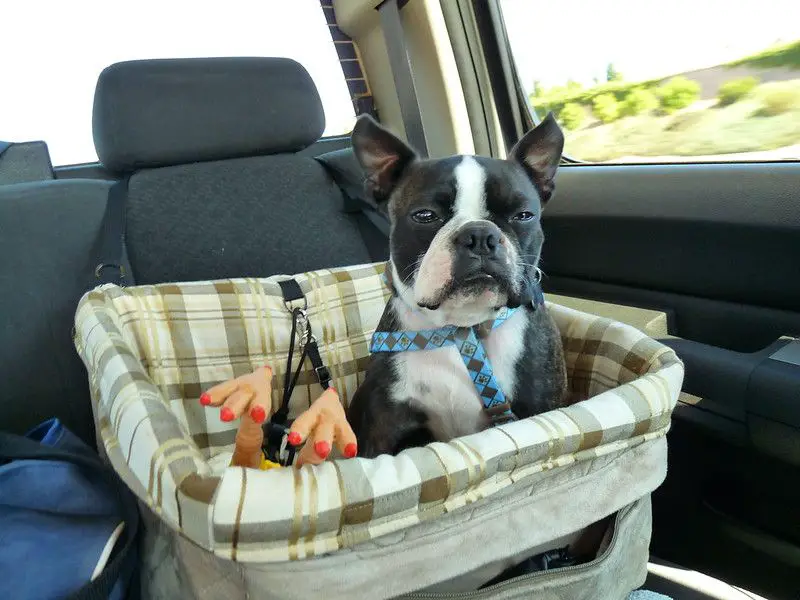
With the right care and attention , traveling with a new puppy in a car can be extremely pleasurable. The best time to take a long car trip with a new puppy is when he has received his second vaccination. However, always ask your vet to be 100% sure.
One of the easiest ways to get your puppy accustomed to car rides is to take them for short rides initially. Start taking them to nearby parks in your car so that they become familiar with a car. Gradually, after their second vaccination, they too will become super comfortable and prepared for long car rides.
Why Does My Dog Stare at Me when I Sleep?
How to Train Your Puppy for a Long Car Ride
To have a smooth and comfortable ride you need to know how to train your puppy for a long car ride.
First of all, your puppy needs an idea of what a car is. It would be a great idea to take your puppy around your car and let it sniff for a while. The smell would help them later to identify your car and they won’t feel strange.
Also, keep the car door open and let your puppy go inside. He must explore the car. Keep it seated for a while and see the entire car. This little experience will be helpful for him/her. You can do this process daily for a week and you will see that your puppy would happily wag his tail when you will take it for a long car ride.
Now it’s time for you to take the second step. Take them to a grocery store near your place in your car. He will understand what does it feel like in a moving car. Make sure to treat your puppy after these short trips. This way he will be quite eager and never make a fuss before riding a car.
Going for frequent short trips with your puppy is also another great way to train your puppy. While traveling, take him to different routes and let him know what he can expect from a car ride. Halt for a few minutes. Park your car in a parking lot. Move back and forth. All these activities will take away all the anxiety of your puppy.
You should never take your puppy for a long ride after just one small trip. Keep in mind the distance. Gradually increase the time and they too will be comfier.
If you follow these simple and easy-to-follow steps, your car travel with a puppy will be truly enjoyable.
Read Also : Why Does My Dog Bite Me When Excited?
Keep Your Puppy Safe while Driving Long Distance
Your task doesn’t end just by training your puppy for a long car ride. As a puppy parent , you have to look at his safety as well. Car rides can be at times unnerving too for the driver and the puppy. But keeping some safety measures in mind will surely guarantee you a stress-free journey.
Don’t keep your puppy on your lap
You should never keep your puppy on your lap while traveling. It can be dangerous for the puppy. They can get a severe injury if you meet an accident or your puppy can fall from the window. It’s risky for you or any other passenger in the car as well.
You can keep your puppy at the boot or footwell of the car. But a crate would keep them safe in a moving car, especially for long rides. Also, if you plan to put your puppy on your car seat, you must use a harness . The seat belts come in different sizes and they are the best to keep your puppy safe. The safety of your puppy should your top priority.
However, often puppies don’t like harnesses. You can use these dog seat belts for your short trips as well. This way your puppy won’t feel restricted. Also, always love them and praise them plenty. Make sure you reward them every time you put on these harnesses. Your puppy will be super happy.
Read More : How to Take Your Dog on a Cross Country Road Trip
Protect your dog from the heat
When you’re traveling for a while with your puppy especially in summers, you will be much exposed to sunlight and heat. Excessive heat is not good for your puppy. So make sure you use a shade to keep the heat away. Although sunshades work in a similar way, it’s wise to keep a heat shade handy.
Don’t let your windows down
We all love to meet those puppies sticking their neck out of the car window on the road, right? But this is not at all safe for your puppy. Even with a harness that can jump out of the window or a careless car can pass by your car and cause some serious injury to him/her.
The best way to prevent this is to keep your window shut. Just keep a little bit open for your puppy to breathe in properly. Also, window guards are a great option too.
Puppy’s car sickness
Yes, even puppies can be car sick too. How long can you drive with a puppy will depend on his comfort level as well. Talk to your vet before taking it for a long journey and give him medicine. Usually, giving the medicine before an hour of the ride would make sure that your puppy doesn’t feel any kind of car sickness.
Never drive too fast
You’re not competing in a Formula 1 race. With your puppy, you should pay attention to your speed. Don’t be rash or super speedy. This is especially applicable for pet parents who are traveling with an 8-week old puppy. Maintain an average speed of your car and take breaks between your journey.

Tips for Long Car Rides with Puppy
Here are some useful tips for a long car trip with a puppy.
- Feed them before an hour you start your journey . So even if your puppy suffers from car sickness, it won’t feel it that much. Also, let them drink water for an hour too. They won’t feel full this way.
- Take your puppy to the toilet before you board the car . Your puppy won’t feel uncomfortable just after getting up into the car and won’t be in an irritable mood too.
- If you’re taking your puppy for a long drive for dog-friendly hikes , make sure he is totally fit. If your puppy is too tired from the journey, it would be best to take some rest before going for the hike.
- Before you head out for the long car ride, take your puppy for a walk . If your dog is tired enough from the walking, it will fall asleep in the car.
- After traveling for an hour or two, take a halt . Let them have some water and allow it to pee as well. You will be set again for another two hours.
- When planning a hammock camping with your dog , have food bowls, enough water, baby wipes with yourself.
- Traveling alone with a puppy can be too much of a task. Having someone with you will ensure that your puppy is totally safe.
- Also, while stopping feed them when you’re on a long journey . At the same time, give some time for your puppy’s digestion.
- Stop for your puppy to poop and also to stretch his legs . A little bit of walking or running would make him more relaxed.
- When you’re having a long drive with a puppy from the breeder, make sure to bring some familiar stuff from the breeder . Stuff like toys, or old rugs will give them a sense of attachment.
- Puppies can be a distraction for the driver too . So keep them busy with their toys or let them sleep.
- When taking your small puppy for hiking after a long drive, you can carry a dog umbrella . It will keep them cooler even in hot weather.
- Buy the right size harness for your puppy if you don’t know how to transport a puppy in a car without a crate.
If you carefully take note of all these tips you can easily plan how long can a puppy ride in a car.

Essentials for a Long Car Ride with Puppy
If you ask how long can you drive with a puppy, it should not be more than six hours of driving a day. But do carry some essentials with you always.
- Dog toys or chewy sticks
- Paper towels or disinfecting wipes
- Cooling pad or wet towel
- Dog coats or blankets for winter times or for flights
- Poop or waste bags
- Water, dog treats, and foods
- Food and water bowls
- Crate or harness
- Prescribed medicines
- Dog carrier backpack when you need to stop in for a long halt
Read Next : Guide to Buy Affordable Best Dog Carrier Backpacks: An Expert View
So, follow these tips, pack the essentials, show your puppy some extra love and hop on your car for that much-awaited long drive with a puppy.
Read Next : 7 Reasons For Dog Panting In Car
FAQ on Long Car Drive with Puppy
1. how long can a puppy ride in a car.
A : Puppies should not be in a crate for more than two hours straight for a long car ride.
2. What can I give my puppy for long car rides?
A : You can give him some toys, chew sticks, dog treats, blankets, food, and water.
3. How do I keep my puppy from getting car sick?
A : Do not feed him immediately before riding. Use some familiar smells of home in the car. Give him medicine in case of an emergency.
Read Next :
Dog On A 10 Hour Flight: How To Bring Your Dog Across The World
- How Stressful is Flying for Dogs? 5 Tips to Reduce Dog Stress on Flight
- Teaching Your Dog to Sleep Outside His Crate
Similar Posts

The Ultimate Guide for Hammock Camping with Dog
Dogs are a constant companion in life, our already mundane lives get more boring without them. Hammock camping with dog can be a great idea if you know how to do it. Any holiday or outing seems empty and forlorn without our pups. Some consider taking dogs camping, to be an unnecessary hassle, they do…
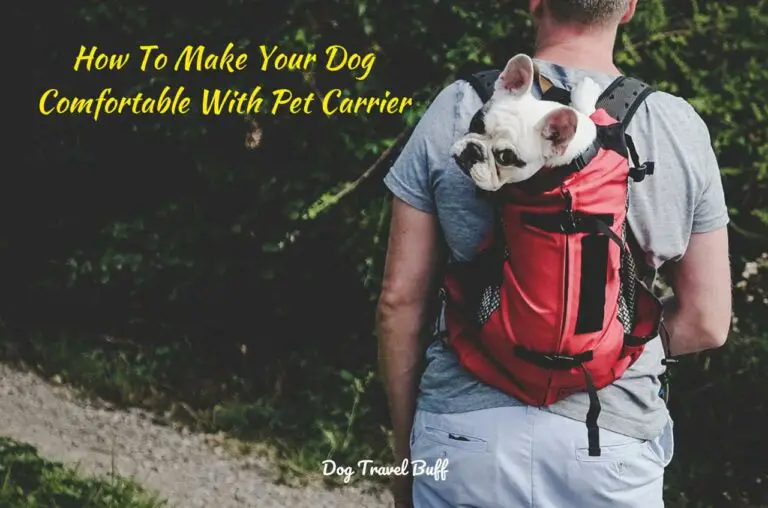
10 Tips On How To Make Your Dog Comfortable With Pet Carrier
Dogs love to travel as much as people do. Pet owners also feel they need to take their dogs with them whenever they travel. However, taking dogs along on travels can be challenging. You must think of a way to keep them secure and beside you. This post may contain affiliate links. If you buy…

9 Reasons Why Does My Dog Hump After Eating: Explained
I got a German Shepard three years back and after a year I caught him humping with his toy. His lips were stretched out, brows were furrowed, ears were hanging and he was humping! My instant reaction was to close the door and go to another room. Like you, I took Google for an answer…
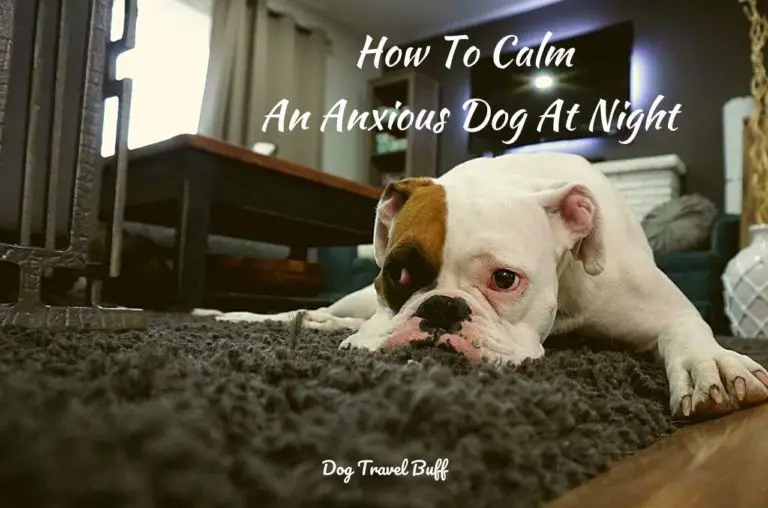
10 Tips On How To Calm An Anxious Dog At Night(With Video)
Just imagine a situation, you come back home, tired and struggle to focus. You decide to settle down, spend time and finally enjoy the peace. But what you hear, the sound of your dog whining, panting, barking and restlessly pacing. You love your dog, and you wonder how to calm an anxious dog at night?…
11 Best Dog Vest for Hiking: Dog Harness Reviews & Buying Guide
In case you are planning to take your pet friend with you to your next hiking or backpacking destination, then a dog hiking harness is what you need. These harnesses are specially designed for strenuous activities. While collars can put too much strain on your pet’s neck, a harness if well-fitted will provide both comfort…

Traveling with dogs on a flight is quite a difficult job. Even all dogs are not allowed to travel with you on a flight. But if you’ve already decided to travel with your dog then few things and precautions you might consider prior. In this article, we will share our experiences with you to tackle…
Leave a Reply Cancel reply
Your email address will not be published. Required fields are marked *
Save my name, email, and website in this browser for the next time I comment.
- Dog Health & Care
- Dog Nutrition
- Dog Training
- Vet Approved
How to Safely Travel With a Puppy in a Car: 11 Vet Reviewed Tips
Last Updated on March 22, 2024 by Ed Malaker
VET APPROVED

REVIEWED & FACT-CHECKED BY
Dr. Paola Cuevas
Veterinarian, MVZ
The information is current and up-to-date in accordance with the latest veterinarian research.
Traveling with your puppy can be a great experience—and a way to show off your new pet to your friends and relatives. However, it’s important to do it safely because puppies aren’t as sturdy as adult dogs and require special care. Keep reading as we list several essential tips and tricks to help you travel safely with a puppy in your car.

- The 11 Tips to Travel With a Puppy in a Car
- 1. Invest in a Quality Crate or Carrier
Purchasing a good puppy crate designed for use in the car is one of the best ways to keep your pet safe while traveling. It prevents the dog from wandering around the car while you drive, which can be distracting and lead to accidents or injury. Choose a crate that isn’t too large but enables your dog to stand up and turn around comfortably. It should also have plenty of ventilation and enable your dog to see what’s happening around them. You can also use a leash or harness, but these aren’t as secure as a crate.

- 2. Secure the Crate or Carrier
Once you choose your puppy crate, you must secure it in the car’s back seat. Follow the instructions in the manual to ensure that you install it properly, so it doesn’t slide or tip if you suddenly stop or turn.
- 3. Bring Along Familiar Items
Your new puppy might be scared the first few times that you take them for a ride, so bring along plenty of familiar items, like toys, blankets, and clothing. These items will smell like home, which can help your dog feel more comfortable. The toys can also give your pet something to do on a long trip so they don’t get bored and start acting up.

- 4. Don’t Feed Your Puppy Right Before the Car Ride
Avoid feeding your dog right before your trip to help prevent them from needing to use the bathroom. Dogs can also get sick if they eat right before a car ride, leading to diarrhea, vomiting, drooling, and other problems. Try to wait at least 2 hours after a previous meal so the food can digest a bit before taking your puppy for a ride.
- 5. Take Frequent Breaks
Even if you don’t feed your puppy, you will find that they still need bathroom breaks while on a car ride. They will also need to stretch their legs, or they can start to misbehave. Taking frequent breaks at rest areas or small parks will help your puppy relieve themselves, burn off excess energy, and give you a chance to provide them with water to keep them hydrated. Always remember to bring doggy poop bags with you so you can clean up after your pet.

- 6. Keep the Windows Rolled Up
If you are using a harness instead of a crate, keep the windows rolled up so the puppy doesn’t try to stick their head outside, which has a high risk of injury due to their small body. If it’s extra hot in the car, leave the windows open only 1–2 inches to keep the dog’s head inside.
- 7. Watch for Motion Sickness
Puppies, like children, are more susceptible to motion sickness, likely due to still-developing inner ears, so keep a close eye on your pet as you drive. Look for signs like whining, drooling more than usual, restlessness, lip licking, and vomiting. If any of these things occur, stop the trip, and keep future trips short until the dog gets older.
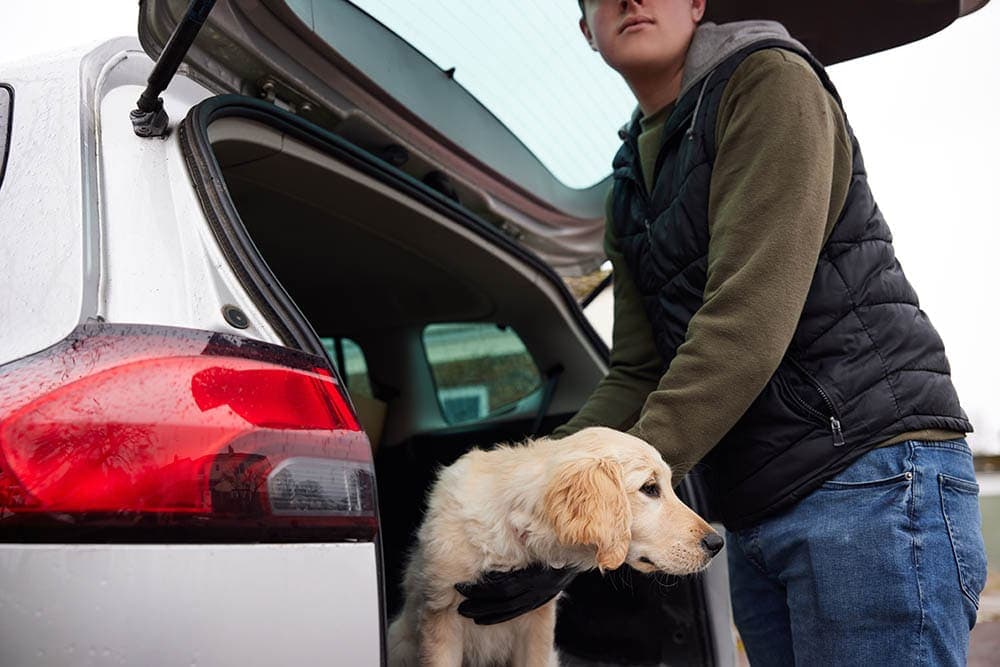
- 8. Take a Friend With You
Since watching your puppy while you drive can be hard, taking a friend with you can be helpful, especially if they are also friendly with your pet. Doing so can help alert you to problems like motion sickness sooner and can also help the puppy feel more comfortable because they will be getting extra attention. The friend can also hold the crate or leash to help keep the puppy more stable during the trip.
- 9. Take Your Pet for Frequent Rides
Taking your pet for frequent rides can help them get used to it, and they will develop an in-car routine that will enable them to be more comfortable so you can take longer trips. Many dogs will even grow to enjoy riding in the car. Doing this also helps prevent them from panicking when they must ride in the car, like when they need to go to the vet.
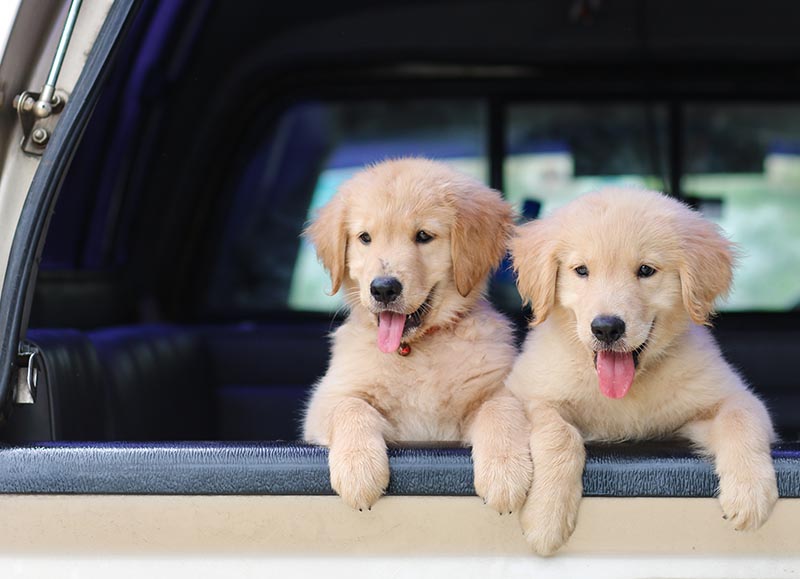
- 10. Never Leave Your Puppy Alone in the Car
The inside of a vehicle can get quite hot if you park in a parking lot or other location, especially with the windows up, so it’s not safe to leave your puppy in the car while you run errands. Doing so can lead to heat stroke or even death. Even on a mild day, the inside of a car can get very hot and stuffy. Never leave the dog in the car alone for more than a few minutes, and when you do, park in the shade and leave the window open slightly.
- 11. Use Identification Tags
You will need to make frequent stops with your pet as you travel, and there is always a risk that you might get separated. Getting the dog microchipped and ensuring that they are wearing identification tags can reduce the risk of them getting lost.
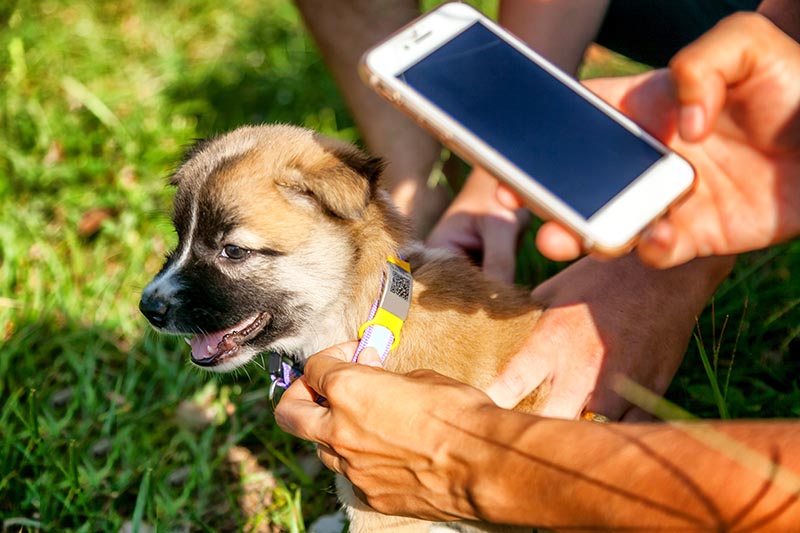
Traveling with your puppy is not difficult and only requires you to take a few steps to ensure that the dog is safe. A quality crate or carrier is the best way to protect your pet. It can be fastened securely with seat belts, so it won’t tip or rock when you drive. Many have additional padding and will also protect your car seats from accidents. Take along plenty of familiar items and toys , and start with short trips to help your puppy get used to the movement and develop an in-car routine. Extend your adventures as the dog gets used to the car, and go out frequently so they look forward to it.
Featured Image Credit: eva_blanco, Shutterstock
About the Author
Ed Malaker is a seasoned writer who has contributed to a wide range of blogs that cover tools, pets, guitars, fitness, and computer programming. When he’s not writing, Ed is usually making DIY projects around the house or working in the garden. He’s also a musician and spends a lot of time helping people fix their guitars and composing music for independent movies.
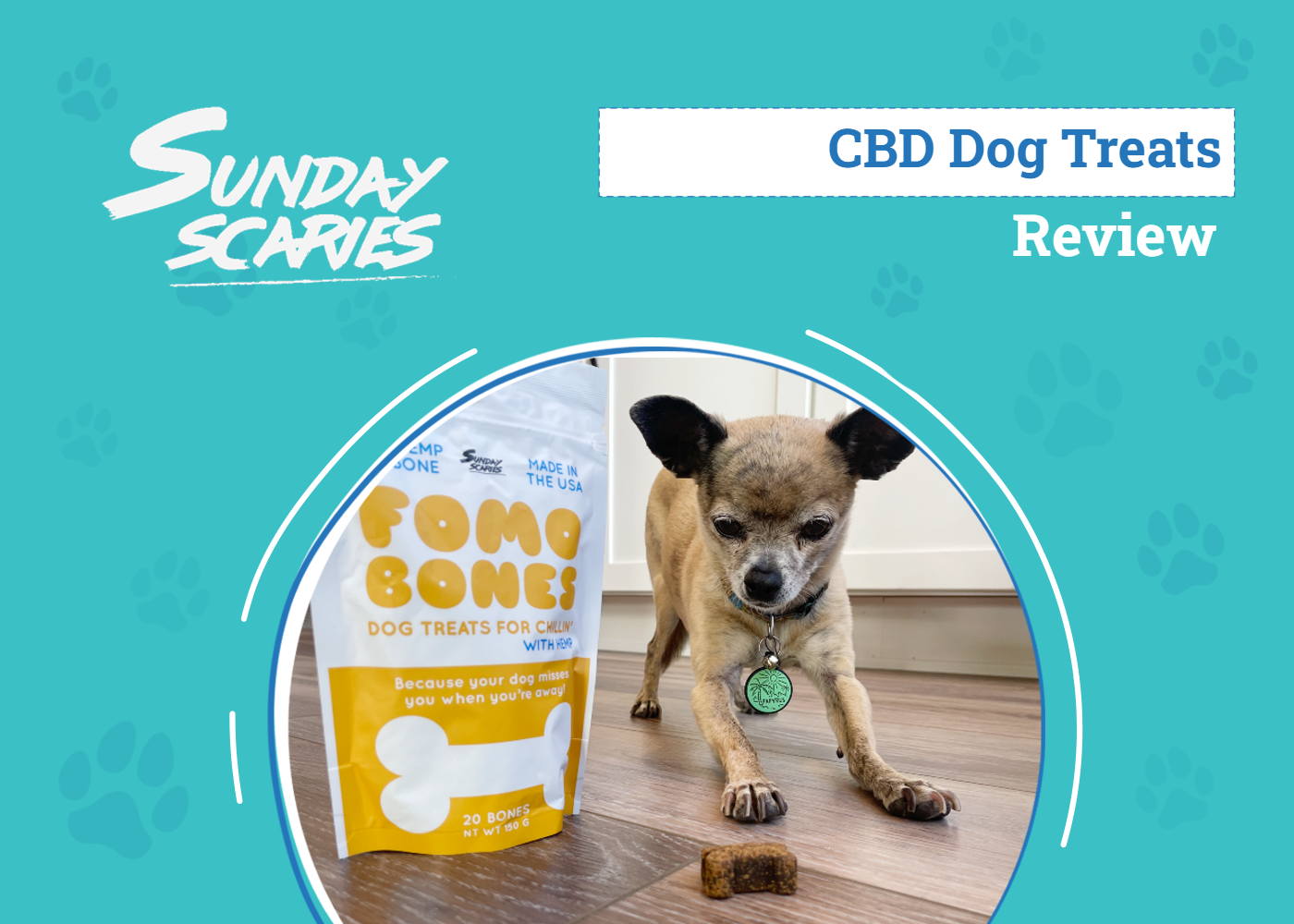
Sunday Scaries FOMO Bones Review 2024: An Expert Breakdown
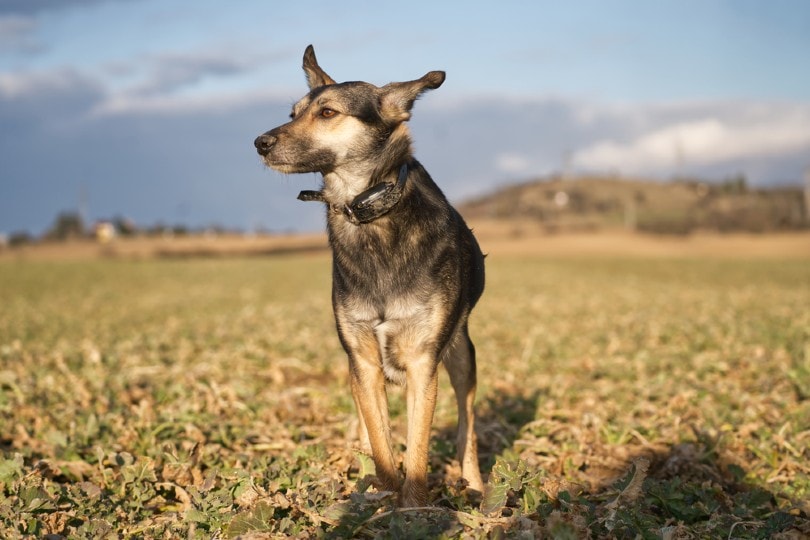
10 Best Wireless Dog Fences in 2024 – Reviews & Top Picks
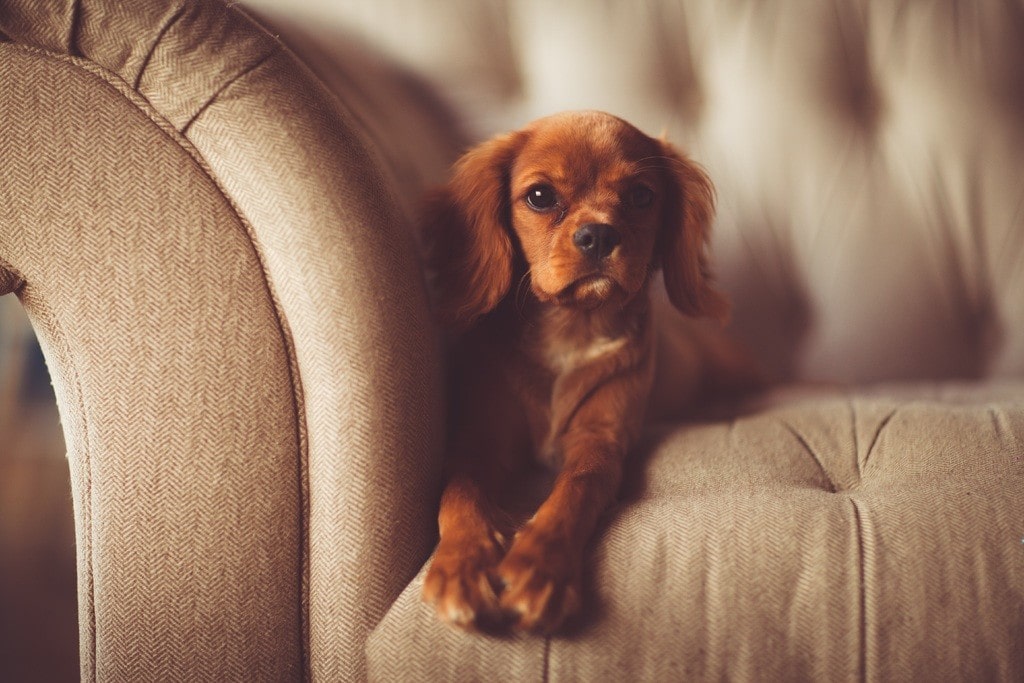
7 Best Couch Materials & Fabrics for Dogs (With Pictures)
Get dogster in your inbox.

Can Dogs Eat Pineberries? Vet-Reviewed Facts & FAQ

Can Dogs Eat Agave? Vet-Reviewed Facts & FAQ

Can Dogs Eat Macadamia Nuts? Vet-Verified Facts & FAQ
© pangolia pte. ltd. all rights reserved..

How to Take a Long Car Ride with Puppy: Road Trip Essentials for Dogs
Posted on Last updated: April 21, 2021

Whether your trip is 5 hours or 10, taking a l ong car ride with puppy can be stressful! You want your dog to be as comfortable as possible during the trip and have many other things to worry about.
In the Summer of 2019, we took a 1500 mile road trip from Buffalo, NY to Longmont, Colorado- our new home! The drive was about 23 hours (not counting stops), with 2 cars packed with everything we own, and of course our doggo!
Traveling with a dog is not the easiest feat, but it was easier than I imagined it to be! At the end of the day, your precious pooch really just wants to be with you, so don’t stress too much!
We found the following tips to be extremely helpful during our road trip, and hope they will help you as well!
Read more information on road trip essentials !
Disclosure: Some of the links below are affiliate links, meaning, at no additional cost to you, I will earn a commission if you click through and make a purchase.

Long Car Ride with Puppy : What do they Need?
On long road trips, dogs will need a travel bag, an extra-long leash, special treats and toys, and time to exercise. Try to stop every 2-3 hours to give your dog time to exercise and use the bathroom. Read more about what dogs will need below:
Dog Travel Bag

Dogs don’t need much, but having all their items in one place makes traveling much easier! This dog travel bag is awesome- it includes foldable dog bowls, food and treats containers, a water bottle, and tons of pockets to put toys! Plus, it even has a luggage sleeve so you can place it over your suitcase handle for easy traveling!
Thinking about everything your dog might need can be overwhelming, especially when searching through all your suitcases and bags trying to find a specific toy.
Having everything in one spot will take a lot of stress off you when taking a cross country road trip with your dog . Plus, your dog will feel happy knowing all his favorite treats and toys are right beside him!
Extra Long Dog Leash

This extra long dog leash was a true lifesaver on our road trip. At the time, our dog Ollie was just a puppy- just over one year old, so he had a LOT of energy. You can get this leash anywhere from 15 feet to 100 feet, depending on your dog’s needs!
Whenever stopping at a rest stop, put your dog on this extra-long leash to give them more freedom to run around, without worrying about them running off! Most rest stops have large fields or picnic areas where your dog can safely explore on the leash.
Our dog LOVED being able to run around, even while on the leash! Running around for 10-15 minutes was just the trick we needed so he would fall asleep again in the car.
The leash can be a bit difficult to use, especially reeling your dog back in. However, the pros definitely outweigh the cons for this one!

Stop Every 2-3 Hours
As a rule of thumb, when taking a l ong car ride with puppy , plan to stop every 2-3 hours. Your dog will most likely begin to get restless around that point and will want to get up to stretch his legs and go potty.
This, of course, varies depending on your personal needs and your dog’s needs- it might be a little shorter or a little longer than these numbers.
Think of it this way- if you are restless or need to use the restroom, chances are your dog does too!
We made a rule to let our dog run around every time we stopped to get gas, and every time we stopped for the restroom or food. Even just a quick 5 minute run around session can be enough to get through the next couple of hours!
Take a quick walk, throw your dog’s favorite ball, play frisbee, or even take a short jog! Whatever you need to do to get the blood flowing- it’s good for you too!
Dog Car Seat Cover

This car seat cover is a miracle worker when taking a cross country road trip with dog ! It is 100% waterproof and has side flaps to keep your car from getting dirty and scratched up. It is easily installed by putting the buckle around the headrests and opening the flaps!
Your dog will love the extra cushion the cover provides, and your car seats will thank you for staying clean! You can also adjust the side flaps to make room for a passenger that is also in the back seat.
Your pooch will love having space all to his own! Additionally, the flaps can prevent your dog from jumping up into the front seat, which can be dangerous while driving.
This seat cover is an amazing find and a definite must-have on your road trip!
Talk With Your Vet

Not all dogs do well in the car, just like some humans! Sometimes dogs get car sickness and even throw up. This is why it is a good idea to get that car seat cover in the previous step!
Some dogs get anxious when it comes to being in the car or traveling to new places. Talk with your vet, as there may be some medications you can give your dog to help!
We have found it helpful to delay feeding your dog after driving is over for the day, specifically for dogs who throw up easily in the car. However, talk with your vet about this too!
If your dog yawns more than usual, drools a lot, or licks his lips, this might be a sign of car sickness. If you see these symptoms, it might be a good idea to stop at the next rest stop!
You can also get your dog an anxiety vest if they get nervous in the car, or even in new places like the hotel.
You can read more about symptoms and remedies here !

Find Local Dog Parks

This tip was probably the most helpful thing we did when taking a l ong car ride with puppy . When we arrived at our destination, and before we left the next morning, we would always find a nearby dog park. DogGeek is a great resource where you can put in your location, and it will give you a list of nearby off-leash dog parks!
This allows your dog to get familiar with the new area and scents, as well as run around and stretch. It was also nice for us humans as well, as we were able to get some fresh air and sunshine and take a nice walk around the park. A win-win for all involved!
Some dog parks are patrolled by police though and require your dog to have state requirements, so make sure you check if the park has this or not before you go! Your out of state license plate would probably be a red flag!
Otherwise, grab a coffee and take a walkabout after being cramped in your car all day! Doing this in the morning tires your dog out and (hopefully) gets them to sleep better in the car!
If you are a dog owner and have never heard of Bring Fido , you are seriously missing out! It is basically a dog lover’s dream website!
Here, you can find pet-friendly hotels, restaurants, bars, events, services, and practically anything pet related!
This can help you with finding pet-friendly hotels if you choose to stay somewhere overnight. You can also bring your pet with you to dinner, so he isn’t locked up in a new and scary hotel room by himself!
We use this all the time, even just when we want to go out on the weekend and want to bring Ollie. It is truly a lifesaver, and your dog will be so happy he could join you!
Special Treats & Toys

Buying your dog some special treats, a new toy, or his favorite bone is a great thing to have on a l ong car ride with puppy. Having something new and exciting to eat or play with will help him feel happier and more relaxed!
Our pup LOVES bully sticks . Although they are on the expensive side, they are much healthier than other dog bones (won’t cause choking), and take a long time to eat.
You could also get your dog a fun puzzle toy to pass some time. Simply put treats into the toy, and watch your dog try to solve the puzzle to get the treats out! This is a great way to entertain your dog, even in the small space of a backseat!
Everyone loves a special surprise, so treat your dog to a special toy or bone, to say thank you for handling this road trip like a champ!

Bring Vaccination Records
This is an important tip to remember when taking a l ong car ride with puppy . Simply put your pup’s records in your glove box or somewhere safe, just in case! You can even take a picture of them on your phone.
Some hotels might ask to see the records, or you never know what might happen during the trip. Maybe your dog gets sick or hurt and needs to see a vet- they will need his vaccination records!
This is a small and simple tip but could be extremely important in the rare event that something were to happen. Bring them just to be safe!
Pet Seat Belt

Having your pet in a seat belt can be life-saving in the rare event there is a car accident. We tell humans to wear seat belts while in the car, so why shouldn’t pets?
If there was an accident, your dog would easily fly through the windshield. Having a simple seat belt could save your dog’s life! They are also great for dogs who like to stick their heads out the window too far, or those who would jump out if there was the sight of another dog (I have actually had a dog do this, and he got pretty hurt).
They are also great for those dogs who like to jump out of the car as soon as you open the door. This could save them from jumping out into a busy parking lot!
The seat belt is super easy- it attaches to your dog’s collar like a regular leash, then the other side goes into the seat belt buckle- easy as that! Your dog will still have room to move around, too!

If your dog is running around multiple dog parks and rest stops, chances are he’s going to get a little dirty! And, he should! With little time to run and play during the day, he should make the most of his time outdoors rolling in the mud and digging in the dirt.
However, your car and hotel won’t agree! These dog wipes are the perfect tool to clean your pup up between washes.
Maybe he starts to get a little smelly- you don’t want to smell that the entire road trip! These wipes also help with odor too! You never know what your dog will get into, so its best to bring some wipes just in case!
First Aid Kit

The last thing you will need when taking a l ong car ride with puppy is a pet first aid kit .
You never know what could happen on your trip, so having a first aid kit will help in emergencies. Maybe your dog hurts himself in the car and you are 50 miles from the next exit- you will want some sort of first aid to help him!
Hopefully, you will never have to use it or even open it, but having one will give you a piece of mind knowing you are prepared in case of an emergency situation.

Thank you for reading taking a l ong car ride with puppy . What other tips do you have when it comes to long rides with your pet? Let us know in the comments section below- we would love to hear from you!
I accept the Privacy Policy
This site uses Akismet to reduce spam. Learn how your comment data is processed .
Traveling With A New Puppy: A Survival Guide
Are you about to take a long car trip with your new puppy? If so, you need to read this survival guide on how to make traveling with a new puppy a breeze.
A long car trip can be a daunting experience for you and a new puppy, but with the proper preparation (including packing the right dog-friendly gear ), it can be a fun and exciting adventure. This article will discuss everything you need to know before hitting the road with your new furry friend.
We will cover topics such as safety, food and water, potty breaks, and how to keep your puppy entertained during the trip. Following these tips ensures that your long car trip goes smoothly for you and your new puppy!
So, let’s get started.
Safety Aspects Of Traveling With A New Puppy
Safety is always the number one priority when traveling with a new puppy. This is especially important when going on a car trip. First, ensure your puppy is restrained in the car safely and securely.
If you use a harness or dog seat belt, attach it to a full-body harness, not a collar . A loose collar could cause your puppy to choke if it jumps out of the seat or gets tangled in the belt.
“ We recommend keeping your puppy in a travel-safe crate or boost seat during car trips. As your dog grows older and bigger, you may need to upgrade to a dog car harness that attaches to a seat belt. It’s best to keep your dog in the backseat of the car, or in the rear of a station wagon” – PetBarn
When we are talking safety, remember this isn’t just about the puppy. This is about everybody on board. It is not unusual to become distracted by a new puppy on a long car trip.
Pull over to a safe location if you need to take your eyes off the road for more than a couple of seconds. It is not worth risking an accident to check on the puppy.
If you take the necessary precautions, traveling with your new puppy can be a safe and fun experience for both of you!
Food And Water For Puppies In The Car
Regarding food and water, it is crucial to bring along enough for the entire trip, plus a little extra just in case.
Water breaks are most important, especially on hot days. Carry an ample supply of fresh water , especially if you stop in an area that won’t have access to clean, running water. Freshwater streams may be polluted, so best to bring your own supply.
You should pack a container or bowl to offer the puppy water regularly.
Puppies need to eat more frequently than adults , so plan on making several stops for potty breaks and meals – every hour is best. Stopping reasonably often is also vital for you as the driver to get a good leg stretch.
You have to ensure you aren’t giving your pup any potentially harmful treats (like chocolate or other human treats). Apart from the danger, foods that aren’t meant for puppies can make them sick on the trip.
Don’t be too concerned about treats, training, and conduct just yet, though, especially if your puppy is relatively young (say 8 to 10 weeks old – very much just a baby)!
Toilet Breaks For Puppies On Long Car Trips
Speaking of potty breaks, you will need to make sure that you take plenty of them on your long car trip. Puppies have small bladders and can’t hold them for very long, so you will need to make sure that you stop every few hours to let them relieve themselves.
If possible, try stopping at pet-friendly rest stops or parks so your puppy can stretch their legs and burn off some energy.
Bring Some Towels
Puppies may also have accidents in the car, so it is a good idea to bring along some old towels or newspapers to clean up any messes just in case and also to put a moisture-absorbent puppy pad and towel underneath their travel crate.
Puppies Can Find Traveling Tiring
Remember that long car trips can be very tiring for puppies, so take it easy on them.
Break Up The Trip
If you are planning on driving for more than a few hours, The Spruce Pets says it is best to break up the trip into smaller legs over a few days. A few breaks will give your puppy time to adjust to their new surroundings and get used to being in the car. Plus, it can be a fun experience for you and the family.
Control The Vehicle’s Climate
To help reduce fatigue, ensure the vehicle is climate controlled to a comfortable level, i.e., Air conditioning in summer, shades up on the windows, and the heater on (but not too hot) in winter.
Watch For Carsickness
Carsickness or motion sickness is very common in puppies, as their delicate inner ear structures aren’t fully developed yet . If this gets serious, your vet will be able to provide advice on remedying this.

Entertaining A Puppy In The Car
Last, you will need to keep your puppy entertained during the drive. Keeping busy is essential both for the pup’s safety and your sanity!
Bring their favorite toys from your home, such as chew toys and a few treats to keep them occupied. If you’re picking up your new pup from a breeder or pet store, you might be able to take home a blanket that smells of their mother.
Familiar everyday items will have comforting scents and help keep your pup calm.
Crates With Built-in Toy Holders
Don’t be too concerned if your puppy is shy and just wants to hide in its crate – at only 8-10 weeks, it is likely the pup has only had limited experience in cars and most likely only short car trips with the litter to the vet for initial health checks or vaccinations.
Following these tips ensures that your new puppy’s long car trip is safe, fun, and stress-free!
So there you have it, everything you need to know about traveling with a new puppy! By following these tips, you can ensure that your journey is enjoyable for you and your furry friend. Safe travels!
Do you have any other tips for long car trips with puppies?
If you found this article helpful, please share it with your friends and family planning a road trip with their new pup. Thanks for reading!
About The Author
Hi, I’m Sandra. I am an animal lover and have had a whole variety of pets my whole life. I started MyPetReview.com to share my passion, experience and knowledge of all kinds of animals and pets – from responsible ownership, training and feeding right through to my thoughts on toys and other pet accessories.
Related posts:
- How to Get Dog Hair Out of Car Carpet
- How to Help a Car Sick Dog Enjoy the Ride
- Best Ginger Dog Treats for Motion Sickness
- Canoeing With Dogs: Ultimate Guide to Taking Your Dog Paddling
Terms and Conditions - Privacy Policy

8 Helpful Tips For Driving a Long Distance With A Puppy?
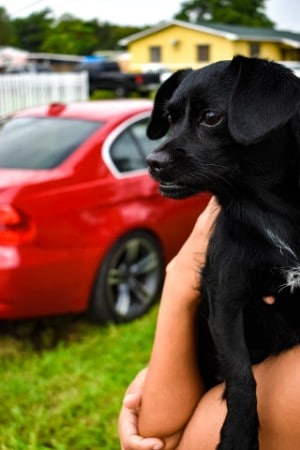
Going on a long journey with a dog is difficult enough but things get much more complicated when you are travelling with a puppy.
And you can add another few layers of complexity when you are planning to drive a long distance with a puppy that you have just picked up from a breeder!
It is perhaps stating the obvious to say that this journey will require a terrific amount of planning and preparation as well as a touch of good fortune
When we undertake driving long distances with a puppy in cars, three factors combine to potentially create a perfect storm.
The puppy doesn’t know you, they are leaving their family and home and it will be one of the first times that they have travelled in a car.
If that isn’t a challenge, I would like to know what is!
[1] Tidy house and garden
A bit of a strange one to start with?!
Why start with the house and garden when the focus is on taking a journey 🙂
Make sure that your house and garden are puppy proof.
- Will mothballs keep dogs From pooping in my yard?
The rationale for this is that when you return with your puppy you won’t have time to pick things up off your floor as before you know it they will be in your puppy’s mouth.
But what do I mean by tidy?
Just make sure that the floors are clear of any clothing, shoes or valuable items such as laptops.
And that any electrical wires are out of sight.
The same goes for the garden.
In fact the garden should be the first place that you head towards on your return.
Make sure that it is clear of any poop (cat or dog) and other objects such as gardening tools
[2] Don’t do it alone.
If at all possible, don’t make a long journey with a puppy on your own: get yourself a “Wingman”.
Always travel with someone else, so that one person can concentrate on driving, the other on the puppy.
And if you are going to share the drive, make sure that the owner of the puppy sits with the puppy for the first leg so that they can bond.
- Worried about leaving a puppy alone with an older dog?
If you do have to make the journey alone it will be infinitely harder.
[3] Crate or lap
Strictly speaking in both the US and UK dogs should not travel in a car without being restrained.
This can mean a number of different things.
From travelling in the backseat with a lead on (that is attached to some part of the car), to travelling in a crate, to travelling in the boot secured behind a dog grate (in estate cars or station wagons.)
- How do I crate train my French Bulldog at night?
This requirement is for the whole of the UK, as defined by Section 56 to 58 of the Highway Code.
Things are less clear in the US.
As of this moment, only six states require a dog to be restrained; Connecticut, Maine, Massachusetts, Minnesota, New Hampshire, Rhode Island .
For puppies, most people opt to place their puppy in a pet carrier or crate on the backseat, so that someone can sit next to them and keep an eye on them.
This enables someone to provide comfort while still keeping the puppy safe.
But what do you do if you have a puppy which is visibly distraught and continually whining and even shaking with fear?
Some people resort to having the puppy on their lap, which works as long as the puppy falls asleep.
[4] Keeping calm
The next tip is probably the hardest one to organise and manage.
And that is to keep calm.
However chaotic the trip may get (and with a puppy that might urinate, defecate, vomit or whine relentlessly) it is quite likely, you should always try and keep calm.
And by this I mean never raising your voice, making sudden aggressive movements or god forbid, discipling your puppy with a smack.
- Is your puppy aggressive when tired?
None of this will make your puppy less likely to stop- whining, vomiting or defecating.
In fact it will likely have the opposite effect.
Losing your temper only shows that you have lost control.
And the best way of keeping calm is by planning and preparing.
Because like a military operation, you will need lots of equipment.
[5] Equipment
When you start your journey you need to know that you have thought of every eventuality and that you have bought for it.
We have already mentioned the crate- just make sure that it is the right size for your puppy.
There is plenty of advice about buying the correct size crate for a puppy.
It should be big enough but not too big. The most important things to think of are the gear that you will need to clear up any kind of mess- wipes, gloves and poop bags or nappy bags.
And make sure that you have enough! It is better to bring more wipes than you need rather than less.
The next most important item to bring is a lead- I am presuming that your puppy will have a collar on but this is something to double check
Some would say that it needs to be attached to your dog for the whole journey but I think that it is OK to put it on before any door is opened!
The next important piece of equipment to include if you are picking up your puppy from the breeders, is a cloth of a blanket that smells of their Mum or of the litter.
Having a familiar smell in a very unfamiliar environment should help to calm your puppy down, making the journey easier for everyone.
[6] Food and water
The next issue to think about and plan for is whether to bring any food for your puppy.
This is actually quite a complicated issue to wrap your head around.
- How long can a puppy go without water?
There are loads of different things to consider about this issue and it is easy to get in a muddle about it.
It all depends on how long your journey is and how old your puppy is.
Most puppies that are being picked up from breeders are about eight weeks old.
And an eight week old puppy should be eating about four times a day, which is about every four hours.
In an ideal world, you want to pick your puppy up a couple of hours after their first meal, which means before you start your journey your puppy has been to the toilet and emptied their stomach.
It also means that they are only a couple of hours away from their next feed.
As a one off, they can miss their next meal and not need to be fed during the journey as long as you will be home by the time they should have their third meal of the day.
To keep things simple, this gives you a six hour journey time.
- How long can a puppy go without food?
If you can complete your journey (with all the stops) within six hours then you shouldn’t feel pressured to feed them en route.
However, if your journey time is over six hours, then take some food to feed to your puppy.
Make sure it is the same brand and type of food as they have been eating up to this point.
Either way, make sure you pack some food just in case your journey is delayed.
Your puppy might not need to be fed on a long journey but they should always have access to water- which you should offer to them at every stop.
Now, lots of puppies who have been picked up from the breeders have no interest in food or water as they find the journey too exhausting.
But just how often should you stop on your journey?
[7] Rest stops
The biggest factor in how many rest stops that you should make is that an eight week old will need to go to wee every two- three hours.
And after around three hours most drivers could do with stopping and “switching off” for a time as well.
But rest stops aren’t without the odd risk here and there.
For instance, it might be difficult to find a quiet and clean patch of grass to take your puppy on at the rest stop that you have chosen.
It needs to be quiet so that your puppy isn’t spooked by any sudden loud noises from passing traffic or groups of people.
And remember it needs to be clean and free from other dogs because your puppy won’t have had all of their immunisations.
And please make sure that before you open any doors, your puppy has a collar and lead on.
Another risk of stopping is to not leave your puppy unattended in the car at any point.
Not only might they be at risk of overheating (in the car) if you take longer than expected going to the restroom and buying a coffee but they could also be stolen.
It makes most sense, if there are two of you in the car, to take it in turns to go in and use the facilities.
And as I come to the end, I want to talk about the option of paying for someone else to do it.
[8] Pet Taxis
If everything up until this point has overwhelmed you and freaked you out, there are companies out there who will drive your puppy on a long journey for you.
These services are not cheap and depending on the distance travelled it might cost hundreds or thousands of pounds but if you definitely have the money and definitely don’t need the stress, then it might be the way to go.
My sister in law a few months back paid for a company to drive her new 8 week old Golden Retriever puppy on a six hour journey and everything went incredibly smoothly.
Other Similar Posts

James Grayston
My name is James and I love dogs. have owned four Golden Retrievers in the past 15 years. Currently I own two "Goldies"- a five year old and a seven month old. The photo shows me with our youngest when she was about 7 weeks old!
7 Tips for a Road Trip with a Dog or Puppy | Pupford
January 3rd, 2024
Filed under Lifestyle + Stories
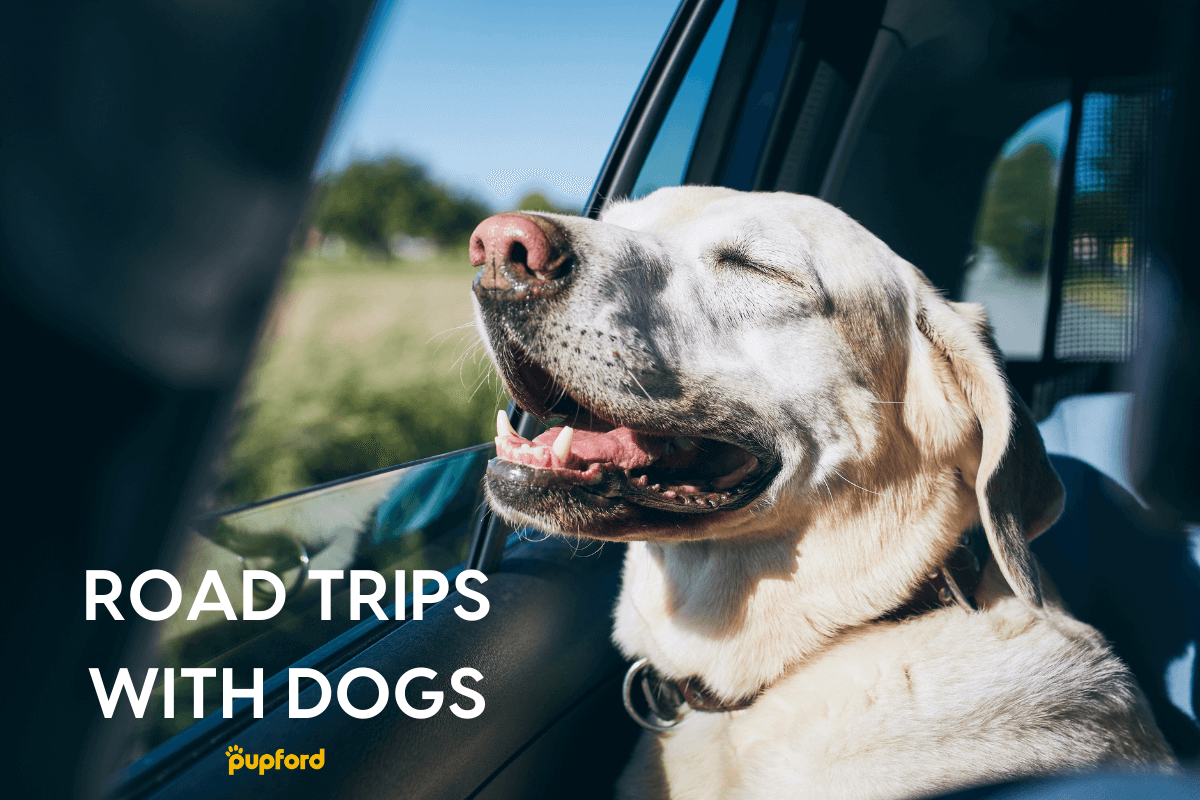
I’m no stranger to road trips with dogs. From Utah to Oregon, Oregon to Utah, Utah to South Carolina, South Carolina to Florida, Florida to South Carolina, and South Carolina back to Utah (plus, MANY little weekend trips) I have had our four-legged friend by my side.
And while road trips (mostly) go smoothly now, it definitely took some time for my dog to come around to spending countless hours in the car.
Here are some of the things I have learned about taking a road trip with a dog or puppy and driving with dogs in general. Plus, what to do if your dog gets car sick, what to do if your dog dislikes car rides, and how to desensitize your dog to the car!
TIPS FOR ROAD TRIPS WITH DOGS
Before we dive into each tip, here's an overview of 7 dog road trip tips:
- Bring the necessities and essentials
- Get their energy out
- Provide them with mental stimulation
- Take frequent breaks
- Find a dog-friendly hotel to stay at
- Stop for food/activities
- Safety measures
Alright, now let's look at each idea in detail. 👇
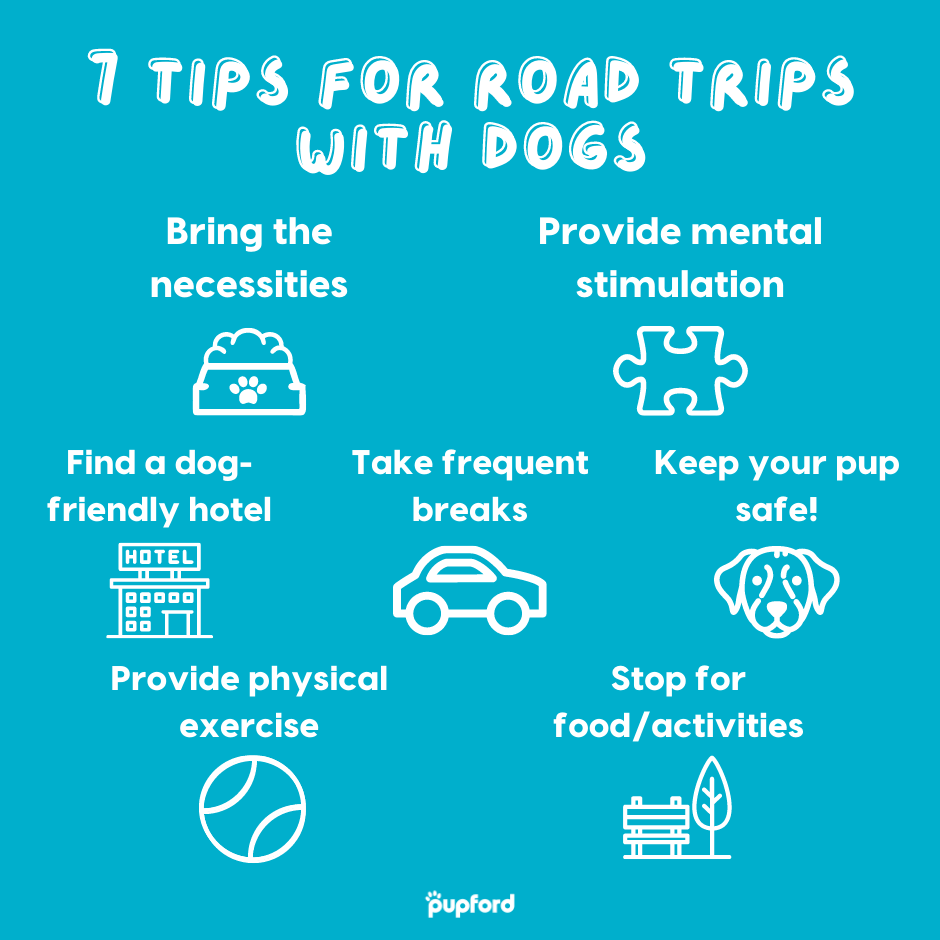
1. BRING THE NECESSITIES & DOG ROAD TRIP ESSENTIALS
First things first. Making sure you have all of the travel necessities for your pup within reach is so important. Here are some dog road trip essentials:
- Water bowl/water. You will want your dog to have access to fresh water throughout your trip. A spill-proof bowl is helpful while you're on the go.
- Food. Make sure to bring enough food for the amount of time you will be away! We also like to make sure the food is in an airtight container so it doesn’t get stale or stink up the car.
- Leash and collar/harness. Pack your dog's leash, harness, and collar. And be sure to get your tags updated before a big trip!
- Vaccination records/health certificate. Some hotels will require you to show your pup's vaccination records, plus, if you have to take a trip to the vet, this paperwork will also come in handy.
- Poop bags - a dog's gotta do what a dog's gotta do...
- Towel/blanket- if they get dirty or wet (or make a mess) a towel is nice to have handy. We also like to have a blanket for our dog when we stop for the night, and for him to lay on in the car.
- Dog bed (if there's room)- whether it is for safety or comfort, having a dog bed or a comfortable area for your dog to be if you stop for the night can make the trip more enjoyable for all.
- Treats/chews- bring treats that will keep your dog busy for long periods of time, like a tasty & long-lasting dog chew . You can also freeze a Kong with peanut butter or greek yogurt and some treats. And don't forget some training treats to take advantage of training opportunities while you're out.
- Favorite toys- bring a ball and ball thrower, squeaker toy, or some of their other favorite things.
- Crash-tested crate/harness/carrier- when it comes to drives with dogs, safety is also really important. Get a crash-tested crate/harness/carrier for your drive with your pup.
- First Aid Kit- some things you can pack in your kit include:
- Antiseptic wipes
- Hydrogen peroxide
- Petroleum jelly
Check out this article for more ideas for a first aid kit.
2. GET THEIR ENERGY OUT
Before setting off on your trip, give your dog some physical exercise. Let them run around, play fetch , or frisbee.
If you're short on space, there are still many ways you can get your dog's energy out. A good game of tug is perfect for smaller spaces or you can grab a flirt pole and let your dog do some chasing.
3. PROVIDE THEM WITH MENTAL STIMULATION
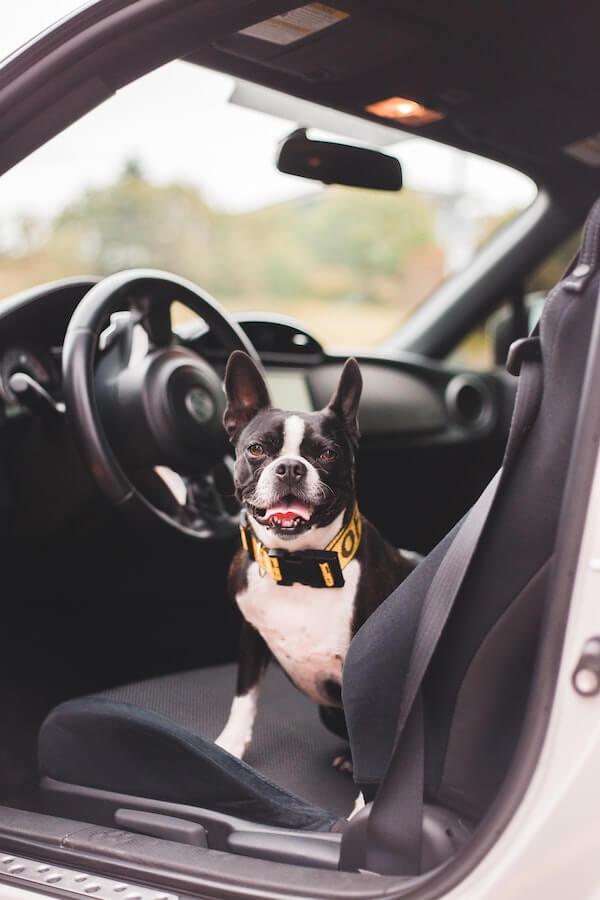
You know how tired you are after a full day of work or school (or both!), and all you want to do is well... nothing?
Using your brain is exhausting, and mental stimulation is just as important as physical exercise.
Teach your dog something new, work on a new trick , or give your pup a fun puzzle or enrichment box , just do something that makes them use their brain!
Here are a few toys that can help with mental stimulation 👇
- Snuffle Mat : Fill with treats and let your pup forage for them!
- Pure Focus Lick Mat : Spread with peanut butter, pumpkin puree, etc., and then freeze it. You can even stick it to your car window!
- SodaPup Dog Toys: Like a Kong, you can fill these with treats, peanut butter ( xylitol free ), and even a bully stick and give to your pup!
Related Reading: Mental Stimulation for Dogs
4. TAKE FREQUENT BREAKS
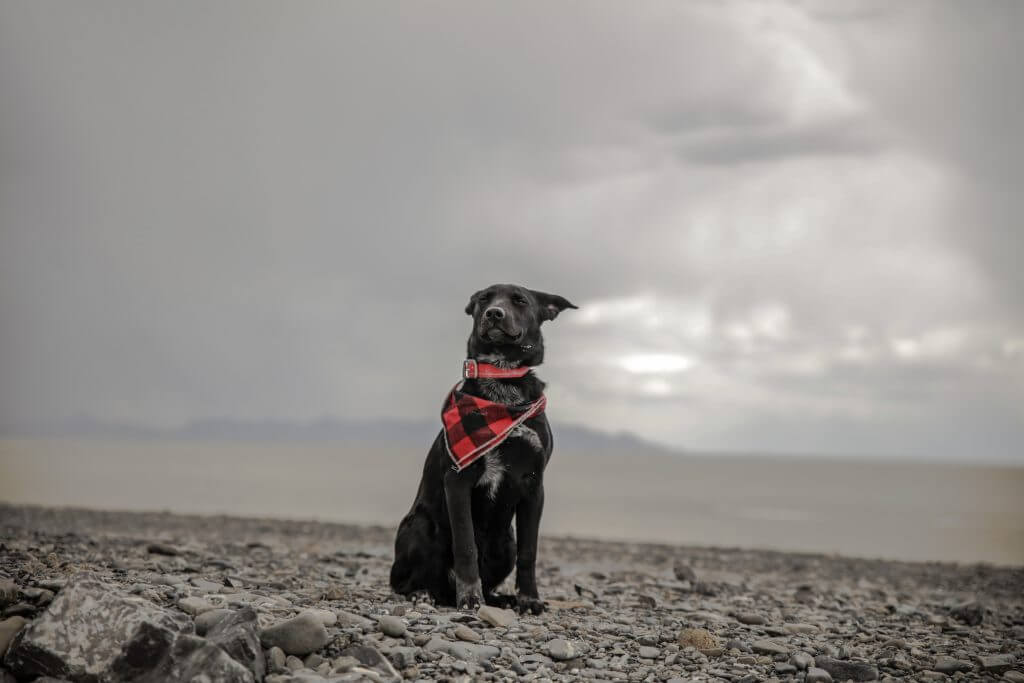
Give your dog a chance to use the restroom whenever you stop! Give them water , let them stretch etc. While our dog is wonderful 90% of the time, I know that if I am sick of being in the car, chances are he is as well.
We usually drive for 2-4 hours, stop, let him go to the bathroom, walk around with him, give him water and a treat or meal depending on when we stop, and then get back to it.
5. FIND A DOG-FRIENDLY HOTEL TO STAY AT
There are some websites that will let you know how pet-friendly certain places are. You can also filter results on hotel websites to say “allow dogs”.
But make sure to actually look at the fine print. Some places will say they allow dogs but then only allow one or two dogs up to 20 pounds. AND, some places will charge an extra fee for pets!
My dog doesn’t always do well when staying at unfamiliar locations for the night. We always try to bring his dog bed , his blanket, or something else with familiar smells to make him feel more comfortable in this new environment.
6. STOP FOR FOOD/ACTIVITIES
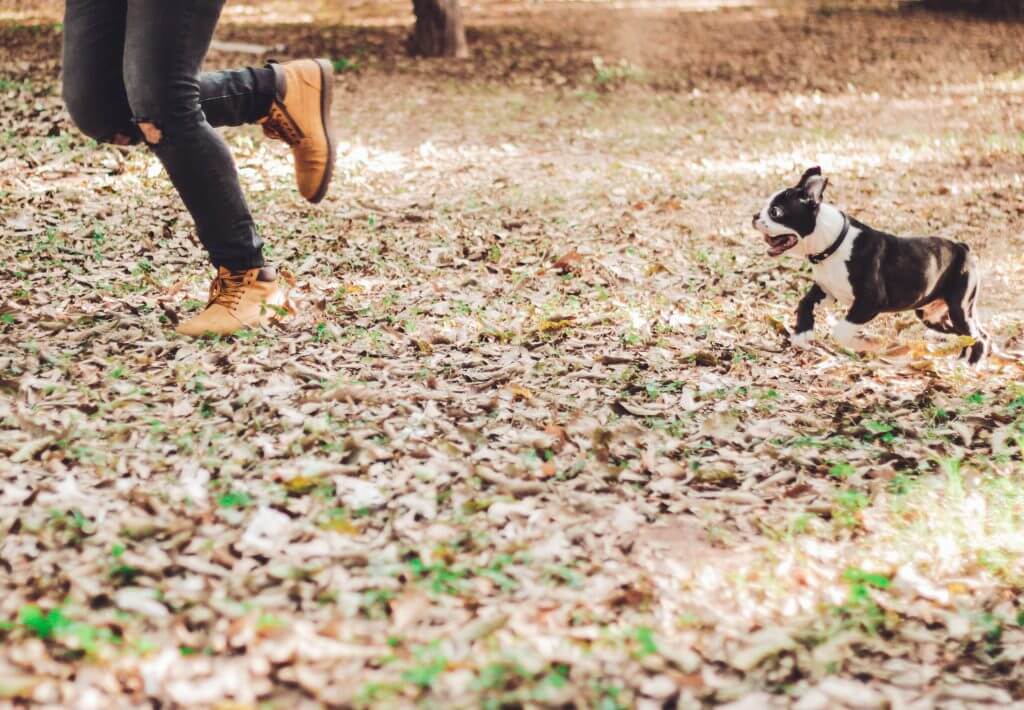
If you will be driving through a city/town and want to spend some time there before moving on, look for dog-friendly outdoor seating options at restaurants, and look for dog-friendly parks, trails, farmers markets, and more!
Some cities, like Portland, are very dog-friendly and have so many options that you can all go together! Again, check out bringfido.com or another similar website with reviews on different pet-friendly activities.
As far as hikes go, most National Parks don’t allow any dogs besides service dogs , but a lot of state parks will allow dogs on a leash no longer than 6 feet . Just do your research so you aren’t totally bummed when you get there.
7. DOG ROAD TRIP SAFETY MEASURES
Without getting into specifics, there are a lot of sad things that can happen to our best friends in the car, so extra precautions should be taken while driving with your pups.
Here are some of the main ones we recommend for your long car ride with your puppy or dog:
- Don’t roll the window down all the way (or even let them out the window!)
- Strap them into a crash-tested safety harness
- Or put them in a crash-tested kennel
Whatever you decide, make sure that it is tested and effective. We just want the best for our furry friends, right!?
OVERVIEW OF TIPS FOR DRIVING WITH A DOG
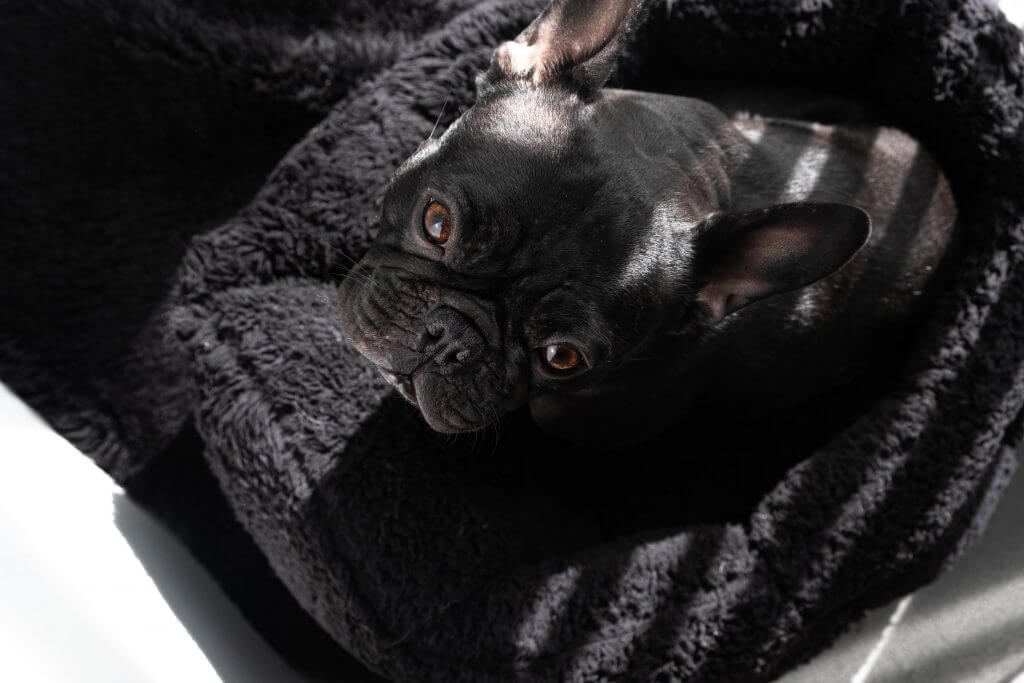
I have been asked multiple times by people at rest stops, on the side of the road, or in a gas station when driving with our dog, “How he is comfortable driving with us?” “How did we do it?” “What can I do?”
If you are one of the ones struggling with this, know that you are not alone. While many dogs love the open road, there are also so many that don’t feel so comfortable there. But good news, there are things that you can do and try to help your pup feel better on the open road.
HOW DO I GET MY DOG LESS NERVOUS TO RIDE IN THE CAR?
Here are a few tips for getting your dog more comfortable riding in the car:
1. Associate drives with something good. Whenever we take our dog in the car, he is excited. That is because he knows he is going to be able to go on a hike, go to the park, or an open field (maybe even the pet store to pick out a treat).
Associating positive and fun things with drives has made it so he looks forward to going places with us.
2. Keep special treats or toys in your car that they only get while in the car, that way there will be something special for them to look forward to!
3. Desensitize your dog to the car. You may need to start by just getting your dog okay with being around the car, then move in the car with the door open, then close the door. Then desensitizing them to sounds of windshield wipers, turn signals, honking, and more. Once they are comfortable with that, go on a really short drive. Then you can slowly increase duration!
Check out our video with Amber Aquart in Pupford Academy for tips on car safety and desensitization!
4. Practice good "car behavior." While in the car make sure to reward good behavior. If your dog is calm while in the car, reward that! If you honk a horn and they remain calm, do that! Be sure to reward the good!
MY DOG GETS CAR SICK, WHAT CAN I DO?
While car sickness can be more common in puppies than adult dogs because their eardrums haven't developed all the way, it can still happen as an adult dog.
Here are some signs your dog could be experiencing motion sickness:
- Excessive drooling
- Yawning or panting
- Smacking/licking lips
Things you can do help with car sickness in dogs:
- Open up the window slightly for a little breeze
- Keep the car cool and well ventilated
- Let your dog face forward (if possible)
- Limit your dog's food consumption prior to travel
- Ask your vet about medications for your dog
HOW DO I MAKE MY DOG COMFORTABLE IN THE CAR?
As we mentioned earlier, desensitization can be really helpful here! Familiarize your dog with the car before setting off anywhere. Go in the car with them, give them treats, and praise them.
They may need some time to become comfortable here, so try this multiple times (maybe even daily) for longer periods of time each time. Then when they are doing better, take them somewhere close like a park or on a hike; then work up to longer rides.
Slow and steady wins the race here.
EXTRA WAYS TO KEEP YOUR DOG BUSY DURING CAR RIDES
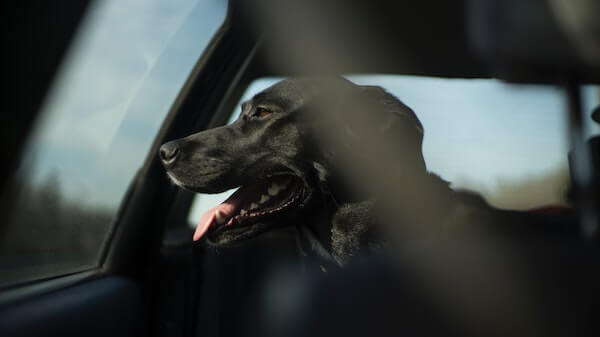
Dog chews are a seriously powerful tool for keeping your dog busy during car rides.
Whether they are a powerful or casual chewer, proper chews can keep them happy for extended periods of time.
We carry a range of Yak Cheese Chews for Dogs , Beef Tendon Chews, Bully Sticks & Split Elk Antler Chews.
Check out our full line of long-lasting chews, part of the Engage Line here.
RECAP OF HAVING A SUCCESSFUL ROAD TRIP WITH A DOG
While a long road trip with a puppy can seem daunting, it's completely possible if you follow these tips and tricks! Remember that every dog is different and some just don't handle long car rides as well as others.
Here are the 7 tips to make your next road trip with your dog more enjoyable and successful:
What else have you done to make your road trips more enjoyable with your pup? Tell us in the comments!
0 Comment s
Shipping & taxes calculated at checkout
Skip Navigation
Where To Buy Sign Up & Save

- FIND THE RIGHT FOOD FOR YOUR DOG
SHOP BY AGE
- Adult (1-6) Dog Food
- Adult (7+) Dog Food
- Adult (11+) Dog Food
SHOP BY BRAND
- Prescription Diet
- Science Diet
- Bioactive Recipe
COMMON HEALTH CONDITIONS
- Food & Environmental Sensitivities
- FIND THE RIGHT FOOD FOR YOUR CAT
- Kitten Food
- Adult (1-6) Cat Food
- Adult (7+) Cat Food
- Adult (11+) Cat Food
- Skin & Food Sensitivities
- Our Company
- Nutritional Philosophy
- Sustainability
- Ingredients
- Quality & Safety
FOR PET PARENTS
- Information for New Pet Parents
- Articles and Education
- Puppy Nutrition
- Kitten Nutrition
COMMUNITY SUPPORT
- Food, Shelter & Love Program
- Natural Disaster Support
- Shelter Partners
- Pet Adoption Resources
- Contact Hill's
- Frequently Asked Questions
- Chat with Us
- Press Releases

COMUNITY SUPPORT

Transportation and traveling
- new-pet-parent
Learn more about Hill’s commitment to sustainability
Find food that fits your pet’s needs
Find a dog food that fits your pet’s needs, find a cat food that fits your pet’s needs.
Transporting your puppy

Dog crates are the safest and most comfortable way to take your puppy along for the ride. Before purchasing a carrier or crate, talk with your veterinarian to ensure the size is appropriate for your pet. If your puppy will grow to 55 pounds or more, you may need a smaller crate for the first few months and then transition to a larger crate as your puppy grows.
Traveling with your puppy
These days, there are many opportunities to take your puppy with you on fun adventures. In fact, many hotels and resorts make a point of letting you know that both you and your pet are welcome.
It almost goes without saying, but whether you intend to take your puppy on a trip near home or away, you should ensure he has the correct vaccinations before traveling, and that they're up to date. If you're in any doubt, consult your vet.
Be prepared
It's essential that your puppy is fit and healthy before he travels. However, during long trips dogs can become sick and show signs of stress. If your dog doesn't travel well ask your veterinarian about travel sickness remedies or something to help calm your dog. You should also ask your vet to recommend any veterinary clinics in the area where you are traveling, should the need arise. You can also find this information by searching HillsPet for nearby veterinarians .
Just before you leave
Your puppy should be fed well in advance of any travel. If this isn't possible, you may like to consider putting off feeding time until you arrive at your destination.
Check that you have your puppy's favorite Hill's® puppy food , water, puppy treats , toys and the proper paperwork for your puppy, if required, and always ensure that he's wearing a collar and identification tag.
Your puppy should always be transported in complete safety, preferably in a crate designed for this purpose, in which your pet should be able to stand up and turn around, and sit and lie down comfortably. If it's not possible to put your puppy in a crate, he should be securely placed in the back of the car in a special dog seatbelt or harness.
Stopping for a rest
If you're going on a long journey, take a break; stop the car and let your puppy have a drink of water and a little exercise.
If you're making a short stop, for a meal or a bathroom break, never leave your pet unattended in the car. It doesn't matter what the weather is outside; this is not a habit to get into. You may think that your car is in the shade and may have left the window partly open, but the sun's position changes throughout the day. Your car may have been in the shade an hour ago, but could be in the full glare of the hot sun by the time you return.
Traveling With a Dog or Puppy on a Road Trip
Dr. Bartley Harrison is a veterinarian with more than 15 years of professional veterinary experience treating dogs, cats, rabbits, ferrets, birds, and small mammals, with a specific focus on Emergency Medicine. Dr. Harrison is part of The Spruce Pets’ veterinary review board.
:max_bytes(150000):strip_icc():format(webp)/Bartley-04eef3b80b55445b9684616139b9239e.jpg)
What Does Your Dog Need?
- Training and Preparation
- Medical Needs
- Mental, Emotional, and Physical Toll
Traveling the four corners of the United States and beyond is a great passion for many people, and traveling cross-country with your dog can take the experience to whole new heights. Despite your love of road trips, though, it's important to prepare well in advance before deciding if a road trip with your dog is a good idea.
Even the most seasoned car-riding dog may not be comfortable if it's stuffed in the back seat of a car for 12 hours as you traverse the country. Preparing your dog (and yourself) for the trip before it rolls means that, should an emergency arise, you can predict how your dog will handle it and ensure you both stay safe and healthy.
Just like you wouldn't head out on the road without a solid snack stockpile, you shouldn't bring your dog on a road trip without substantial preparation. Read on for our tips for preparing to travel with your dog or puppy on a road trip.
The basic necessities seem easy: dog food and medication (if your dog takes medicine). But that is not all. What is the dog going to eat out of? Where do you store the food? What about water and dog bowls ? This all takes up precious space in your vehicle.
The best solution is to get a 10-pound sealable food bin for the food, and then within the spare space within the bin, pack any medications. You should also include a Ziploc bag containing vet records, food bowl, water bowl, and collapsible travel water bowl.
Comfort Items
Some dogs, especially young ones, will need comfort or enrichment items. Little puppies need to eat several times a day since they are growing at such a fast rate. Pack some snacks for use between meals. Include a couple of good chew toys (especially for teething puppies), and some comfy bedding for them to stretch out on. As for enrichment items, some dogs might be content with a familiar toy or chewable item, but think about what will keep your dog occupied or distracted during a bout of bumper-to-bumper traffic. If your dog is a fan of peanut butter, this might be a good time to take a spoonful and stuff it down a hollow toy. Dogs can get distracted for hours trying to get to the very last lick of the stuff.
A Sweater or Jacket
You need to think of the climate that you are traveling to. Will it be cold? If you have a dog with a thin coat, no undercoat, or very little body fat, your dog could get cold very easily , so pack a dog sweater or jacket.
Training and Preparation for the Road
Before taking your dog on a country-wide tour, you have got to make sure they are a good canine citizen. Good dog behavior should refined by practicing the following skills:
- Politely walking on a leash without pulling
- Not jumping up on people upon meeting and greeting
- Waiting to get out of the car until released
- Socializing with new dogs
- Coming back to you in an emergency situation
Off-leash vocal control of your dog is essential if your dog is ever unleashed outside.
These behaviors do not have to be perfect, but some are absolutely essential, like waiting to jump out of a car when prompted. If you get a flat tire, pull over to the side of the road, and open your door and your dog automatically follows you, it can be a disastrous situation so close to fast-moving traffic. You need to teach your dog to wait—it will be important for your dog’s safety and mutual happiness if you work on each of these behaviors before starting your road trip.
Medical Preparation
Before travel, make sure that your dog is up-to-date on vaccines and that you have a hard copy of those records. It would also be prudent to get a health certificate from your vet. Health certificates are required to fly a pet anywhere and may be helpful if you are confronted by law enforcement about your dog’s health.
It helps to get a thorough physical before you leave. This way you can feel confident that your dog is in peak health before you travel to the unknown and without a regular, known vet to immediately take your dog to.
Travel Practice
Start small and build up your dog's car rides. Start with nearby daily short car rides to work or the park. Then, gradually build up to hour-long car rides to fun places like to a lake or another park. Usually, within an hour from any major city is a nice mountain, river, or lake that would be a great day trip. If your dog has not been on many long car trips, make a point to try one or two that last 5 to 10 hours in duration. Make sure to get a dog seat cover to put on your car's seat to protect it from dog hair, drool, muddy paws, and toys.
The Mental, Emotional, and Physical Toll of Traveling on a Dog
Your goal should be to make travel fun for your dog. Before getting in the car, make sure the dog is properly exercised and a bit tired. A great tip: The day before you go on a long trip, treat your dog to a full day of doggy daycare. Not only is it good for the dog, but it allows you to load up the car and clean the house without a dog underfoot. While you do your thing, your dog can play with dog friends all day (perhaps even with a bath or spa time). You can get all the things you need to do done without stressing out the dog, and the dog is good and tired for the car ride the next day. It’s a win-win situation.
Once you hit the road, take regular bathroom breaks so your dog can stretch its legs and sniff a new state. Treats should be a regular reward for being a good car pal. Keep things fun to make sure that your four-legged companion will always want to hop in the car for the next leg of the adventure.
More from The Spruce Pets
- The Best Cat Carrier For Road Trips Is Crash Test Certified
- The 8 Best Dog Car Seats and Restraints, Tested With Real Dogs
- The 6 Best Dog Seat Belts for Your Next Road Trip
- The 11 Best Travel Water Bowls for Dogs, Tested by Our Experts And Real Dogs
- The 10 Best Dog Seat Covers Tested With Real Dogs
- The 10 Best Calming Aids for Dogs To Help Soothe Any Anxiety
- The 5 Best Wagons for Outdoor Adventures With Your Dog
- How to Travel With a Rabbit in a Car
- The 11 Best Dog Carriers of 2024, Tested and Reviewed
- 8 Tips to Make Traveling with Pets Much Easier
- The 13 Best Chew Toys for Puppies of 2024
- The 51 Best Gifts for Dogs and The People Who Love Them
- The 5 Best Dog Crates for Puppies, Tested and Reviewed
- How to Cure Car Sickness in Your Dog
- How to Solve Your Dog's Fear of Car Rides
- The 9 Best Dog Pens of 2024, Tested and Reviewed

- Introduction
Can puppies travel in the car?
How to teach a puppy to ride in a car, how to keep your puppy safe while travelling in the car, use a crate or a dog barrier, don’t let your puppy travel in the car with the head out the window, hot weather precaution, include frequent breaks for long car journeys, what to do if your puppy is anxious about car travel, car sickness in puppies.
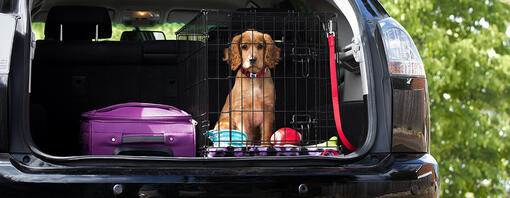
Puppy Car Travelling Tips Every Owner Should Know
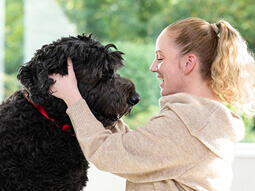
Turn your new puppy into an excellent travel companion.
You’ve got a new pup and you can’t wait to show them the world. We know the feeling! But before you start planning that amazing road trip together (or even getting ready to drive to the vet’s), you have to remember that a car can be a very strange thing to a puppy. The closed space, the car movement and even the engine sound can trigger alarm bells for a puppy not used to travelling. But there are a few things you can do to make car trips easier to bear for your pup. Who knows, maybe they will even start looking forward to them! Here are the basics of car travelling for puppies.
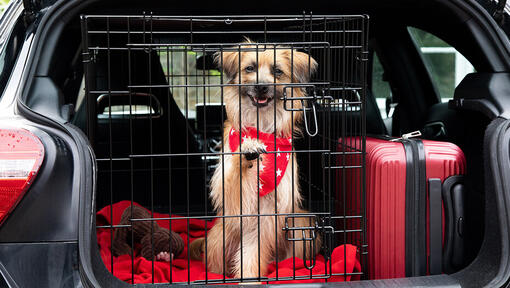
Yes, puppies can travel in cars, but different dogs will get different experiences out of it.
While some puppies bound in and out of cars without a care in the world, others find car travel a little nerve-wracking. Thankfully, there are many things you can do to make your four-legged friend feel more comfortable.
When taking your dog in a car the secret is to make them feel confident. The more confident they are, the more comfortable and less stressed they’ll be. As with so many things with dogs, the sooner they experience travel, the better. Ideally, you want your puppy to get used to cars as soon as you bring them home.
For more useful tips and guides on puppy training , read our helpful guide.
Start with them sitting in a stationary car. They need time to have a sniff around the pen or area they will be confined to and feel comfortable before you start the engine. Once they’re happy, move on to the next step.
Drive together to the end of the road and back. Give them praise and rewards at the end of the journey for riding quietly in the car.
The foot well or boot is actually better for puppies to sit in than on your car seat. They'll find the journey easier if they have somewhere comfortable to sit and lie down, especially as you go around corners.
Assuming all goes well, you simply go on longer or more frequent trips as your puppy’s confidence grows. Be slow and patient and you should soon start to make progress.
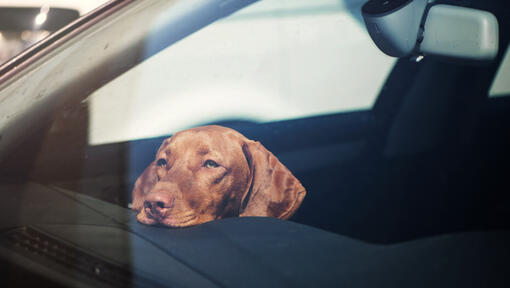
Dog car safety isn’t just about keeping your puppy protected; it’s about taking care of the driver and passengers too.
Take time to train your puppy to be calm and quiet in the car so they don’t distract the driver or cause a nuisance to other people in the car.
If your puppy is sitting in the foot well or boot, use a crate or dog barrier to keep them safely contained. If this isn’t possible and your only option is to have your puppy sitting on a car seat, make sure they’re wearing a harness. Harnesses are like dog seat belts; they come in different sizes and attach onto ordinary car safety belts. A harness can take a bit of getting used to so you might want to give it a trial run in the house first, giving your dog lots of praise for wearing it, before you use it for real on your journey.
It might look like great fun, and probably is, but if you do it too much they could get an eye irritation or, worse, get injured by something you drive past. There’s also the risk that they could slip out of their harness and jump out of the window. It’s absolutely fine to open the window a little bit so your dog gets plenty of fresh air, and on hot days you can use a window guard that lets you open the window more without allowing your dog the chance to jump out.
If the weather’s hot you can also buy shades that attach to the windows to prevent strong sunlight coming in. Both the window guards and the sunshades are great for when you’re moving but even with the windows down and the sunlight protected, cars can heat up very quickly. NEVER leave your dog in the car on warm days, even in the winter, as it can be fatal.
If you’re going to be travelling with your dog over long distances, make a habit of stopping every couple of hours. You’ll probably both appreciate a toilet break, a drink of water and the chance to stretch your legs – just always ensure that your puppy is wearing their collar and ID in case they escape.
If your puppy gets particularly nervous in the car ask your vet about using synthetic pheromones which are available in different formats – including dog bandanas! The scents are believed to be similar to the reassuring pheromones that mum will have emitted naturally when they were a puppy, so it should calm them down and keep them relaxed for around four hours.
Also try to provide them with some kind of familiarity in the car to make them less stressed, such as a favourite toy or a rug that smells like home. This is especially helpful for young puppies.
Car sickness in puppies is very common although some dogs do grow out of it. If your furry friend gets queasy in cars it makes sense to put down waterproof sheeting where they tend to sit or lie and always carry lots of paper towels and a cleaning spray in case they’re ill.
A car sick puppy is an unhappy puppy – and no one wants that – so don’t travel when they’ve got a full stomach. It’s best to hold off feeding your dog for two to three hours before you travel as a precaution and always give your dog a walk just before you set off so they’re not anxious about having an accident. If car sickness becomes a frequent problem, ask your vet for their advice.
Remember to be patient and aim for gradual progress. Soon your puppy will become familiar with the car and know what to expect when they hear the door shut and the engine running - a great journey with a travel companion they love and plenty of off-key sing-alongs.
Discover more useful guides for welcoming your new pup home and make sure you’ve got all the basics right from vaccinations to neutering and puppy microchipping .
Explore our puppy food:
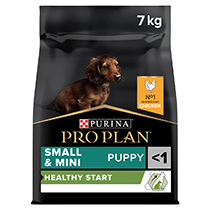
PRO PLAN® Small and Mini Puppy Healthy Start Chicken Dry Dog Food
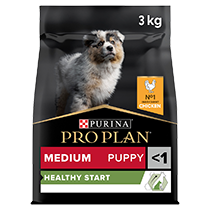
PRO PLAN® Medium Puppy Healthy Start Chicken Dry Dog Food
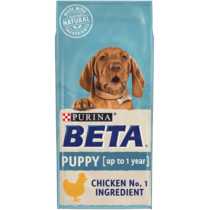
BETA® Puppy Chicken Dry Dog Food
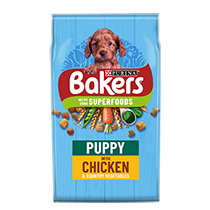
BAKERS® Puppy Chicken with Vegetables Dry Dog Food
New puppy read these next:.
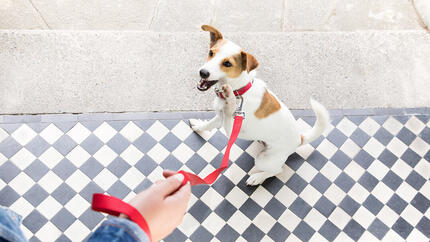
All About Puppy Microchipping
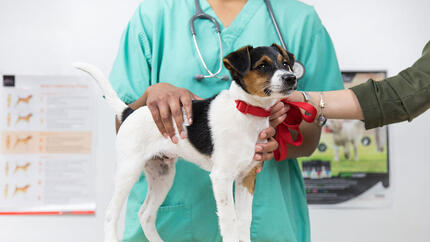
Vaccinations for Dogs and Puppies
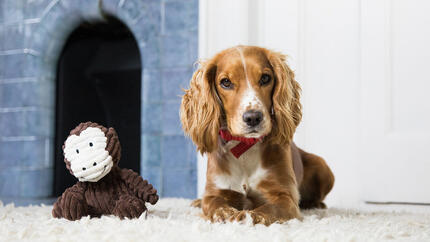
Dog Sitting and Daycare
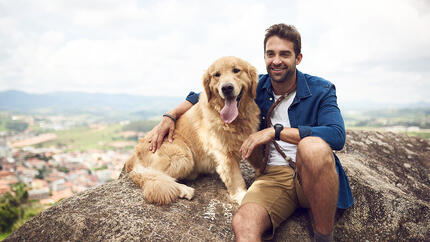
Travelling with Dogs: The Full Checklist
Join our free puppy programme.
Take the worry out of puppy parenting! Get weekly, pawsonalised puppy advice delivered straight to your inbox and receive unrivalled access to our expert team of in-house vets, behaviourists, and advisors.

Everything To Know About Safely Traveling With a Puppy

In This Article
Bringing home a new puppy is an exciting time. He’s a new member of your family, and you want him to be included in everything you do—especially traveling. Fortunately, the puppy stage is the best time to get a dog comfortable with all aspects of traveling. It’s typically easier to desensitize a puppy to new things that older dogs may already fear, such as car engines, plane noises, city sounds, or trucks.
While you may want to start taking your puppy on trips right away, it’s important to plan your travel while keeping your pet center of mind. Here’s what to know about traveling with a puppy so it goes as smoothly as possible—both for you and your new pup.
Before You Leave
Before you even leave for a trip with your puppy, there are a few important things you should do to prepare. The level of preparation will depend greatly on how long the trip is and where you’re heading.
1. Introduce Your Puppy to the Car
Cars can be scary for dogs when they’re not used to them, so it’s important to make your puppy feel as comfortable as possible. This begins by simply introducing your pup to the car well before he’s going for a ride.
Let him walk around and sniff the car. Allow him time to get comfortable in his area of the car and get settled in.
Once he feels comfortable in his spot in the car, turn on the engine. As soon as he seems comfortable with the sound (this may take some time), take him for his first ride. This should be a short ride, just to the end of the street and back. Give him plenty of praise and treats for riding quietly.
As he gets more and more comfortable with car rides, start to gradually increase the distance he travels in the car.
It’s important for your puppy to feel stable in the car. The seats can often make puppies and dogs feel insecure because they’re soft, which can make them feel off balance. Dogs often feel more secure on the floor or in the trunk of an SUV, because the floor is solid and they have a more stable grip. Do NOT put your puppy in a closed-in trunk, such as in a sedan.
2. Gather Your Gear
Once your pup is comfortable in the car and you’re planning your first trip, make sure you have all the items you need for him.
Crate or dog barrier . This helps keep your pet safely confined during travel and provides a firm surface for your pet to stand on so he feels stable during travel. Be sure the crate is large enough for him to turn around and lie down. Bonus: If you’re staying somewhere overnight, the crate provides your dog a safe space to sleep. Be sure to crate train your puppy prior to putting him in a crate in the car.
Harness and dog seatbelt . Always use a harness with the dog seatbelts, and never attach a seatbelt to your dog’s collar. If he slips off the seat while you’re driving, it can pull on his neck, and he may not be able to get back up to loosen it.
Two leashes —your regular leash and a spare, just in case
Collapsible water and food bowls
Baby wipes to clean him in case of an accident
Blanket or bed
Pet first aid kit
Doggles (dog goggles)
Interstate and international travel also require additional documentation, such as a health certificate. The needs vary depending on your travel destination, so look up all requirements through the Animal and Plant Health Inspection Service information from the United States Department of Agriculture (USDA) .
It’s important to check this information as soon as you know your travel dates. Getting the required documentation can take anywhere from a few days to months, depending on where you’re traveling.
3. Have Up-To-Date ID
Be sure your dog has a name tag on his collar with your contact information, and double-check that it’s securely attached to his collar. Also make sure he not only has a microchip , but also that the contact information associated with it is up to date.
Dogs are also more likely to get lost when traveling because they’re in unfamiliar places with lots of new distractions. If he does become lost, it’s much easier for someone to contact you when all your info is current on his name tag and microchip.
4. Address Preventative Care
Depending on where you’re traveling, there may be different recommendations for preventative care for your pet. Diseases are not evenly distributed throughout the world; certain areas are more prone to certain disease processes.
Talk to your vet about where you’re traveling so you can make sure your pup has all vaccines and preventative medications he needs before you hit the road. Do this sooner than later, as some vaccines can take a few weeks to provide protection for your pet. There’s nothing worse than your puppy getting sick with a preventable disease while traveling!
Talk to your vet about where you’re traveling so you can make sure your pup has all vaccines and preventative medications he needs before you hit the road.
During Your Trip
Now that you’ve done everything to prepare for your trip, here’s how to travel with your puppy safely.
1. Keep Your Puppy Safe
When traveling with a puppy in the car, he should be restrained in a crate or with a dog harness seatbelt. This helps prevent him from becoming unstable and falling when turning, and it also helps keep him safe in the event of an accident.
Puppy-proof your car before traveling. It’s important to make sure there’s nothing dangerous he can get into, such as loose objects he could potentially chew or choke on while traveling.
You also shouldn’t let your dog stick their head out the car window as you drive. It can cause his eyes to dry out, get something stuck in them, or become scratched on the surface. If your puppy tolerates dog goggles, these can make him safer.
Along with danger to his eyes, there’s the risk he slips out of his harness and jumps out the window. It’s best to keep the window closed as you drive.
2. Exercise Before Traveling
Exercise not only physically exhausts puppies, but it can also mentally exhaust them (depending on the type of exercise). Tired puppies are much more likely to remain calm and sleep throughout the trip. This can make the whole travel experience much smoother for both you and your pup.
3. Make Frequent Stops
How frequently a puppy needs to go to the bathroom depends on how old he is and how much water he’s consumed. In general, puppies can hold their bladder for a length of time equal to their age in months plus one. So, a 2-month-old puppy can hold his bladder for about three hours.
It’s recommended to stop for potty breaks every two or three hours when traveling with a puppy. This allows him to go to the bathroom, stretch his legs, and have a water break.
4. Manage Car Sickness
Puppies can get carsick , but it’s important to distinguish whether they’re truly car sick or if they’re just anxious in the car , as these are treated differently.
Some of the most common signs of car sickness and anxiety are excessive drooling , whining, crying, and vomiting . If this starts soon after getting into the car, it’s likely anxiety-related. But if symptoms begin a little while into the car ride, your pup is likely car sick.
Car sickness is common in puppies, and fortunately they often outgrow it. In the meantime, there are several things we can do to help treat and prevent motion sickness.
Keep the car cool and comfortable.
Open the windows. Fresh air can help alleviate nausea for your pup, just as it does for people.
Avoid feeding your puppy within two or three hours of travel; traveling on a full stomach can make him more nauseous.
Take him for a walk prior to traveling so he feels less anxious about potentially having an accident.
Give him medication. Several medicines can help with nausea in the car. Talk to your veterinarian about trying the medications below, and never give your puppy medicine without a vet’s guidance.
5. Regulate the Temperature
Dogs are much more prone to overheating in cars than people, and puppies are especially sensitive to temperature changes. This is because their bodies aren’t as good at regulating their temperature yet.
Given how quickly cars can heat up when they’re just sitting in the sun, dogs (especially puppies) should never be left in a car alone. Similarly, in winter, puppies are also at risk of freezing if left waiting alone in a car.
Cars don’t only get hot or cold when you’re parked. The temperatures can also rise or drop drastically while driving. To help keep your pup comfortable during the summer, open the windows a little to allow more airflow. If you keep your air conditioning on, be sure it flows to him; the back of the car is often much warmer than the front seat.
You can also consider window shades to help prevent direct sunlight from shining on your puppy. These are especially important if you crate your puppy in a plastic or metal crate, as these can heat up rapidly when exposed to direct sunlight.
Dogs are much more prone to overheating in cars than people, and puppies are especially sensitive to temperature changes.
In winter, keep your heat on and consider providing your puppy with a blanket to help keep him warm during travel. Check on him frequently, and remember that just because you feel comfortable does not mean he does.
After You Arrive
When arriving at a new destination, acclimate your puppy to the area. Take a walk around, showing him the yard and the home or hotel room where you’re staying.
Show your puppy the new location of his water and food bowls. Lay his toys out for him so he knows he has something to play with. A familiar crate to sleep in can also help him feel much more comfortable while traveling.
Check the new place for any dangers to your puppy, too. If there’s a fenced area, walk him around the perimeter of the yard on a leash, and make sure there are no breaks or holes in the fence where he could escape. It’s best to keep him on a leash until he gets used to his new environment.
While this may seem like a lot, a safe and smooth trip often means an incredibly fun trip! Traveling is an amazing experience for animals and provides them lots of positive stimulation, further strengthening your bond with them.
Featured Image: Getty/Eva Blanco

Veterinarian
Dr. Brittany Grenus graduated from Tufts Cummings School of Veterinary Medicine in 2018 with her doctorate in veterinary medicine and a...
Help us make PetMD better
Was this article helpful?
Related Articles

Subscribe to Our Newsletter
Sign up for weekly pet health tips and insights from our veterinarians.

- Forum Listing
- Marketplace
- Advanced Search
- Just Labradors Forums
- Labrador Training Tips and Puppy Advice
Question about a long car trip for new puppy
- Add to quote
We are getting our puppy in about 2 1/2 weeks! He will be 10 weeks old when we bring him home. The problem is, our breeder is 10-11 hours away (not including the many puppy stops). I was wondering what suggestions anyone may have for having a pup in the car for such a long time. I know we will need to make lots of stops (any suggestions on how often? I was thinking every 3 hours or so, is that enough?). How about feeding and watering? Should I continue with his normal schedule, and just allow for the extra stops 20-30 minutes after doing so? I obviously will also be talking to the breeder about any suggestions she may have. She is aware how far away we live, and offered to give us a smaller travel crate for the trip for him (that way we don't have to take out a seat in the van for the regular size crate). But I thought some of you may have traveled long distances to get your pups and was curious of your experiences and tips. We leave in a week and a half to travel up there. Coincidently we had planned a vacation for near where the breeder is prior to finding her. I expanded my search from our state to a 5 state radius, and the timing worked out perfectly to get this fellow on the way home from our vacation (he'll be older than the normal 8 weeks, but we'll visit him several times during our trip before we bring him home). So we'll have a van full of 2 adults, 3 kids, and a new puppy! Any suggestions for this "road trip" home would be greatly welcomed!
conrad said: one thing to keep in mind is to stay away from obvious doggy stops - there may well be bugs and disease in the ground that you just don't want your unvaccinated (at least partially) baby exposed to Click to expand...
We leave early tomorrow morning for our vacation. We'll visit our boy on Friday or Saturday, and then will pick him up probably Thursday of next week for the trip home (unless I can convince my DH to come back earlier). Can't wait to get him home! Any final suggestions before we go? How often do you suggest stopping to let him out for potty breaks? I was planning on stopping about every 3 hours. Does that sound right for a 10 week old? Also, my husband read to skip meals for the puppy for car trips, offering only water, due to car sickness. Is that okay? It'll take about 11-12 hours (due to the frequent stops). That seems a long time with no food....
Sleeping pup, keep going. No stopping when sleeping. Puppy starts to fuss, emergency brakes, you won't get much warning. Probably good plan would be to stop as soon as he wakes. Unfortunately, for interstate highway travel, that does not mean the next rest stop or exit. It means now. Should get an immediate pee, give a few minutes to coax out a poop. I have never had a dog that got car sick, maybe others have. 12 hours? I think that pup needs some food. It will promote more sleeping.
When I went to get Harlee (3 hrs away) the breeder sent her home without any food or water and she was fine. This turned out to be from about 8am (when he got her up) until 1pm before we got home. She cried during the drive home and I assume it was because she was hungry. Because the puppy is only ten weeks it will go to the bathroom very soon after it eats so you could stop at least once or twice to feed. I am no expert (Harlee is 16 weeks) but thought I would offer my opinion! Karolyn
With a very young pup, I'd stop every hour and let her out on a leash beside the road for a brief walk. With my first Lab (Bess), as a 5 week old pup, she rode the 80 miles home wrapped in a swaddling towel** in my wife's lap. That soothed her. With Puff (@ 9 weeks age), we had 170 miles to travel home. I had a small crate and Puff sounded far beyond most unhappy to be in it and made that audibly known every inch or millimeter we travelled. Finally, after 15-20 minutes of interminable, grating howling and protests, I swaddled her in towels** and put her on my lap. That quieted her immensely. She needed that body contact with a living being to feel secure. Just something to consider. ________________________ ** Towels -- just in case there are/were bladder leaks.
Every hour Bob Pr?!?! The normal trip with 2-3 quick stops is 10-11 hours (about 700 miles)....I guess it's going to be a long day! We do have towels in the car, I did think about that and figured he may end up on my lap if being in the crate bothers him, so I put some in there just in case (I'll probably want to hold him anyway!). That's a good idea about stopping to feed him. We'll just plan a longer stop about that time to let him eat, get a little play out, and then go to the bathroom. I know places such as doggie parks, etc. wouldn't be good. Any suggestions on where to stop? Are rest stops okay? Or should we stick to fast food restaurant's small grassy areas? It is all interstate/turnpike driving, and unfamiliar territory, so I wouldn't know where else to stop....
You need to be careful where you take your pup because it hasnt been vacinated. Make sure you don't go near any poop and try to keep the pup away from any dogs. You will be surprised how much the puppy will sleep, it will cry a bit but I am betting it will go right back to sleep. If I were you I would keep going til the puppy wakes up!
I know places such as doggie parks, etc. wouldn't be good. Any suggestions on where to stop? Are rest stops okay? Or should we stick to fast food restaurant's small grassy areas? It is all interstate/turnpike driving, and unfamiliar territory, so I wouldn't know where else to stop.... Click to expand...
- ?
- 19.8K members
Top Contributors this Month
Bringing a Puppy Home in the Car – Super Easy Guide
Getting a new puppy is a really exciting time! One of the first experiences your puppy will share with you is the car ride home. Bringing a puppy home for the first time can be scary if not handled well; follow these tips, and your new puppy will have the best experience possible.
If you’re bringing a puppy home, you’ll first want to start getting things ready at your house. If possible, it’s best to schedule a time when you’ll be able to be around the house for a few days to get your pup adjusted to its new environment. A long weekend is a great time to do this. You won’t want to have too many people around or much on your schedule that will take you away from home.
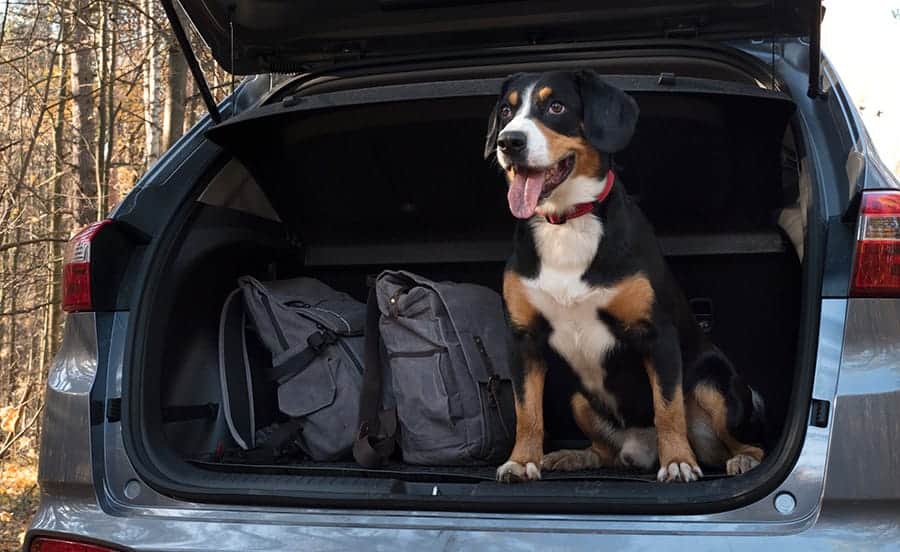
Clean – Before bringing your new dog home, make sure to clean up a bit. They’re going to want to explore everything in their new environment. Their natural approach to examining will be to pick or chew objects that are sitting around. Everything can be a toy! Hide your shoes and other things they might grab.
Remove harmful materials – As you’re cleaning, put away any chemicals you might have. If you have oil or fertilizers in the garage, put them away. Anything with a smell will be particularly interesting.
Check your yard – Don’t forget to check your yard for any hazards, toys, plants, or other things you don’t want your pup chewing on.
Shopping for a New Puppy
You’ll want to be able to head straight home with your puppy, so go out ahead of time and get the supplies you’ll need at home. If you just read our new puppy checklist you should be set, but if not, here are some things to consider:
- Food (dry puppy food usually; check and see what they are currently eating)
- A crate (see crate tips below)
- Food and water bowls
- Toys to chew
- Rawhide, treats, etc
- A collar & leash
- Paper towels
- Pet odor neutralizer/cleaner – (I like Nature’s Miracle brand )
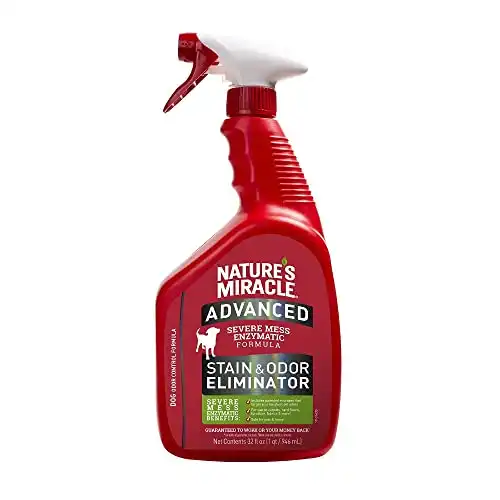
Once you have everything, take a quick walk through your house and make sure everything is ‘puppy-proofed’. New pups can be chewers, and you’ll want to make sure they don’t get ahold of anything they shouldn’t.
Crate Options
There are two primary options for a dog crate: wire & plastic. I’d lean more toward a plastic crate for a small dog and a wire one for a large dog… but either work; check out the advantages:
Wire (check out size options here ):
- folds flat (especially important if you buy a large crate & don’t have a truck)
- cheaper, especially at large sizes ($20 – $60)
- fast setup/takedown
- usually comes with an extra panel so you can size the crate to the dog instead of having to buy a new one if you continue using the crate as your dog grows
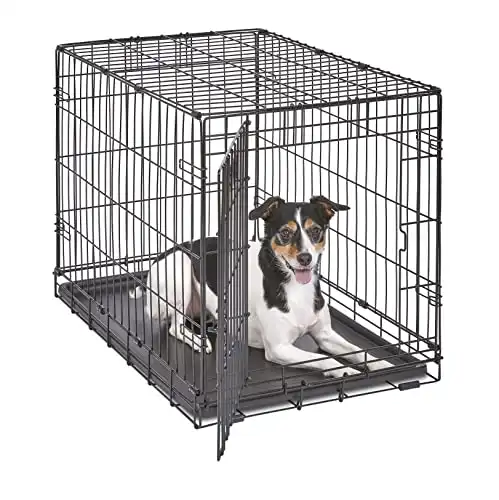
Includes Leak-Proof Pan, Floor Protecting Feet, Divider Pane l & New Patented Features
Plastic (check out size options here ):
- bulkier to transport
- more expensive ($30-$200)
- easier to carry for small dogs
- more darkness/privacy
- nicer looking
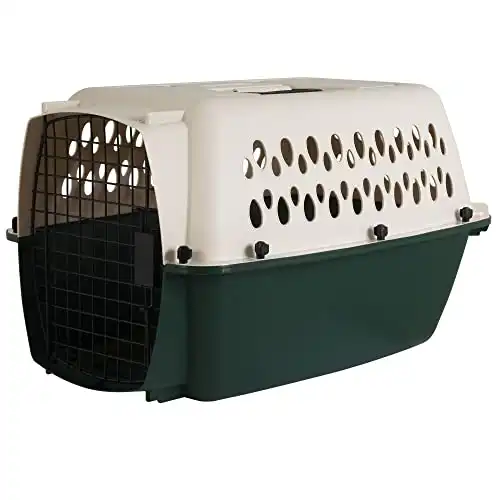
360-degree Ventilation, 26", Green, Made in USA
Picking up Your Puppy
When you head to pick up your puppy, you’ll want to bring along some treats, something to chew, a blanket/towel, the leash & collar, poop bags, and cleaning supplies (in case there is an accident). If you can, bring someone with you to keep the puppy occupied while you drive. Ideally, your pup would be able to take this ride out of his crate under someone’s supervision, but if not, you can crate them.
When you pick them up, make sure you’ve got all the paperwork and know the current feeding schedule and type of food being used. Often, you can get a sample of their current food to continue feeding them or integrate it with the new food they will be eating. Make sure they aren’t being fed right before you head out to help avoid any sickness.
Before you put your pup in the car, it’s a good idea to take them for a walk to tire them out a bit for the ride and to let them go to the bathroom. When you put on a new collar, make sure it’s tight enough so it doesn’t slip over their head. It may seem tight at first, but having just 2 fingers able to fit when it’s around their neck is a good measure.
Bringing a Puppy Home – The First Car Ride
If you can, have the puppy sit in the back seat with someone else. You can encourage them to get in the car by putting a treat in there. You want to make the experience as pleasurable as possible so they are comfortable going on car rides in the future. Barking or crying is normal for a pup on this new experience, and you should reassure them calmly. Don’t reinforce their fear by becoming overly excited or overly affectionate. Your passenger can hold them in a blanket, or you can set them on a blanket on the seat to protect your car. If they’re uncomfortable, you can put them between the seats on the floor (it’s more like a den to them). Also, you can give them something to chew.
If you’re taking your puppy for a long drive, you can stop along the way to walk them and let them go to the bathroom but don’t stop at a highway rest stop or park. Your puppy probably hasn’t been vaccinated, and you won’t want them to go where lots of other dogs have been to the bathroom to keep them healthy.
Once you’re at home, make sure to bring your puppy outside so they can go to the bathroom, and remember to be calm and comforting. Let your puppy explore their new environment at their own pace.
Here’s a video from Doggy Dan showing his puppy’s first ride home and covering some of these tips for bringing a puppy home:
Now that you’ve got your puppy home you’ll want to get them on a schedule and begin to establish yourself as their new pack leader and start in on training.
More Puppy Guide Articles
Share this post:, recommended for you:.

Puppy Guide – All the Steps to Raising a Puppy
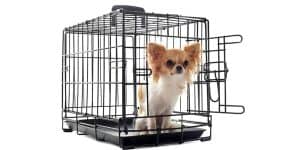
How to Crate Train a Puppy in 7 Simple Steps
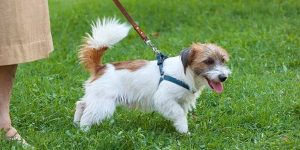
Puppy Socialization & Training
Kyle J. Larson
Our car ride to pick up our 8 week old puppy is 6.5 hrs one way. Obviously, I’m going to have to make stops for fuel, coffee and bathroom breaks. Should I feed or water my puppy at all on that 6.5 hr trip home? If so, how long after ingestion should I stop to take the puppy potty? Also, if we get home at 7 pm or later, should I feed and water my puppy, or is that just going to result in a 2 am potty break?
i think those are questions to ask the breeder regarding at what times they need to feed. each puppy is different. i would personally let them eat, walk them for about 15 mins, and then get back into the car. a full, tired puppy will want to nap for a bit, and as soon as they wake up, stop for a potty break immediately.
Hi next Friday I’m bringing my new puppy home . Should I get a blanket and get my scent on it so she can have it in her crate ?
Is that not dangerous to have them in the front while you’re driving? Surely it would have been better for him to be in the back with your wife?
We are picking up our 8 week old lab and have a 3 hour drive. Is it ok to hold him in a blanket that has been scented with the litter?
That should be fine, best to sit in a back seat and make sure someone is always available to attend to the pup (vs having the driver do it).
What brand is the dog bed? Thanks!
Leave a Reply Cancel reply
Your email address will not be published. Required fields are marked *

Subscribe and get the free guide... 5 things you need to know about raising a puppy!

How to Bring Your New Puppy Home in the Car
As events go, it doesn’t get much more exciting bringing a new puppy home for the first time. Your puppy will typically be 8 weeks old when you bring her home for the first time. For both you and your new family member, this is a once-in-a-lifetime experience, so it’s important to get it right.
What’s so complicated about bringing your puppy to their new home?
For starters, the new dog needs to get off on the right paw and begin bonding with you. Then there are safety aspects to car transporting such as how to keep your dog safe on the journey home. Also, what should you do if the puppy whines? How often do you need to take a comfort break? How should you prepare for the car ride home?
Our Top Recommendation for Safety and Comfort:

- Travel In Style - Ever wanted to see the sights or go on hikes with your furry friends? This...
- A Reliable Frame - If you want support and stability without sacrificing portability, this...
- Smart Storage & Assembly - This travel crate should fold down perfectly flat so that you can store...
Options for Bringing Puppy Home
Think of how a new baby travels home from the hospital. These days you’re expected to strap the newborn into a crash-tested travel seat that is appropriately attached to the vehicle’s seat belt system, and the airbag disabled if in the front seat. This is all about keeping the precious new life safe in the event of a crash.
A new puppy is no different from a newborn baby: Both are helpless, both are dependent on you, and both are a huge distraction to the driver. As a dog owner, when it comes to car safety the legal obligations are less onerous than for transporting children, but the dangers are similar.
In the case of an emergency stop, an unsecured puppy becomes a mobile missile with the potential to fly through the windscreen with devastating consequences. Ultimately, how you transport a new puppy home in the car is up to you, but responsible owners make sure it is done in the safest possible way for all involved.
The options for bringing a new puppy home include:
- A cuddle on a lap: Most comforting for your puppy who might be scared.
- A cardboard box: A cheap and effective option
- A cat carrier or dog carrier: A safe option
- A dog seat belt: The safest option, but may be uncomfortable for the puppy for the first trip.
Each option has advantages and disadvantages, let’s consider these in more detail
A Safe Journey Home
Firstly, let’s look at what not to do..
Do NOT let the puppy romp loose in the vehicle, most especially if you are driving on your own. Whilst they may sleep soundly on the front seat for part of the journey, if they wake up they can pose a huge distraction.
It only takes eyes-off the road for a few seconds for a collision to happen. Your pup might be flung through the windscreen and be badly injured. Then there’s the risk of the puppy jumping down and getting stuck under the brake pedal… so just don’t go there.
Begin Bonding
We highly recommend brining a friend or family member go with you to pick the puppy up. If you have children who are old enough to act calmly and responsibly, then they can be a big help. Plus, the puppy bonds to the people they encounter early on, so this is a great way to build future trust.
Backseat Companion
Many people, for understandable reasons, just want to cuddle the puppy on their lap. If this is your option, then sit in the back seat. Again, this is less of a distraction for the driver. If the passenger on cuddle duty is determined to sit in the front, then disabling the airbag is advisable. A deployed airbag may smother the puppy…but of course, in an accident, the pup then becomes the passenger’s airbag – hence the recommendation to sit on the backseat.
Wrap the puppy in a blanket, specifically one that smells of the mum, as this will give much-needed comfort and a sense of security at this time of change. Remember that the puppy will be anxious, scared, and nervous on being separated from its mom and with all the new sights and sounds. This can easily get overwhelming, so any technique to comfort the pup will make your journey much easier.

A Basic Box
For a tiny puppy, an old-fashioned cardboard box maybe all the new dog needs for car travel. Line it with newspaper or puppy pads (in case of accidents) and a blanket that smells of the mother. Then use the car seatbelt to strap the box securely in place. However, cardboard boxes do have a habit of getting soggy if puppy pees or poops, so a more durable alternative is a pet carrier.
Dog Carriers
A dog or cat carrier is a great solution for safe travel. These confine the puppy in a cosy den-like space to help them snooze the journey away. They also offer some protection in the event of a crash and prevent the pup from becoming a missile. Secure the carrier onto a seat with the seatbelt. Again, the back seat is the best option, but if you want your puppy to ride in the passenger seat, then disable the airbag.
For a long journey, most dog carriers come equipped with water bowls, so the pup can have a drink should they be thirsty. If a dog crate or carrier sounds a good idea to you, then check out our top 6 recommendations .
For the larger puppy where a dog carrier might be a squeeze for the four-legger, then consider a safety harness. These are dog harnesses that are strong enough to withstand the force of a crash and can easily connect into the car’s safety restraint system. In the event of a crash, keep the new dog secure and spreads the force of the impact over their body, minimizing the risk of injury.
The main disadvantage to this is that the puppy almost certainly won’t be used to wearing a harness, and may, therefore, be confused or distressed by wearing it for the first time. However, a crash-tested safety harness is good choice and you can check out our recommendations in this review of the best safety devices for dogs .
Car Sickness and the New Puppy
Another problem faced by new owners on that first day is travel sickness. Even adult dogs can suffer from nausea and motion sickness, so it’s best to be prepared. Plan ahead and leave plenty of time for the journey. Essentials to pack include puppy pads, paper towels, and plastic bags. This allows for stress-free clean-ups on the move.
Simple things like keeping the car a comfortable temperature, and avoiding it being too hot or too cold can help. Perhaps crack a window open slightly to allow fresh air in. Signs a dog is feeling travel sick include drooling and hanging their head. If the dog whines and is restless, but they don’t appear nauseous, then they may need a comfort break. As a rule, if the puppy is asleep then they can hold their bladder for one hour for every month of age, plus one hour (so an 8-week old pup can hold on for 3 hours). However, if the puppy is awake, they may not be able to hold on, so plan for puddles so there’s no drama when the inevitable happens.
So there you have it. Bring your new puppy home in style, but keep them safe! How you do it is ultimately your choice, but to ensure you arrive safe and sound, spare a thought for what’s going to work best for you and the new puppy.
How long can an 8 week puppy be in a car?
Most 8 week old puppies can handle being in a car for up to 3 hours at a time. This may vary depending on the individual puppy, but generally a good rule of thumb is 1 hour per every month of age plus one hour. On your first couple of trips though, you probably shouldn’t push the pup too much. Limit the trip duration, take breaks every two hours, and most importantly, ensure your puppy appears to be comfortable and relaxed.
What to bring when you pick up a puppy?
When you head to pick up your new puppy, make sure that you have plenty of food, water, and treats, in case the little guy is hungry on the way home. You also want to bring your chosen travel carrier (if using one), some towels, poop bags, and cleaning supplies. Finally, do not forget the leash and collar!
Is it illegal to get a puppy at 7 weeks?
Yes, it is illegal to bring a pup home at 7 weeks. Puppies must be at least 8 weeks old before they can be separated from their mother.
Can a 2 month old puppy travel?
Leave a comment cancel reply.
Your email address will not be published. Required fields are marked *
Save my name, email, and website in this browser for the next time I comment.
This site uses Akismet to reduce spam. Learn how your comment data is processed .
Privacy Overview
We earn a commission for products purchased through some links in this article.
Warning for dog owners taking pets on road trips
Planning a long car journey?

Experts warn that, ideally, dogs need hourly stops on long car journeys , with the opportunity to drink, stretch their legs and go to the toilet. Breaks should be at least 15 minutes long, but the longer, the better.
- Tip 1: Create a packing list
Tip 2: Research your route
Tip 3: practice car trips beforehand, tip 4: blow off steam before you travel, tip 5: try positive reinforcement, tip 6: create a calming space in the car.
Robin Skillings, Chief Marketing Officer at Ruffwear , told Country Living : "Dogs have a natural inclination for exploration and adventure, making road trips with your canine companion a great way to not only spend more time together but also encourage you to stop at new outdoor places, potentially off-the-beaten-path."
The team at Ruffwear add: "Consider your dog’s age, activity level, and stress response to car rides. If you have health concerns about your dog, we recommend checking with your vet before travelling. You know what’s best for you and your dog – and you can make unforgettable memories no matter the distance.
"To get your dog used to the car, we recommend taking them out for short trips when they're as young as possible. It can be more challenging for a dog who has been adopted to get used to cars if this isn’t something they’ve been used to their whole life. It's important to pay attention to your dog and their individual needs."
The specialists have also shared some top tips, as well as a packing list, to ensure your dog is as comfortable as possible for any road trip.
6 expert tips for taking a dog on a long car journey
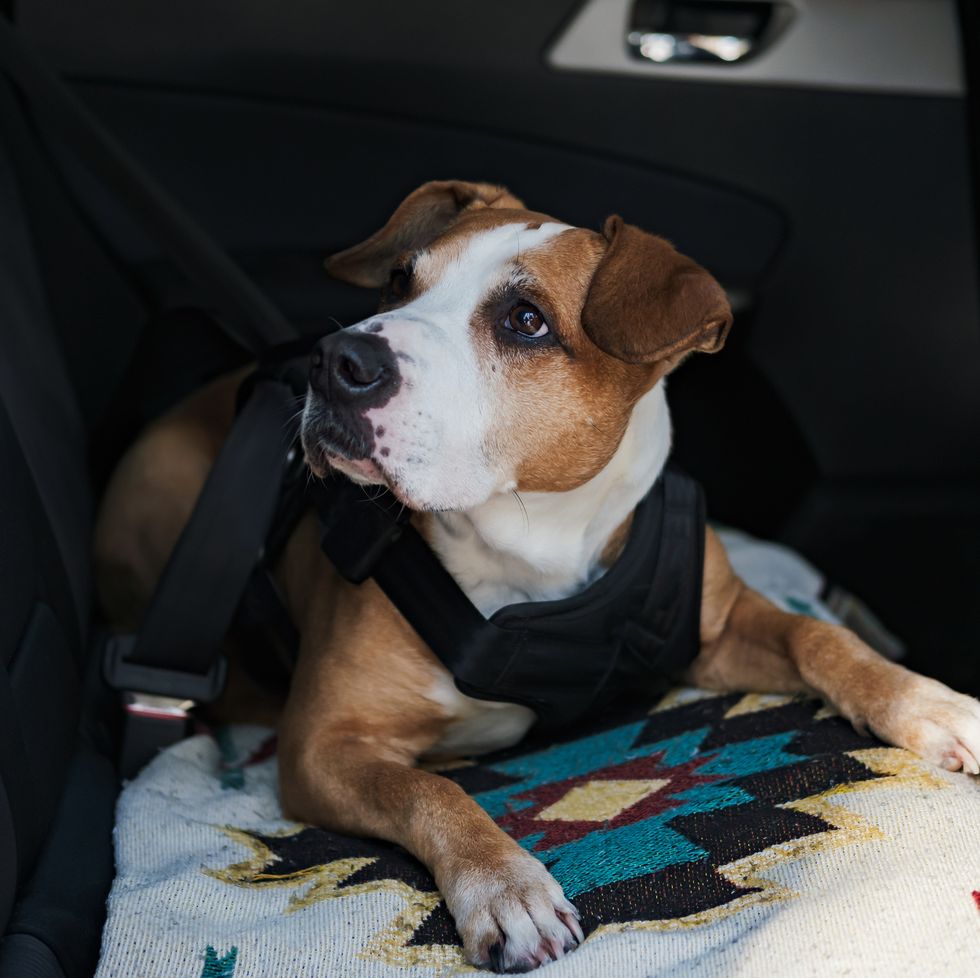
.css-1eiql25{text-align:center;margin:0rem;padding-top:0.9375rem;padding-bottom:0.9375rem;} .css-12hmvql{color:#5D654E;font-family:Kepler,Kepler-fallback,Kepler-roboto,Kepler-local,Helvetica,Arial,Serif;font-size:2.1875rem;line-height:1.2;margin:0rem;}@media(min-width: 64rem){.css-12hmvql{font-size:2.5625rem;line-height:1.2;}}.css-12hmvql b,.css-12hmvql strong{font-family:inherit;font-weight:bold;}.css-12hmvql em,.css-12hmvql i{font-style:italic;font-family:inherit;} Tip 1: Create a packing list .css-1w3y1tp:after{margin-top:0.625rem;margin-left:auto;margin-right:auto;-webkit-mask:var(--mask);mask:var(--mask);width:4.438rem;height:0.313rem;content:'';display:block;-webkit-transform:rotate(-180deg);-moz-transform:rotate(-180deg);-ms-transform:rotate(-180deg);transform:rotate(-180deg);background:radial-gradient(4px at 50% calc(100% + 1.8px),#0000 calc(99% - 1px),#B2CB7C calc(101% - 1px) 99%,#0000 101%) calc(50% - 6px) calc(50% - 2px + 0.5px)/12px 4px repeat-x,radial-gradient(4px at 50% -1.8px,#0000 calc(99% - 1px),#B2CB7C calc(101% - 1px) 99%,#0000 101%) 50% calc(50% + 2px)/12px 4px repeat-x;}
You can never be too prepared when it comes to taking your pet on holiday and having a good supply of essentials will make long journeys less stressful for everyone involved.
It also means that you're well prepared to take as many breaks as needed, without having to nip to the shops en route.
The essential packing list:
- Water and dog food
- Water and food bowls
- A few of their favourite toys
- Dog waste bags
- Towels for wet weather/swimming
- Bed and extra blankets if they need them
- Covers/towels to protect your vehicle from dirt
- Pet raincoat or other outdoor wear (if required)
Instead of breaking up your journey with repetitive stops in car parks, research your route ahead of time to see if there are any interesting spots to explore with your dog. Maybe there's a park for your pet to blow off some steam or a short trail to explore. Dog-friendly pubs and cafes are also great locations for a break.
We think you should make driving breaks part of the holiday – it can make the journey feel like less of a chore. AllTrails and Google Maps are great for discovering excursions ahead of time and can make planning your trip even more exciting.
Read now: The UK's most dog-friendly road trips revealed.
If your dog has never been in a car before, it may not be a great idea to put them in for an hour’s drive as their first experience. Unfamiliar routes can bring with them unexpectedly bumpy roads and tight bends, especially in countryside areas. Some dogs may not respond well to being in the car and could experience motion sickness or anxiety , so try to do some shorter practice runs before you embark on a long journey.
You can start with a quick five-minute trip and increase the distance each time you head out.
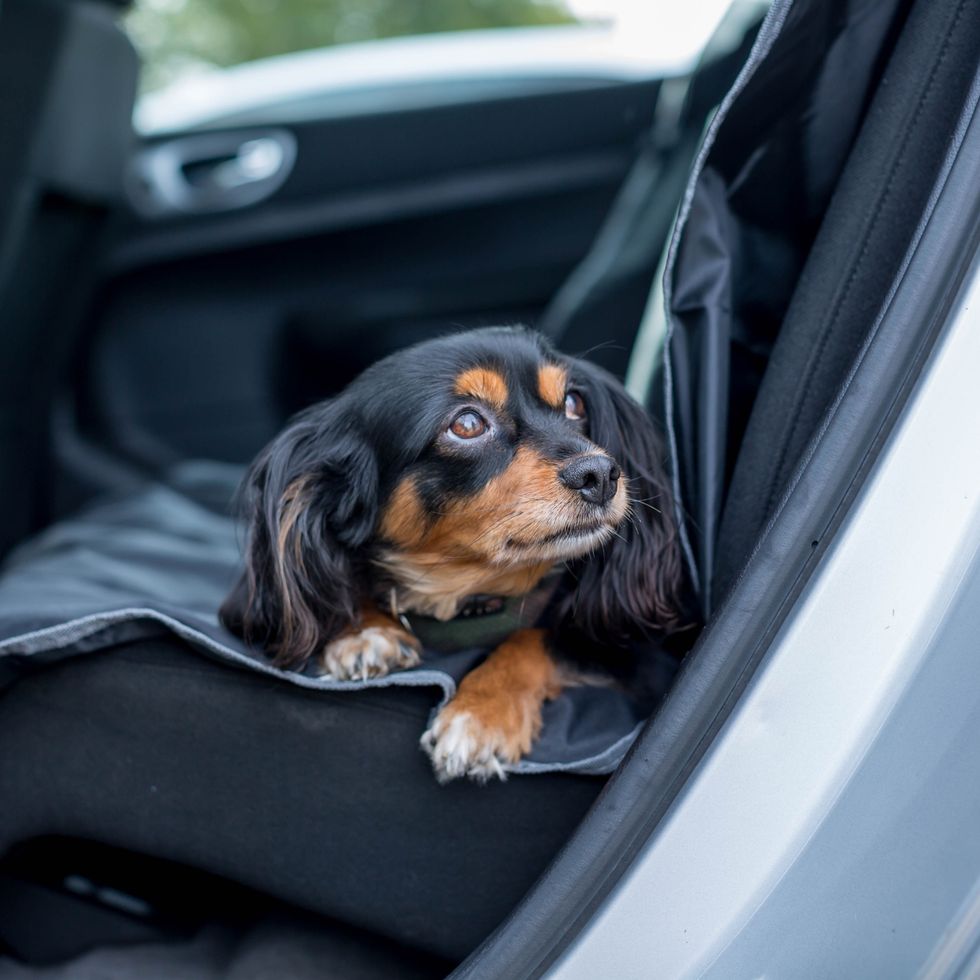
We all feel restless on long journeys, and it's the same for our four-legged companions. Taking your dog for a good walk (and if they're super active, a run) before you go on your road trip can help to settle any nerves and encourage them to sleep throughout the journey.
Make every trip in the car a happy, if not exciting, prospect by using treats to create positive reinforcement. Treat your dog when they get into your car, and frequently reward them during the journey with high-value (foods they love, but wouldn't usually get) snacks.
You can do this with your pet on your practice journeys to build up positive associations before you go on your road trip.
The highway code states: "When in a vehicle, make sure dogs or other animals are suitably restrained so they cannot distract you whilst you are driving, or injure you, or themselves if you stop quickly. A seat belt harness, pet carrier, dog cage or dog guard are ways of restraining animals in cars."
It’s ultra-important to make sure your dog is secured in your car, and if you choose to travel with them in the boot of your vehicle, you can create a calm and cosy place for them to relax. You can line their bed or car seat with blankets and other items with familiar smells. This should help to soothe them if they feel anxious.
Our favourite finds
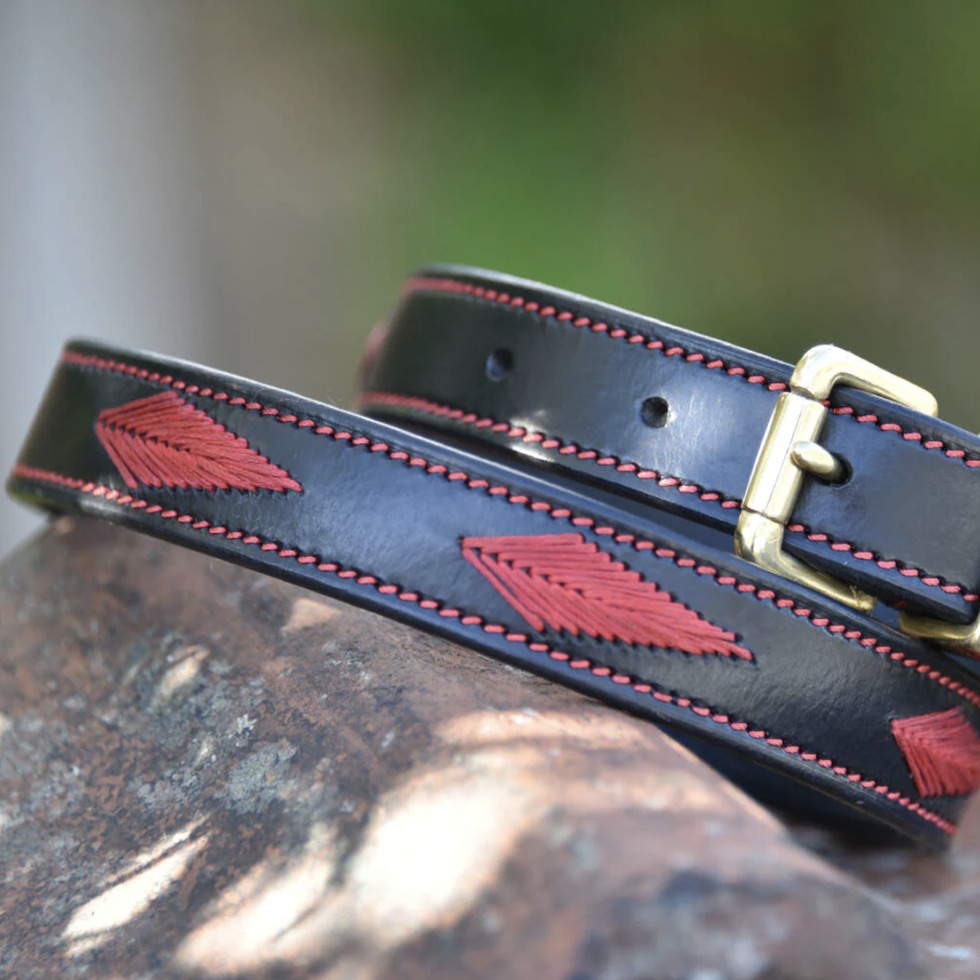
Woofgill Leather Dog Collar

Terry Towelling Dog Gown
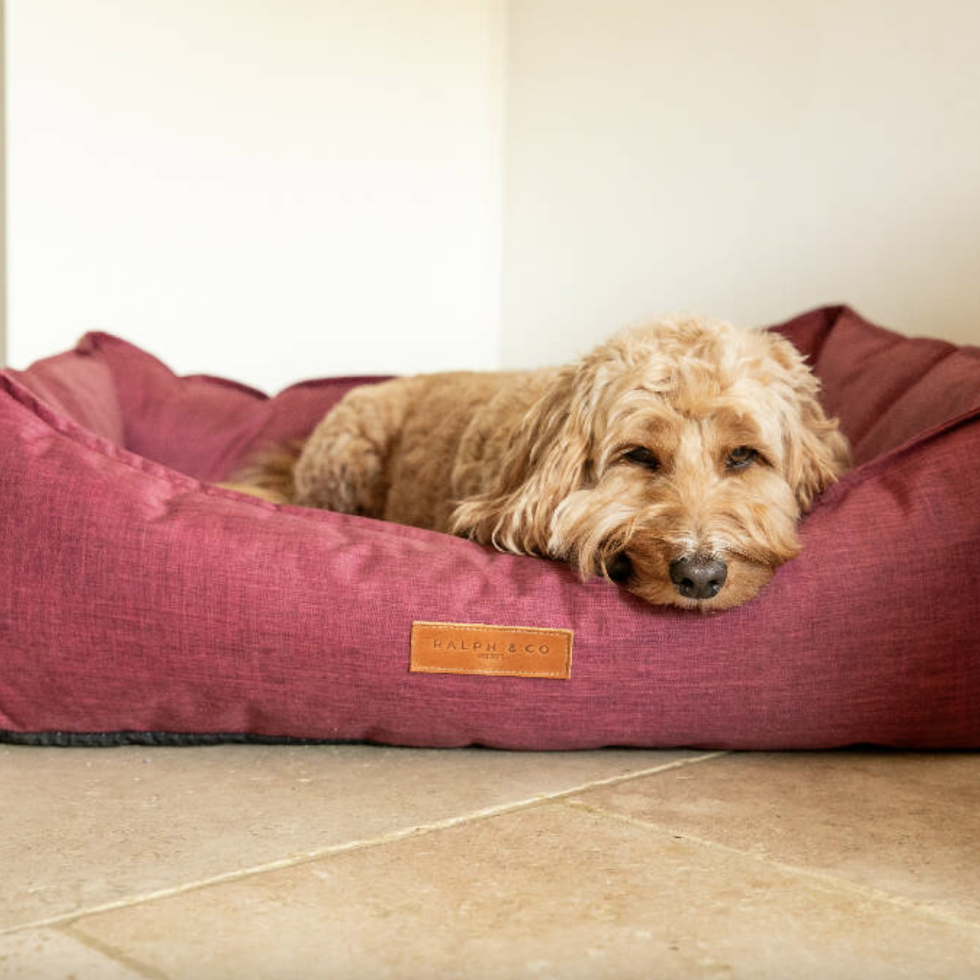
Waterproof Dog Bed Ascot
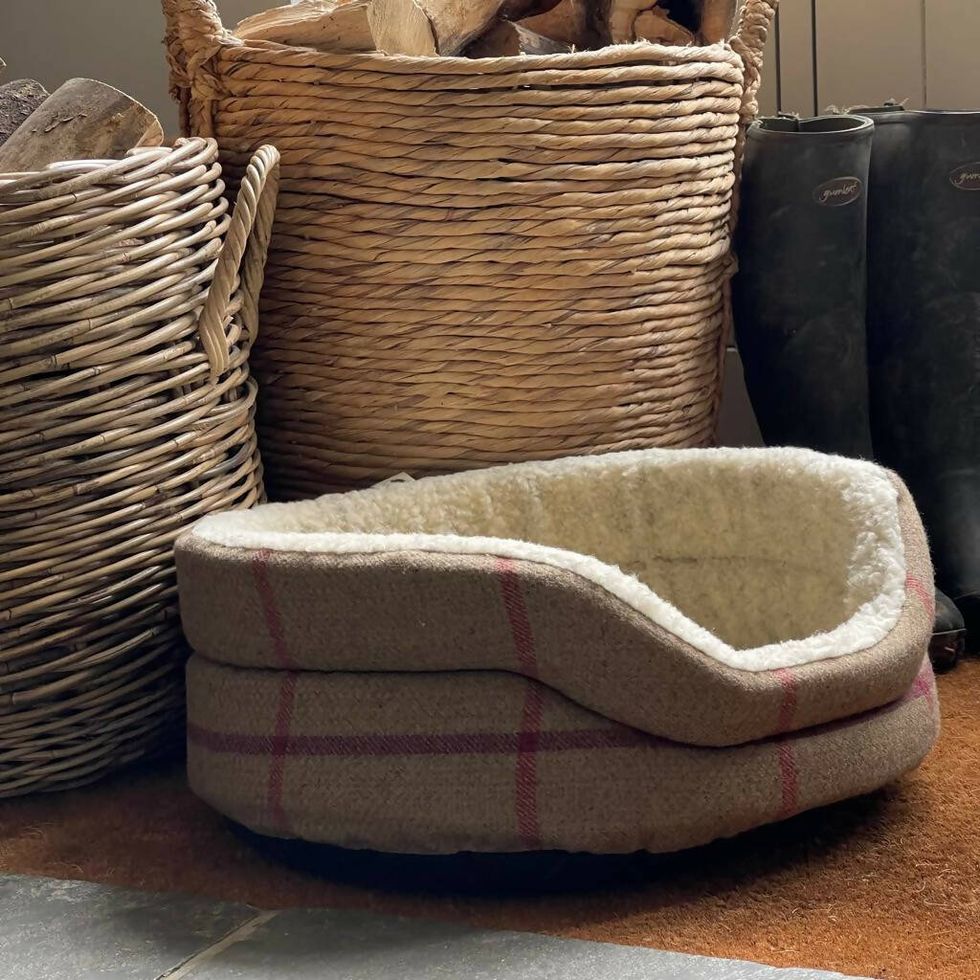
Tweed Snuggle Dog Bed

Wooden Raised Dog Bowl Stand
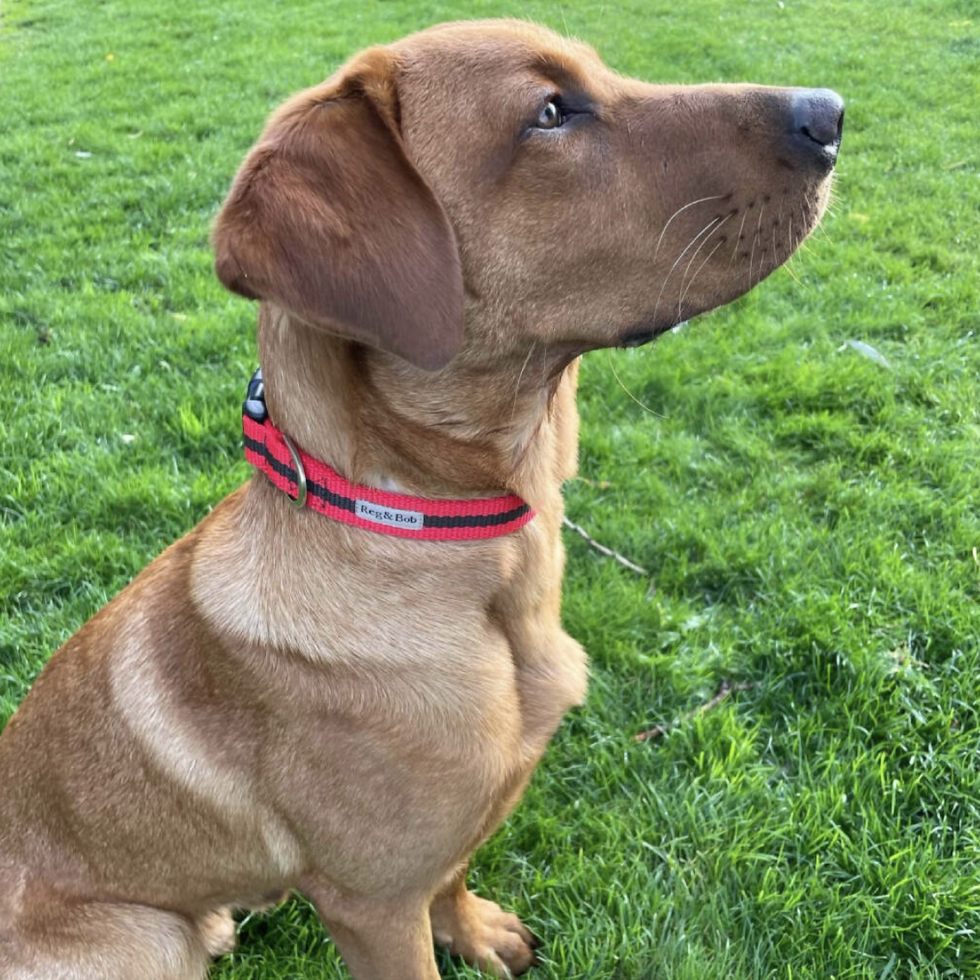
Dog Collar In Red And Brown Stripe

.css-1shyvki:before{background-repeat:no-repeat;-webkit-background-size:contain;background-size:contain;content:'';height:0.819rem;margin-bottom:0;margin-right:-0.9375rem;width:3.125rem;}.loaded .css-1shyvki:before{background-image:url('/_assets/design-tokens/countryliving/static/images/arrow.svg');}@media(max-width: 48rem){.css-1shyvki:before{display:none;}}@media(min-width: 40.625rem){.css-1shyvki:before{display:inline-block;}} Advice for dog owners .css-c08pe1:before{background-repeat:no-repeat;-webkit-background-size:contain;background-size:contain;content:'';height:0.819rem;width:3.125rem;}.loaded .css-c08pe1:before{background-image:url('/_assets/design-tokens/countryliving/static/images/arrow.svg');}@media(max-width: 48rem){.css-c08pe1:before{margin:0.7rem auto 0.9375rem;display:block;}}@media(min-width: 40.625rem){.css-c08pe1:before{margin:0 -0.9375rem 0 0;display:inline-block;-webkit-transform:scaleX(-1);-moz-transform:scaleX(-1);-ms-transform:scaleX(-1);transform:scaleX(-1);-webkit-background-position:75% 0;background-position:75% 0;}}
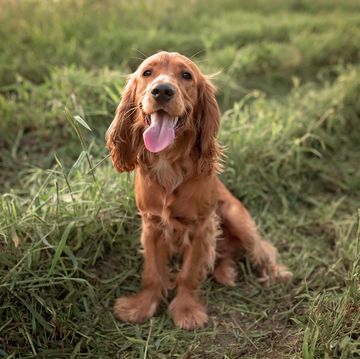
9 best hypoallergenic dogs for allergies
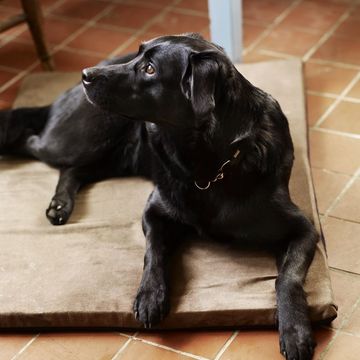
Best washable dog beds: Our 13 top picks

Jacqueline Wilson’s book was deleted by a dog
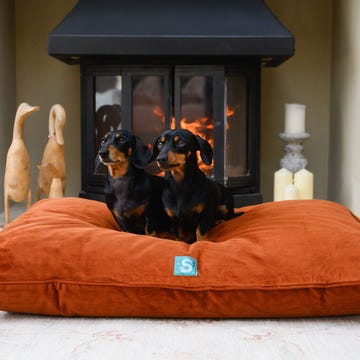
17 dog beds that are cosy and stylish

Scent training could improve your dog's behaviour
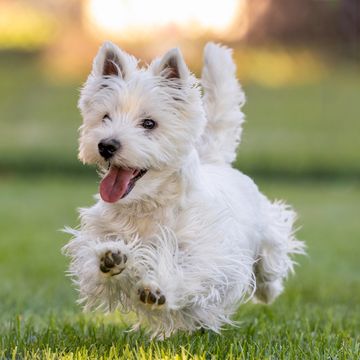
Britain's top Terrier breeds

A swimming pool for dogs has just opened
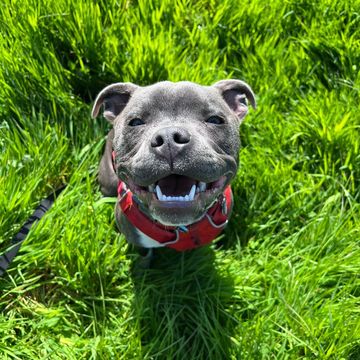
Tried and tested: a review of Marleybones dog food
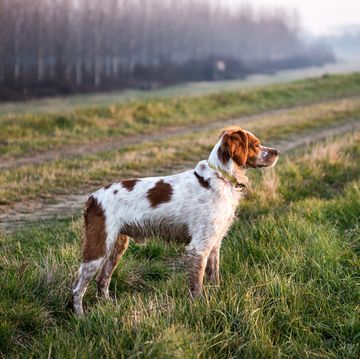
6 Irish dog breeds
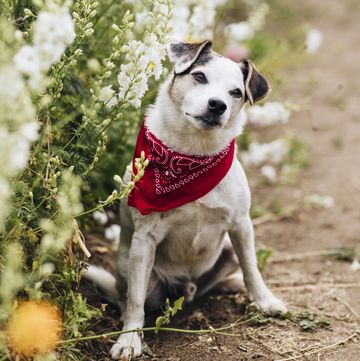
Jack Russell Terrier: 8 fun things to know
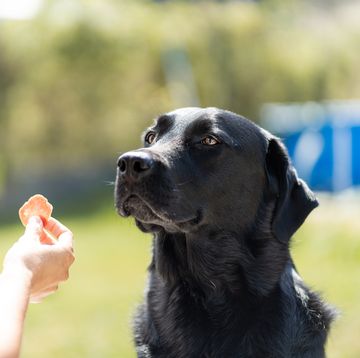
How to treat obesity in Labradors
Buc-ee’s to open new Hillsboro travel center on April 21

HILLSBORO, Texas ( KWTX ) - Buc-ee’s on Wednesday announced its newest travel center in Hillsboro will open to the public on Sunday, April 21.
Doors will open to the public at 6 a.m. and a ribbon-cutting ceremony will be held at 1:00 p.m.
The new 74,000 square foot travel center will be located at 165 State Highway 77.
In addition to offering 120 fueling positions, Buc-ee’s Hillsboro will also offer “favorites including Texas barbeque, homemade fudge, kolaches, Beaver Nuggets, jerky and fresh pastries,” a news release states.
“We’re thrilled to open our newest travel center in Hillsboro,” said Stan Beard of Buc-ee’s. “This community has been nothing but supportive and we can’t wait to welcome locals, as well as I-35 travelers (East AND West!), to enjoy all that Buc-ee’s has to offer.”
Buc-ee’s Hillsboro will bring at least 200 jobs to the area, with starting pay beginning well above minimum wage, full benefits, a six percent matching 401k, and three weeks of paid vacation.
Copyright 2024 KWTX. All rights reserved.

Neighbors upset with former MLB player building baseball field in backyard

The Great American Eclipse start time, time in totality, and the weather forecast

Businessman who brought group of 40 to Central Texas for eclipse leaves for better viewing options in Illinois

‘I can’t unsee this’: What a sight in Texas!

First Alert: Tornado watch in effect until 5 PM
Latest news.

Arrest warrant issued for Rashee Rice in connection to multi-car crash in Dallas

South Texas groups trying to stop state’s land swap with SpaceX

KWTX@4: Retired Judge Fernando Villarreal to be honored at ceremony this Friday. - 4.10.24

The Daily 4 on KWTX@4:AI grading, eclipse glasses donation locations, and more. - 4.10.24

Brady's Wednesday Evening FastCast
- Skip to main content
- Keyboard shortcuts for audio player

Solar eclipse 2024: Follow the path of totality
Thinking of taking a last-minute drive to see the eclipse here's what to know.

Geoff Brumfiel

RV traffic sits at a standstill along a two-lane road near Madras, Ore., a few days before the 2017 total solar eclipse. Experts say traffic could be heavy, but eclipse watchers shouldn't necessarily be deterred. AFP Contributor/AFP via Getty Images hide caption
RV traffic sits at a standstill along a two-lane road near Madras, Ore., a few days before the 2017 total solar eclipse. Experts say traffic could be heavy, but eclipse watchers shouldn't necessarily be deterred.
NASA says that roughly 31.6 million people live in the path of this year's total solar eclipse, and a little under half of the U.S. population lives within 200 miles driving distance of the path of totality .
That could mean many millions of Americans will hit the road to get a better view on April 8. If you're still pondering whether or not you want to make the journey, here's what to consider.
Have some destinations in mind, and check the weather and cloud cover forecasts in advance
It's a good idea to scout out one or more locations within driving distance, so that you have some flexibility if traffic or weather is threatening your plans, says Jonathan Upchurch, a professor emeritus of civil engineering at Arizona State University who has studied travel around solar eclipses.
There are several interactive tools that show the path of totality, including Eclipse2024.org and the National Solar Observatory . You can use them to figure out what sites might work best for you.
In terms of weather, check not just the weather forecast, but also the cloud cover forecast. Some websites, such as Windy.com will predict cloud cover ahead of time, giving you a sense of whether you'll actually be able to see the eclipse in all its glory.

Everything you need to know about solar eclipse glasses before April 8
During the total solar eclipse in 2017, Upchurch says he chose to go to Idaho "because there were some great chances of having sunny skies, and I had the opportunity to be nimble and relocate if I wanted to."
Before driving into the path of totality, make sure your gas tank is full and that you've got everything you need
During the last total solar eclipse in 2017, it's estimated some 5 million people took to the roads, and those numbers will potentially be much higher this year.
Given all that, Upchurch says it's important to make sure you're taking what you need into the path of totality. You should make sure your car is gassed or charged up, and that you have plenty of snacks and water with you in case you get stranded for a while, especially when trying to leave.

Solar Eclipse 2024: Totality stretches from Texas to Maine
Simple tips to safely photograph the eclipse with your cellphone.
Also don't forget to bring eclipse glasses, which must be worn anytime you're looking at the sun, except for the few minutes when it is completely blocked by the moon.
Some state emergency planners also recommend bringing a paper map or road atlas in case cellular networks become overloaded with visitors seeking directions from their phones.

Don't forget your eclipse glasses everyone! Erika Goldring/FilmMagic hide caption
Don't forget your eclipse glasses everyone!
Arrive early and stay late
Once you figure out where you're going to watch the eclipse, and you've got your supplies, try to get there early. Although traffic is likely to be heavier than normal on the morning of eclipse day, it still should be possible to reach many destinations without too much hassle, says Upchurch.
"Leaving is definitely going to be more of a problem," he says. As the eclipse concludes, people will take to the roads all at once to try and get home as fast as they can. In 2017, that led to traffic jams that lasted many hours in some areas. If possible, Upchurch says, people should stay put for a while to try and avoid the worst of the post-eclipse rush, which in 2017 stretched even into the following day in some parts of the country.

Here's what time the eclipse will be visible in your region
And one more thing: If you do find yourself on the move near the time of the eclipse, state officials stress that you should not simply pull over to the side of the road or highway you're driving on. It's important to be parked legally and safely at the moment of totality.
If you're already in the path of totality: Relax and enjoy!
Several major metropolitan areas including Dallas, Indianapolis, Cleveland and Buffalo are already inside the path of totality, so there's no need to seek a better view, Upchurch says. You'll probably have the most fun simply staying where you are.

Shots - Health News
Watching a solar eclipse without the right filters can cause eye damage. here's why.
If you're on the edge of the path of totality, however, you might consider making a short trip to get closer to the center of the eclipse's path.
"If you're within about 40 miles of the center line, you'll have two-and-a-half minutes or more" of complete totality, Upchurch says. It's up to you to decide whether it's worth making the trip to a more central location.
Despite studying the potential hassles of traveling extensively, Upchurch says he's still looking forward to seeing the 2024 eclipse, which he plans to watch from Texas.
"Totality is absolutely spectacular," he says. "If you have a chance to witness it, I would do it."
- 2024 solar eclipse
- eclipse 2024
- 2024 eclipse
- Traffic patterns
- total eclipse
latest in US News

Bipartisan group of NY pols call on Biden to finally address...

Biden tells Arizonans 'elect me, I'm in the 20th century' in...

Whiz kids from small UWS school headed to prestigious robotics...

Cornel West picks anti-cop BLM activist who called Taylor Swift...

DC mothers accused of child neglect to get cash as part of...

Multiple people shot at Philadelphia event marking end of...

Hand sanitizer, aloe gel recalled over potentially deadly...

Trump-led effort 'kills' FISA reauthorization in House —...
Waymo rolls out paid robotaxi rides in los angeles — with 50k people waiting for a lift.
- View Author Archive
- Get author RSS feed
Thanks for contacting us. We've received your submission.
Waymo is offering paid robotaxi rides to Los Angeles residents starting Wednesday after being cleared by California regulators.
Despite pushback from local officials who cited safety concerns following the self-driving vehicles’ rocky test period, more than 50,000 people are sitting on the waitlist to try out the futuristic venture.
The company did not reveal how many people will be able to use the app but last month the tech startup — owned by Google-parent Alphabet — said it was starting with a fleet of fewer than 50 cars.

The car-hire service will work similar to Lyft, Uber and Flywheel — without the driver — and cover a 63-square-mile area from Santa Monica to downtown LA.
“The reception from Angelenos so far has been exceptional, and we look forward to welcoming more riders into our service over time,” Chris Ludwick, Waymo’s product management director, told NBC .
The expansion of autonomous vehicles hasn’t been without its hurdles in the City of Angels with accidents in test runs synonymous with their inception.
The worries have been compounding in recent months, as seemingly all companies behind self-driving cars have faced safety issues — including Tesla, which recalled virtually every vehicle late last year over regulators’ concerns that its “autopilot” system is unsafe.
General Motors’ Cruise, meanwhile, is under multiple federal probes after one of its robotaxis dragged a pedestrian who had been struck by another car .

Last year, safety concerns surrounding self-driving cars heightened when an online DMV report said a Waymo car “was engaged in autonomous mode” during a deadly accident involving a small dog “which did not survive.”
“A test driver was present” in the driver’s seat, but the vehicle’s automatic driving system (ADS) was in control, per the May 2023 report.
As part of Waymo’s testing process in Los Angeles — which has been going on for the past year — the company marketed the service and taxied public passengers around the city in its fully autonomous white Jaguars during an invitation-only period.
The cars have already been operating in Phoenix since 2018 and San Francisco since 2021.
Share this article:

Advertisement

IMAGES
VIDEO
COMMENTS
This is especially important if your puppy is between 8 and 12 weeks old, known as the key socialisation period. This is when traveling with puppies is highly recommended. We will discuss this in detail below. Traveling with puppies in a car an be quite a nerve wrecking experience, for many reasons.
Gradually getting them used to your vehicle is a great way to instill confidence in your new puppy for the trip to come. Here are three steps you can take to get them familiar with your car: 1. Let them explore the vehicle: The first step is to let them explore the inside and outside of your vehicle. Let them sniff out the interior and get used ...
A long trip can be a challenge for even the most car-savvy dog. Especially for younger pups with all their extra energy. A good way to burn some energy on the road without causing a disturbance in the vehicle is to provide your dog with some fun enrichment toys like a stuffed KONG toy or a food puzzle toy that they can enjoy along the way.
1. Introduce your puppy gradually to the car. Start by introducing your puppy to a stationary car. Allow your puppy to explore their pen or the area they will be traveling in. This will help them feel comfortable, calm, and confident in the vehicle before you start the engine and drive with your puppy in the car.
Here are some useful tips for a long car trip with a puppy. Feed them before an hour you start your journey. So even if your puppy suffers from car sickness, it won't feel it that much. Also, let them drink water for an hour too. They won't feel full this way. Take your puppy to the toilet before you board the car.
1. Invest in a Quality Crate or Carrier. Purchasing a good puppy crate designed for use in the car is one of the best ways to keep your pet safe while traveling. It prevents the dog from wandering ...
Before hitting the road, it's important to make sure that everyone in the car is on board with the rules. This means no feeding your puppy table scraps, no letting them sit on your lap while you're driving, and no roughhousing in the backseat. A tired puppy is a good puppy. 3. Exercise before the car ride.
Stop Every 2-3 Hours. As a rule of thumb, when taking a l ong car ride with puppy, plan to stop every 2-3 hours. Your dog will most likely begin to get restless around that point and will want to get up to stretch his legs and go potty. This, of course, varies depending on your personal needs and your dog's needs- it might be a little shorter ...
A long car trip can be a daunting experience for you and a new puppy, but with the proper preparation (including packing the right dog-friendly gear), it can be a fun and exciting adventure. This article will discuss everything you need to know before hitting the road with your new furry friend.
7. Training Your New Puppy for Car Travel. My Dog loves to Ride on Car. A well-trained puppy makes for a more enjoyable travel companion. Practice basic commands, such as sit and stay, in a controlled environment before introducing them to the car. Gradually increase the difficulty by practicing these commands inside the parked car.
Paper towels. Bring a roll of paper towels that can be used in case of an accident. Remember, your new puppy is completely untrained and has no comprehension when it comes to using the bathroom. He may urinate or even poop during the drive home. In addition, if he is extremely nervous and gets an upset stomach from the bumpy ride, your puppy ...
If at all possible, don't make a long journey with a puppy on your own: get yourself a "Wingman". Always travel with someone else, so that one person can concentrate on driving, the other on the puppy. And if you are going to share the drive, make sure that the owner of the puppy sits with the puppy for the first leg so that they can bond.
Before we dive into each tip, here's an overview of 7 dog road trip tips: Bring the necessities and essentials. Get their energy out. Provide them with mental stimulation. Take frequent breaks. Find a dog-friendly hotel to stay at. Stop for food/activities. Safety measures. Alright, now let's look at each idea in detail. 👇.
In the car. Your puppy should always be transported in complete safety, preferably in a crate designed for this purpose, in which your pet should be able to stand up and turn around, and sit and lie down comfortably. If it's not possible to put your puppy in a crate, he should be securely placed in the back of the car in a special dog seatbelt ...
Usually, within an hour from any major city is a nice mountain, river, or lake that would be a great day trip. If your dog has not been on many long car trips, make a point to try one or two that last 5 to 10 hours in duration. Make sure to get a dog seat cover to put on your car's seat to protect it from dog hair, drool, muddy paws, and toys.
Keep your vehicle well ventilated, especially if your dog is in their crate. Turn up the cool air or air conditioner and point the vents towards your dog. Make frequent stops to exercise your dog, give them water and allow them a chance to use the restroom.
Use a crate or a dog barrier. If your puppy is sitting in the foot well or boot, use a crate or dog barrier to keep them safely contained. If this isn't possible and your only option is to have your puppy sitting on a car seat, make sure they're wearing a harness. Harnesses are like dog seat belts; they come in different sizes and attach ...
It's typically easier to desensitize a puppy to new things that older dogs may already fear, such as car engines, plane noises, city sounds, or trucks. While you may want to start taking your puppy on trips right away, it's important to plan your travel while keeping your pet center of mind.
Question about a long car trip for new puppy. We are getting our puppy in about 2 1/2 weeks! He will be 10 weeks old when we bring him home. The problem is, our breeder is 10-11 hours away (not including the many puppy stops). I was wondering what suggestions anyone may have for having a pup in the car for such a long time.
Food (dry puppy food usually; check and see what they are currently eating) A crate (see crate tips below) Food and water bowls. Toys to chew. Rawhide, treats, etc. A collar & leash. Paper towels. Pet odor neutralizer/cleaner - (I like Nature's Miracle brand) Poop bags.
The pup will probably sleep 2 hours then be awake and want to play 20-30 minutes. Keep the puppy on an old towel because there will be pee accidents. If your puppy is only 8 weeks old, he won't know he has to pee and just go. You won't have time to stop and pull over, especially being a small breed like a mini schnauzer.
Backseat Companion. Many people, for understandable reasons, just want to cuddle the puppy on their lap. If this is your option, then sit in the back seat. Again, this is less of a distraction for the driver. If the passenger on cuddle duty is determined to sit in the front, then disabling the airbag is advisable.
6 expert tips for taking a dog on a long car journey. Tip 1: Create a packing list. Tip 2: Research your route. Tip 3: Practice car trips beforehand. Tip 4: Blow off steam before you travel. Tip 5: Try positive reinforcement. Tip 6: Create a calming space in the car. Robin Skillings, Chief Marketing Officer at Ruffwear, told Country Living ...
PUPPY TRAINING! How Long Can I Travel With My New Puppy. Bringing your puppy home from the breeder can be stressful so knowing ways to deal with long journey...
The new 74,000 square foot travel center will be located at 165 State Highway 77. ... Waco man sprays neighbor with wasp spray and strikes him with baseball bat over dog dispute: affidavit. Car ...
00:00. 00:33. A deranged mother allegedly stabbed her boyfriend to death and threw her children out of a moving car — killing an infant — before smashing into a tree in a twisted murder ...
NASA says that roughly 31.6 million people live in the path of this year's total solar eclipse, and a little under half of the U.S. population lives within 200 miles driving distance of the path ...
00:02. 00:57. Waymo is offering paid robotaxi rides to Los Angeles residents starting Wednesday after being cleared by California regulators. Despite pushback from local officials who cited safety ...